
Edward Winter

See C.N. 4737 below.
The present general article on F.J. Marshall does not repeat information given in our feature articles Marshall’s ‘Gold Coins’ Game and The Marshall Gambit.
***
In 1910 Frank J. Marshall won, by +2 –1 =2, a match in New York against somebody called Taft. Taft is not listed in Gaige’s catalogue, nor is the match itself mentioned in Marshall’s record or autobiography. Here is Taft’s win, taken from pages 166-167 of The Year-Book of Chess, 1911, edited by E.A. Michell (London, 1911). The notes are abbreviated from those of Hoffer that appeared in The Field.
James H. Taft – Frank James Marshall
New York, 1910
Two Knights’ Defence
1 e4 e5 2 Nf3 Nc6 3 Bc4 Nf6 4 d3 (With becoming modesty, this being Mr Taft’s maiden effort against a master, he adopts a Giuoco Piano variation.) 4...d5 (Marshall, unlike other masters, is not animated by the same sentiments as his opponent, and indulges in an inferior continuation. 4...Bc5 is the right move.) 5 exd5 Nxd5 6 Nc3 Bb4 7 Bd2 Nb6 8 Bb5 O-O 9 Bxc6 bxc6 10 O-O Bg4 (There is no reason why 10...f6 should not be played now.) 11 h3 Bh5 12 g4 Bg6 13 Nxe5 Qh4 14 Kg2 f5 15 Nxg6 hxg6 16 f4 Rae8 17 g5 Re6 18 Re1 (Sound style, and the continuation as well. He discards the tempting 18 Be1 Qh7; which might lead to complications. As played Black has no chance whatever.) 18...Rfe8 19 Rxe6 Rxe6 20 Qf3 Nd5 21 Qf2 Qxf2+ 22 Kxf2 Bc5+ 23 Kf3 Ne3 24 Na4 Bb6 25 Rc1 Nd5 26 Re1 Rxe1 27 Bxe1 Bg1 28 c4 Ne7 29 Bf2 Bxf2 30 Kxf2 Kf7 31 Nc5 Ke8 32 Ke3 Nc8 33 Ne6 Kd7 34 Nf8+ (Mr Taft did not fall into the trap of Nxg7, as the knight would have no retreat.) 34...Kd6 35 Nxg6 Kc5 36 Ne5 Ne7 37 d4+ Kb4 38 Kd3 a5 39 Kc2 c5 40 a3+ Ka4 41 Nd7 Resigns. (Black was lured nicely into a mating net from which there is no escape. Mr Taft seems a promising player. His style is sound.)
(64)
An endnote on page 268 of Chess Explorations:
When publishing this game on page 172 of its July 1910 issue, the American Chess Bulletin called James H. Taft, Jr. ‘an enterprising young player of the Pillsbury Chess Club of Brooklyn’. The same magazine (November 1916, page 223) reported that Taft was active in the Brooklyn Chess Club. A. Soltis’ book Frank Marshall, United States Chess Champion (Jefferson, 1994) ignored Taft.
See too C.N.s 5170 and 6501.
F.J. Marshall was, apparently, a champion of the world. The following comes from Who Was Who in America 1943-1950, page 347:
‘Champion of the world in game of War, invented by Hudson Maxim; and the same of Saltar.’
Information on these achievements will be gratefully received.
The Who Was Who does not always manage to be accurate, as this quote from the 1897-1942 volume shows (page 974):
‘PILLSBURY ... won world’s championship at Hastings Internat. Chess Congress, Eng., Sept. 1795.’
(598)
Hugh Myers (Davenport, IA, USA) has been reading American Chess Masters from Morphy to Fischer by Arthur Bisguier and Andrew Soltis (New York, 1974) and quotes the following from the Preface, regarding Hermann Helms:
‘He played on the same Brooklyn Chess Club team as his good friend Harry Pillsbury and once defeated Frank Marshall twice in a New York State Championship game.’
Our correspondent would like to know the Helms method for scoring two points from one game.
Hugh Myers adds:
‘On pages 88-89 there is something that is too typical of master annotation. About the game Marshall-Atkins, Cable Match 1903, the co-authors say after move 24: “Black (Atkins) had played very effectively in the opening and held a considerable advantage ... White’s premature attack is repulsed.” Then Marshall played “25 P-N3!!” – “an ingenious attempt at swindle'. Marshall went on to win. They point out that annotators Mieses and Pachman didn’t understand the position, but that Marshall wrote how the game might have been drawn by the best response. So if Black had at best only a hard-to-find (and not certain) draw, why was White’s attack “premature”? And why did Atkins lose (or have only a possible draw with difficult play) if he “held a considerable advantage”??’
In Hamburg in 1911 Leonhardt played a match against Marshall (+1 –2 =4). Here are his views on both players, written – before the encounter – in the Hamburger Nachrichten and given on page 323 of the August 1911 BCM:
‘... Marshall is a terrible opponent. He has not been called the Marshall [sic] Ney of chess without reason. He breaks suddenly from cover and rides forth on bold and vigorous forays. His play is shrewd and ingenious when the wind is with him, and “Marshall’s swindle” has become proverbial. There is a touch of Dionysius in him. Often in his games the Bacchante trait can be felt, and there is a heroic character abroad. But the measured tread is wanting. Development, strategically precise and economical, is not his forte. He likes to force the pace, and a little risk in doing so is nothing to him. A pawn more or less – pooh! What does it matter? His opponent is built in another fashion. In him there is a touch of Apollo. He has a steady eye for clarity and consequence, avoiding the glamour of romance and the Gambit spirit. His ideal is accurate craftsmanship, a logical structure. He aims to embody on the board the latest doctrine of development. He likes to give an artistic crescendo to the game, as the poet to the drama, proceeding gravely from a careful explanation to its logical dénouement. He feels the artist’s rapture in the unfolding of such a drama on the chess board. But a false step, an inharmonious note easily upsets his pleasure and his interest in the game. He is not a good swimmer in a chaotic whirl of waters, and is not prone by temperament to fight to the end in a desperate issue.’
(1290)
See also Chess
Cunning, Gamesmanship and Skulduggery.
A forgotten game by Marshall contains a candidate for the worst possible type of move: refusal to accept the outright win of the opponent’s queen with check. It also illustrates how even a weak opponent (who plays like an early computer) can sometimes take advantage of negligence and over-confidence.
Frank James Marshall – H.J. Chilton
Philadelphia, 27 October 1906
Queen’s Gambit Accepted
1 d4 d5 2 c4 dxc4 3 Nf3 f6 4 e4 b5 5 a4 Ba6 6 axb5 Bxb5 7 Na3 Qd7 8 Nxc4 e6 9 Qb3 Bxc4 10 Bxc4 Nc6 11 d5 exd5 12 exd5 Nce7 13 Bf4 Ng6 14 Bb5 Nxf4
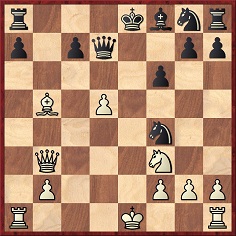
15 Qe3+ Kd8 16 Bxd7 Nxg2+ 17 Ke2 Nxe3 18 Bc6 Rb8 19 fxe3 Rxb2+ 20 Kd3 Bc5 21 Rhb1 Rxb1 22 Rxb1 Bb6 23 Nd4 Ke7 24 Ne6 g6 25 e4 Nh6 26 h3 Nf7 27 Kc4 Ne5+ 28 Kb5 a6+ 29 Kxa6 Nxc6 30 dxc6 Kxe6 ‘and Black won’.
Source: American Chess Bulletin, December 1906, page 242.
(1746)
C.N. 1810 introduced the complex matter of the origins of the title ‘grandmaster’. See Chess Grandmasters.
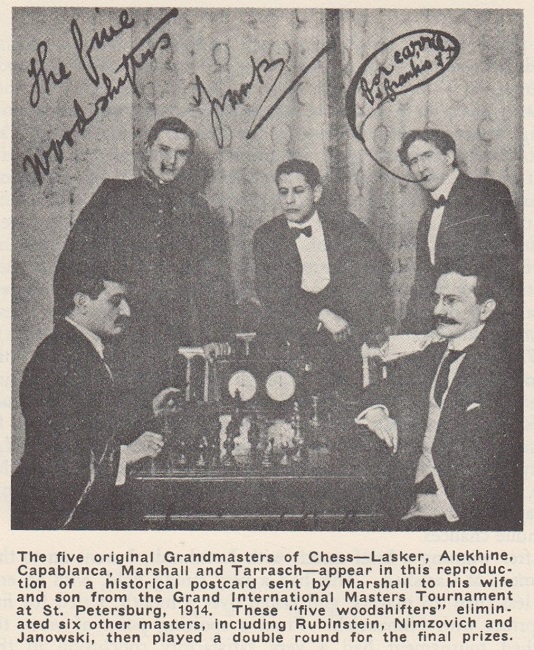
The scores of speed games from yesteryear are scarce, but the American Chess Bulletin of April 1918 (page 78) published one between Marshall and Janowsky, played at 20 seconds per move:
Frank James Marshall – Dawid Janowsky
New York, 1918
Queen’s Pawn Game
(1848)
An energetic display by Marshall which has not made it into the anthologies:
Frank James Marshall – Nathan Halper
New York (Marshall Chess Club Championship), 1941
Scotch Gambit
1 e4 e5 2 Nf3 Nc6 3 d4 exd4 4 c3 dxc3 5 Bc4 d6 6 Qb3 Qd7 7 Qxc3 d5 8 exd5 Bb4 9 dxc6 Bxc3+ 10 Nxc3 bxc6 11 O-O Ne7 12 Bxf7+ Kf8 13 Bb3 Bb7 14 Be3 Nf5 15 Bc5+ Nd6 16 Nd4 Re8 17 Rfe1 h5 18 Ne6+ Rxe6 19 Bxe6 Qd8 20 Re5 Rh6 21 Rae1 Bc8 22 Bb3 Bd7 23 Be3 Nf5 24 Bxh6 gxh6 25 Ne4 Kg7 26 Nc5 Kf6 27 Nxd7+ Qxd7 28 Be6 Resigns.
Source: American Chess Bulletin, January-February 1941, page 16.
(1901)
All reference books claim that Frank J. Marshall died in 1944, but the consensus has now been broken by Raymond Keene in The Complete Book of Gambits. Page 81 has a game which is headed ‘Lewitzky-Marshall, Breslau 1991’, and page 184 presents ‘Marshall-Duras, San Sebastian 1991’.
(1944)
On page 10 of the November 1992 Chess Life A. Soltis said that Pillsbury’s last published game was against Marshall in 1904. Not so. C.N. 1673 gave the score of Pillsbury v Edward Hymes, Philadelphia, May 1905, which had been printed in the New Orleans Times-Democrat of 18 June 1905 and the June 1905 AmericanChess Bulletin (page 226). Mr Soltis was therefore also wrong to suggest on page 50 of his 1990 book on Pillsbury, written with Ken Smith, that the Hymes game ‘has apparently been lost’.
(1954)
Further to Marshall’s ‘Gold Coins’ Game and The Fox Enigma, here is an example of such a queen sacrifice (with, however, a pin on the black f-pawn):
Frank James Marshall (blindfold) – Allies
Kingston, N.Y., 15-16 November 1914
Centre Gambit
1 e4 e5 2 d4 d6 3 Nf3 Ne7 4 dxe5 Bg4 5 Bc4 Nbc6 6 Nc3 Nxe5 7 Nxe5 dxe5 8 Qxg4 Ng6 9 Be3 Bd6 10 O-O-O O-O
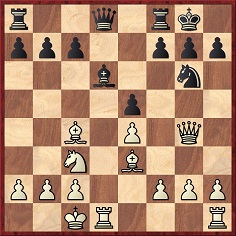
11 Qxg6 hxg6 12 h4 a6 13 h5 gxh5 14 Rxh5 g6 15 Rh6 Kg7 16 Rdh1 Kf6 17 Nd5+ Ke6 18 Nb6+ Ke7 19 Bg5+ f6 20 Rh7+ Ke8 21 Bh6 cxb6 22 Bxf8 Bxf8 23 Bf7+ Kd7 24 Rd1+ Bd6 25 Bd5+ Ke8 26 Bxb7 Rb8 27 Rh8+ Kd7 28 Rxd8+ Rxd8 29 Bxa6 Kc7 30 Bb5 Rh8 31 f3 Rh2 32 Bf1 f5 33 exf5 gxf5 34 Kd2 Rh4 35 c3 Rh8 36 b4 Rd8 37 Kc2 f4 38 a4 Ra8 39 Bb5 Rg8 40 Rd2 Rc8 41Kd3 Kb7 42 Ke4 Rxc3 43 Rxd6 Black resigns.
The allies were: Sam Bernstein, John D. Kline, Emanuel Metzger, F.H. Sanford, Charles Reynolds and M. Schlessinger.
Source: American Chess Bulletin, December 1914, page 258, which quotes the Kingston Daily Freeman:
‘This was one of the most thrilling games of its kind ever played, because Mr Marshall relaxed his attention for a moment and on his eleventh move made the error of giving up his queen for a knight. This error would have meant defeat for any ordinary player, even when able to see the board, and the fact that Mr Marshall nevertheless won is amazing.’
(2022)
When was the O’Kelly Variation in the Sicilian Defence (1 e4 c5 Nf3 a6) first played? An early instance is A.J. Souweine v F.J. Marshall, Manhattan Chess Club Championship 1905 (?). Black won in 33 moves.
Source: American Chess Bulletin, January 1906, page 15.
(2023)
In early 1994 McFarland & Company, Inc. published Frank Marshall, United States Chess Champion by A. Soltis, a 383-page hardback, complete with 14 photographs, subtitled ‘A Biography with 220 Games’. The overall appearance is beautiful (no chess publisher rivals McFarland’s production standards), yet there are many unsightly factual mistakes and typographical errors (the latter particularly in the index). Although fluently written, the volume also suffers from the author’s rather romantic and anecdotal approach to chess history, information often being provided without any precise source. On the other hand, the presentation certainly achieves a skilful balance between known and unknown games/facts, and the author makes good use of Marshall’s hitherto unpublished archives. It is probably Soltis’s best historical work to date and, despite its weaknesses, offers much of interest.
(2041)
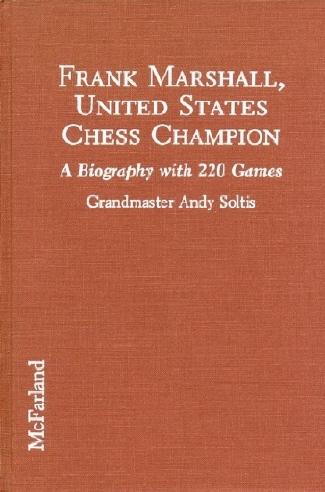
John Hilbert (Amherst, NY, USA) comments on the first chapter (pages 1-13) of Frank Marshall, United States Chess Champion by A. Soltis (Jefferson, 1994):
‘My knowledge of Frank Marshall’s chess career involves only his earliest playing days, between 1893 and 1900, and I therefore limit my remarks to the few pages by Soltis in which he covers that period. Corroboration of the various points can be found in my own book Young Marshall (Olomouc, 2002).
1. On page 3 Soltis quotes Marshall’s statement in “unpublished notes” that he “won Montreal Chess Club Championship at age 15”. Soltis accepts the truth of this, since on page 6 he writes, “Besides winning the Montreal club championship …” In fact, Marshall never won the Montreal Chess Club Championship. He played in the first Montreal Chess Club Championship (1893), finishing third behind J.P. Cooke and D.C. Robertson, and in a handicap tournament which was not for the club title. He finished sixth in the 1894-95 handicap event. There is no evidence that he played in any other Montreal Chess Club Championships.
2. “Pollock (1859-1896) spent the last four years of his life in Montreal …” (page 4).
Sources, including Pollock Memories, show that Pollock lived in Montreal for just under two and a half years.
3. “It was at the Manhattan C.C. that Marshall played his first serious match, with Vladimir Sournin …” (page 7).
Marshall’s first known serious match was for the New York State Junior Championship at Ontario Beach, New York in July 1896, which he just managed to win against Louis Karpinski. Marshall’s second and more significant match was against William Ewart Napier at the Brooklyn Chess Club from 8 October to 7 November 1896. Napier crushed Marshall +7 –1 =3. Soltis does not mention either of these matches. In the match table on page 367 the Sournin match is dated 1896 instead of 1897.
4. “Solomon Lipschütz” (page 8).
I am unaware of any conclusive evidence regarding Lipschütz’s first name. Gaige in Chess Personalia gives Sámuel, Simon and Solomon as versions found in multiple sources. The index of Soltis’ book (page 377) has the misspelling “Lischütz”.
5. “Marshall also encountered some illustrious foreigners, such as Emanuel Lasker, the German-born world champion who was then living in New York” (page 8).
Although dates are not given, the context for this comment concerns Marshall’s first years in New York, i.e. approximately 1895-1900. I know of no evidence that Lasker visited the United States between 1895 and 1900, let alone lived there during that period.
6. “Marshall’s principal young rivals were Hermann Helms, Napier and Albert W. Fox …” (page 8).
Helms was seven years older than Marshall. Albert Fox, about whom I have done considerable research, does not appear to have had a game published in the United States prior to 1900, and I am aware of no games between Marshall and Fox until 1904. In 1900 Fox was a teenager living in Europe, and his earliest published games played in the United States are from 1901.
7. “In 1899 he lost a Brooklyn Chess Club Championship match, 2-1, to Napier …” (page 8).
Marshall and Napier did contest a short play-off match following a Brooklyn Chess Club championship tournament. The final result was indeed 2-1. The year was 1898, not 1899. Marshall, not Napier, won.
8. “Marshall’s notes say he won the New York State Junior Championship in 1897 in a match” (page 8).
The match against Karpinski was, as I mentioned above, played in 1896, and not in 1897. Marshall was no better at remembering what events occurred in which years, in his own past, than he was at spelling.
9. “In his later writing Marshall also referred to a match with Fox but without giving a date. It is likely it was played about this time. Two games survive …” (page 8). Soltis gives Fox v Marshall, “circa 1897”, 0-1 in 16 moves (page 9).
It is unclear why Soltis should consider that the facts about the match between Marshall and Fox are uncertain. A photograph of the two players in their 1906 match at the Manhattan Chess Club appeared on page 24 of the February 1906 American Chess Bulletin. The 16-move game given by Soltis was on page 25 of the same issue, and was identified as the first match-game. Game two also appeared on that page, while the remaining four match-games (Marshall won +5 –0 =1) were published on page 95 of the May 1906 Bulletin. Thus, it is clear when the match was played and what the result was. All six games survive, having been published in the most common source for American chess during that period.
10. The Soltis book omits mention of a number of other significant events involving Marshall, including the Brooklyn Chess Club Championship of 1898 (although there is the faulty reference to Marshall losing 2-1 to Napier in 1899, when no club championship was held) and his drawn match against Jasnogrodsky in 1898. In 1900 Marshall won matches against Medinus, Delmar and Roething, but Soltis makes no mention of any of them.
I make no comment on the rest of Soltis’ book, i.e. after 1900. I would hope that it is more accurate and thorough, as Marshall had by then become a better known figure.’
(4738)
Tony Gillam (Nottingham, England) has just had occasion to read pages 226-230 of Frank Marshall, United States Chess Champion by A. Soltis, regarding Mannheim, 1914. He comments:
‘Page 226: “the Austrian Archduke Francis Ferdinand was assassinated in late June 1914 ...” Franz Ferdinand (not “Francis”).
Page 229: “On Friday, 31 July, Marshall played what proved to be his last game in Europe for more than a decade. Fittingly, it was a victory against Janowsky, a 62-move Slav Defence.” On Friday, 31 July Marshall lost to Spielmann, a game and date which Soltis gave on the previous page. Marshall beat Janowsky in Round 11 (the last played) on Saturday, 1 August.
Page 230: “Ossip Bernstein did not play competitively for 18 years after St Petersburg [1914].” He played in a tournament at Le Pont in 1930.
Page 230: “Géza Maróczy had withdrawn even before the war, playing no public games between 1909 and a simultaneous exhibition in 1917.” Were San Sebastián, 1911 and his two tournaments in Budapest in 1912 played in private?”
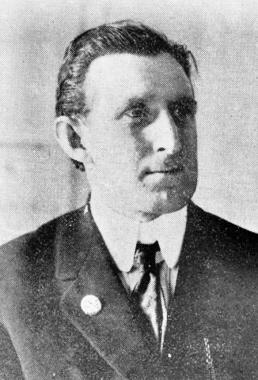
Frank James Marshall
We also note that on page 229 Soltis related Marshall’s reaction to the sound of gunfire in Mannheim ‘according to La Stratégie’. In reality, the French magazine (page 399 of the November 1914 issue) was expressing scepticism about the veracity of the claims in question, which had been published in Dutch outlets (De Telegraaf of 17 August 1914 and the August and September 1914 issues of Tijdschrift van den Nederlandschen Schaakbond).
The plates section of Frank Marshall, United States Chess Champion has a group photograph of Mannheim, 1914. It is dated 1924.
In C.N. 4738 John Hilbert catalogued many mistakes on pages 1-13 of Soltis’s book, which – appalling to relate – won the 1994 ‘Book of the Year’ award of the British Chess Federation. Page 666 of the December 1994 BCM named the judges as Ray Edwards and John Littlewood.
(6266)
McFarland & Company, Inc. is often said to produce the finest chess books, and the company’s catalogue certainly has many very good volumes, including a few of superb quality. Such is the company’s reputation that some reviewers tend to give an unthinkingly warm welcome to any new McFarland title, but blanket praise does a disservice to a truly exceptional book such as Aron Nimzowitsch On the Road to Chess Mastery, 1886-1924 by Per Skjoldager and Jørn Erik Nielsen and is far too generous to, for instance, Isaac Kashdan, American Chess Grandmaster by Peter P. Lahde.
In this sense, McFarland books may serve as a test of the book reviewer’s knowledge, judgement and reliability. If he writes that William Steinitz, Chess Champion by Kurt Landsberger is a dependable work of scholarship, alarm bells should ring.
As mentioned in C.N. 6266, the 1994 ‘Book of the Year’ prize from the British Chess Federation went to another handsome McFarland hardback, Frank Marshall, United States Chess Champion by Andrew Soltis, the judges being two non-historians, Raymond Edwards and John Littlewood. C.N. items have reported in detail on many of the book’s deficiencies; see, for instance, the remarks of two correspondents in C.N.s 4738 and 6266. To mention another example, in C.N. 2798 (an item also given on page 227 of Chess Facts and Fables) we quoted from an entry in the bibliography on page 371 of the Marshall book:
‘LeLionnais, Francois. Les Preix de Beatue aux Echecs. Payot. Paris 1970.’
Our comment was that ‘a proof-reader, had there been one, would have made four or five corrections to that single line’. The hypothetical correcteur would also have had his work cut out with the index, which has such entries as Clintrón, Lischütz, Jacque Mieses, Nimzovic, O’Briend, Rey Arduid, Carlose Torre, and Voight.
There has probably never been a chess book wholly free of error, but it is a question of degree and of whether the author, whatever his lapses, shows signs of caring. When McFarland brought out a paperback edition of the Marshall volume in 2013, no such signs were in evidence. All the faulty index entries mentioned above were left uncorrected, as were virtually all the historical mistakes pointed out in C.N. over the years.
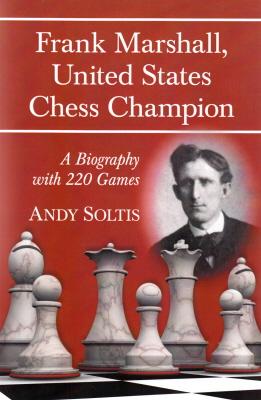
C.N. 2062 (see page 77 of Kings, Commoners and Knaves) gave a Marshall v Whitaker game from page 165 of the July 1911 American Chess Bulletin:
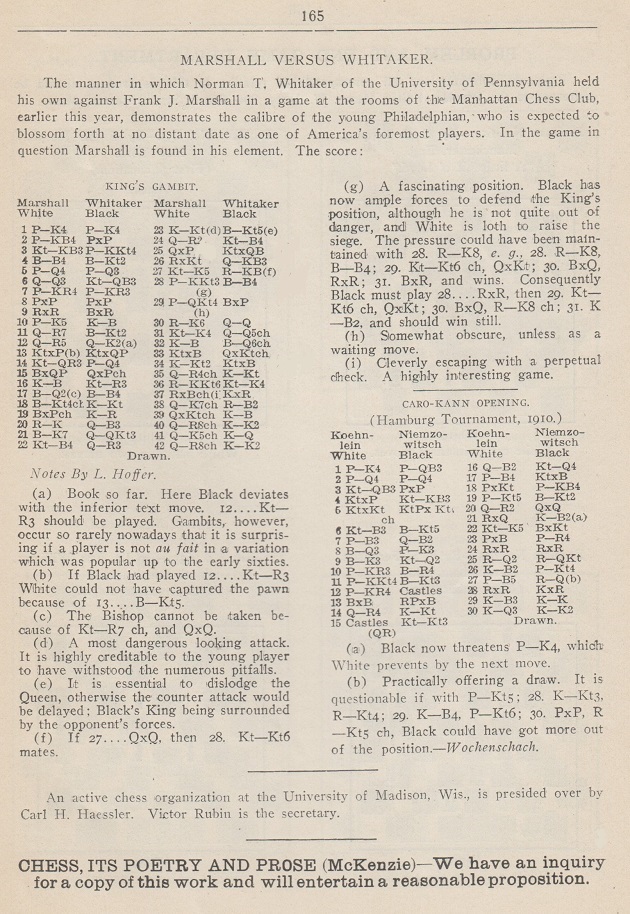
1 e4 e5 2 f4 exf4 3 Nf3 g5 4 Bc4 Bg7 5 d4 d6 6 Qd3 Nc6 7 h4 h6 8 hxg5 hxg5 9 Rxh8 Bxh8 10 e5 Kf8 11 Qh7 Bg7 12 Qh5 Qe7 13 Nxg5 Nxd4 14 Na3 d5 15 Bxd5 Qxe5+ 16 Kf1 Nh6 17 Bd2 Bf5 18 Bb4+ Kg8 19 Bxf7+ Kh8 20 Re1 Qf6 21 Be7 Qb6 22 Nc4 Qa6 23 Kg1 Bg4 24 Qh2 Nf5 25 Qxf4 Nxe7 26 Rxe7 Qf6 27 Ne5 Rf8 28 g3 Bf5 29 b4 Bxc2 30 Re6 Qd8 31 Ne4 Qd4+ 32 Kf1 Bd3+ 33 Nxd3 Qxd3+ 34 Kg2 Nxf7 35 Qh4+ Kg8 36 Rg6 Ne5 37 Rxg7+ Kxg7 38 Qe7+ Rf7 39 Qxe5+ Kf8 40 Qh8+ Ke7 41 Qe5+ Kd8 42 Qh8+ Ke7 Drawn.
The introduction stated that the game was played ‘earlier this year’, and we duly gave the date 1911, as did John Hilbert in his monograph on Whitaker (see pages 37, 324 and 350).
On page 502 of the December 1969 Chess Life & Review Whitaker put 1910:
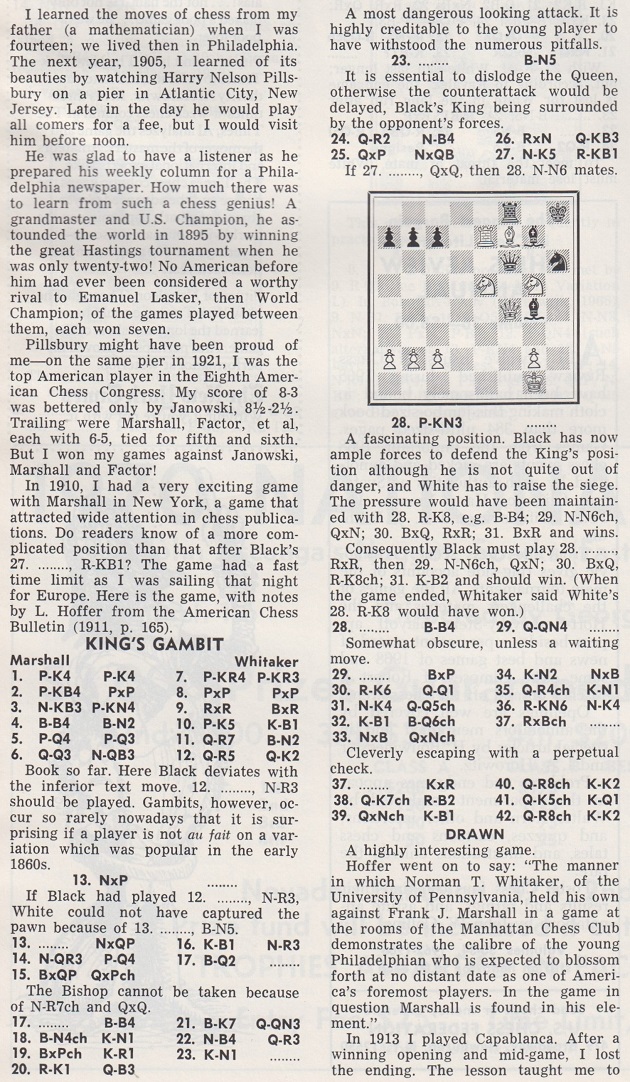
In reality, the game was played in 1909:

Brooklyn Daily Eagle (Sports Section), 28 August 1909, page 5
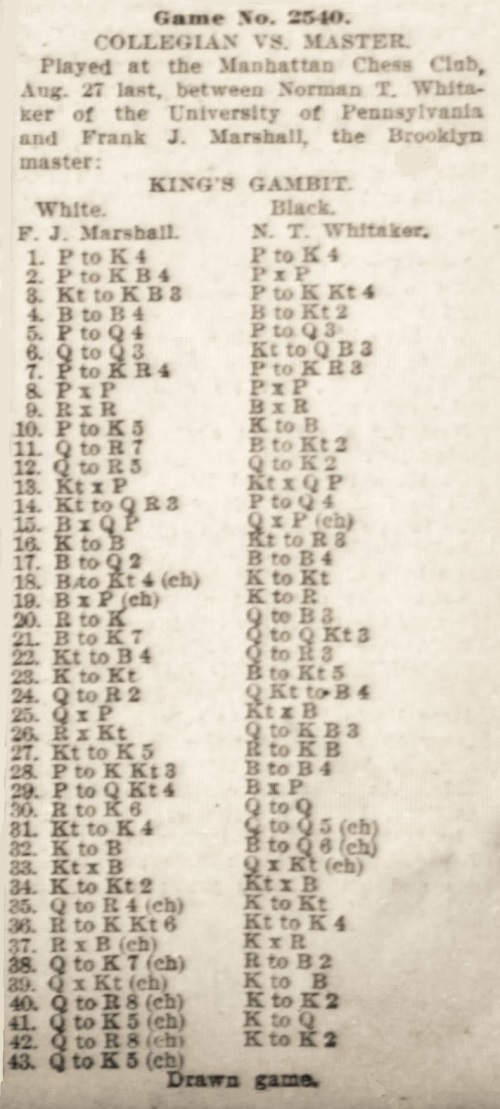
Times-Democrat, 19 September 1909, page 9.
Both newspapers gave one further move, 43 Qe5+.
In C.N. 2117 Richard Forster (Zurich) referred to the position which arose after White’s 25th move in Réti v Marshall, New York, 1924 (see pages 165-166 of the English-language tournament book, published in 1925):
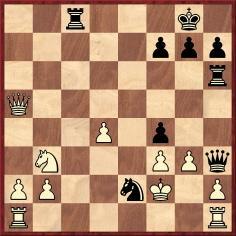
Play went 25...Nxg3 26 Rhg1, and Alekhine wrote: ‘Or 26 hxg3 Qxg3+ 27 Ke2 Qg2+ 28 Kd3 Rxh1 29 Rxh1 Qxf3+, to be followed by 30...Qxh1, with an easy win.’ Instead, there is 28...Qc2 mate.
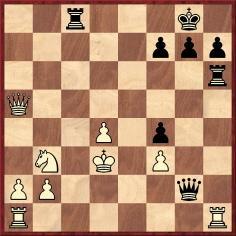
Analysis by Alekhine (position after 28 Kd3)
On page 33 of his 1929 book Schachmethodik Tartakower also ignored the mate, as did Soltis on page 270 of Frank Marshall, United States Chess Champion.
C.N. 2131 remarked that in the original 1925 edition of Alekhine’s tournament book W.H. Watts gave a nine-page errata supplement which mentioned (on page vi) 28...Qc2 mate, and when discussing the matter further on pages 283-284 of Kings, Commoners and Knaves we drew attention to some complications. Here is the complete game-score as it appeared in the tournament book (English and German editions):
Richard Réti – Frank James Marshall
New York, 6 April 1924
Queen’s Gambit Declined
1 Nf3 Nf6 2 c4 d5 3 cxd5 Nxd5 4 d4 Bf5 5 Nc3 e6 6 Qb3 Nc6 7 e4 Nxc3 8 exf5 Nd5 9 Bb5 Bb4+ 10 Bd2 Bxd2+ 11 Nxd2 exf5 12 Bxc6+ bxc6 13 O-O O-O 14 Qa4 Rb8 15 Nb3 Rb6 16 Qxa7 Qg5 17 Qa5 c5
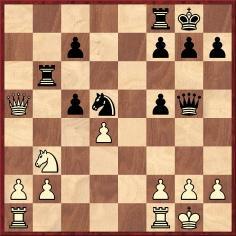
18 Qxc5 Nf4 19 g3 Rh6 20 Qxc7 Ne2+ 21 Kg2 Qg4 22 Rh1 f4 23 f3 Qh3+ 24 Kf2 Rc8 25 Qa5 Nxg3 26 Rhg1 Qxh2+ 27 Rg2 Qh4 28 Rc1 Re8 29 Qb5 Ne4+ 30 Kf1 Qh1+ 31 White resigns.
However, we observed, when Réti annotated the game on pages 259-260 of the September 1924 Wiener Schachzeitung he gave White’s 18th move as 18 dxc5. If that were correct, Alekhine would have missed no mate later in the game. Hanon Russell (Milford, CT, USA), who possessed the original score-sheets of both Réti and Marshall, informed us that they respectively gave White’s 18th move as ‘Dxc5’ and ‘QxP’. A later transcription error in the German notation would have been easily made (i.e. ‘Dxc5’ becoming ‘dxc5’).
On page 126 of Das New Yorker Schachturnier 1927 (Berlin, 1928) Alekhine wrote regarding the communication of game-scores by telegraph:
‘But in general more accurate wire information for the foreign press should be provided during American tournaments. In 1924, for example, a similar error resulted in a wholly incorrect judgment of Marshall’s win against Réti.’
Here, a further point in this complex affair may be added. In 1924 Alekhine also annotated the game in Le Pion (Montreal); see pages 116-117 of the May 1924 issue of La Stratégie. He gave White’s 18th move as Qxc5, and at move 26 merely wrote, ‘If 26 hxg3 Qxg3+ 27 Ke2 Qg2+, winning easily’.
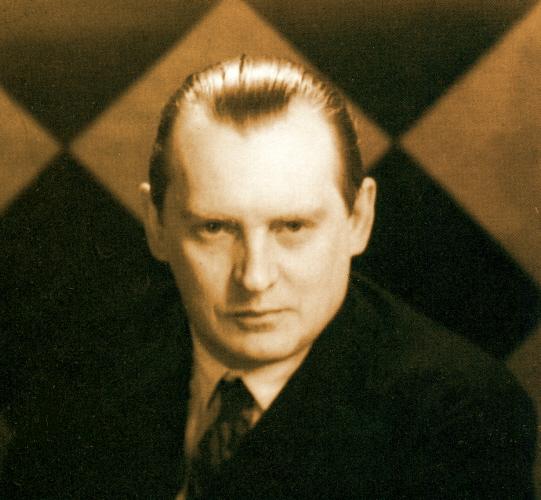
Alexander Alekhine
A strange article appeared on page 169 of the June 1918 BCM concerning a little-known line in the Queen’s Gambit Declined. It was reported that during a recent lecture at the Mercantile Library in Philadelphia Marshall had improvised ‘the following remarkable game’:
1 d4 d5 2 Nf3 c5 3 c4 e6 4 Nc3 Nf6 5 cxd5 exd5 6 g3 cxd4 (‘This move, introduced by Marshall, if not properly answered, yields Black a good game.’) 7 Nxd4 Nc6 8 Nxc6 bxc6 9 Bg2 Bc5 10 O-O O-O 11 Bg5 h6 12 Bxf6 Qxf6
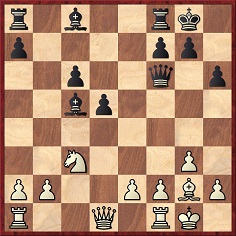
13 Nxd5 cxd5 14 Qxd5 Bxf2+ 15 Rxf2 Qxb2 16 Rxf7 Rxf7 17 Rf1 Qb6+, and here the article ends rather mysteriously with the question ‘And what is the verdict?’
Wanted: more information about this line.
(2163)
It may now be recorded that the game between O. Důras (simultaneous) and F. Lapka at Pisek on 31 August 1912 opened with exactly the same moves. Play continued with 18 Kh1 Qc7 19 Qxa8 Rxf1+ 20 Bxf1, and White won at move 33. The game was given on pages 14-15 of the January 1913 Deutsche Schachzeitung, as well as on page 152 of J. Kalendovský’s monograph on Důras (published by The Chess Player in 1997). For the venue the German magazine gave the incorrect translation Pilsen (which is another place, Plzeň).
(2333)
The moves also occurred in the game Marshall v Důras, Budapest, 1912.
An example of how Marshall liked to shock his opponents:
John R. Orton – Frank James Marshall
Montreal, date?
Queen’s Gambit Declined
1 d4 d5 2 c4 e6 3 Nc3 c5 4 e3 Nc6 5 Nf3 Nf6 6 a3 cxd4 7 exd4 dxc4 8 Bxc4 Be7 9 Be3 O-O 10 O-O a6 11 Qc2 b5 12 Bd3 Bb7 13 Rfd1 Rc8 14 d5 exd5 15 Nxd5
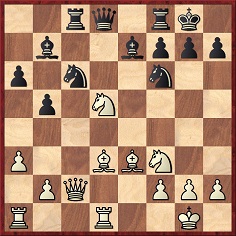
15…Qxd5 (‘Done, no doubt, in a spirit of adventure, which at all times moves the United States champion to place his head in the lion’s mouth. By rights the jaws should have snapped upon him, but he escaped by the skin of his own teeth. Instead of the text, he should have played 15…Nxd5.’) 16 Bxh7+ Nxh7 17 Rxd5 Nb4 18 Qxc8 Rxc8 19 Rd7 Bxf3 20 axb4 Bxb4 21 gxf3 Nf6 22 Ra7 a5 23 Rb7 Rc2 24 Rb1 Nd5 25 Rxb5 Nxe3 26 fxe3 Re2 27 e4 Bd2 28 h3 f6 29 Rf1 Kh7 Drawn.
Source: American Chess Bulletin, February 1920, page 35.
(2256)
A forgotten position from a game between Marshall and the composer Kubbel:
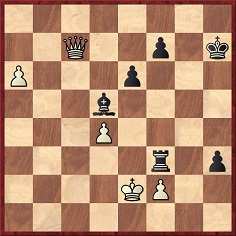
Black to move
F.J. Marshall (simultaneous) v K.A.L. Kubbel, Gatchina, 11 May 1914
Pages 304-305 of the October 1914 Deutsche Schachzeitung gave an account based on Kubbel’s own annotations in the St Petersburger Herold and summarized here. Eschewing the clear draw with 47…Kg6 and 48…Ra3, Black sought complications through 47...Rf5 48 a7 e5 49 Qd7 (‘49 Qe7 also came into consideration.’) 49…Bf3+ 50 Kd2 (‘Instead of this 50 Ke3 would have been stronger. After 50…exd4+ White cannot capture with the king since he would lose both his queens by 51 Kxd4 Rd5+ 52 Qxd5 Bxd5 53 Kxd5 h2 54 a8(Q) h1(Q)+, but after 51 Qxd4 Black’s situation would be much worse. For example, 51…Bg2 then loses at once to 52 Qd3 Kg6 53 f3.’) 50…Kg6 51 d5 h2 52 a8(Q) h1(Q) 53 Qg8+ Kh6 54 Qh8+ (‘If 54 Qd6+ then 54…Kh5! However, after 54 Qxf5 Black draws with 54…Qd1+, followed by 55…Qd4+ and 56…Be4+ or 56…Bxd5+. Amusing!’) 54…Kg6 (‘Naturally not 54…Kg5 owing to 55 Qg7+.’) 55 Qd6+ f6 56 Qg8+ Kh5! 57 Qh7+
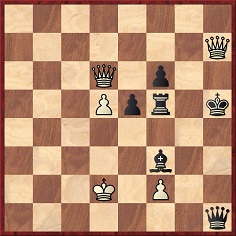
(‘An original position. Despite his two queens, White cannot win. The black king slips away from all danger like an eel, and White finally has nothing left but to exchange.’) 57…Kg5 58 Qxh1 Bxh1 59 Qc5 Bxd5 60 Qxd5 Rxf2+ 61 Ke3 Rf4 Drawn.
And yet our little CD-ROM Jeux d’échecs shows that White had a forced mate in five with 55 Qc6+ f6 56 Qce8+ Kg5 57 Qhg8+ Kf4 58 Qa4+ e4 59 Qg3 mate.
(2198)
‘… I have always been an erratic player, even when I was at my best. At that time, when Marshall and myself entered a tournament, the general opinion was that we could as well finish at the top as at the tail of it.’
Jacques Mieses, BCM, October 1944, page 232.
(2486)
Although not a vintage Marshall win, the encounter below, played at the Marshall Chess Club and described as ‘a “hard skittles” game’, has historical interest because it took place in the final year of his life:
Frank James Marshall – Donald Henry Mugridge
New York, 1944
Sicilian Defence
1 e4 c5 2 b4 cxb4 3 a3 d5 4 exd5 Nf6 5 axb4 Nxd5 6 Nf3 Bg4 7 h3 Bxf3 8 Qxf3 Nc6 9 Ba3 e5 10 Bc4 Nf6 11 b5 e4 12 Qg3 Qd4
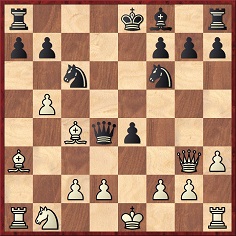
13 bxc6 Qxa1 14 O-O bxc6 15 Qb3 Bxa3 16 Bxf7+ Kf8 17 Nxa3 Qd4 18 Qb7 Rd8 19 Be6 Nd7 20 Qxc6 h5 21 Nb5 Qxd2 22 Bb3 Rh6 23 Qc4 Resigns.
Source: Chess Review, January 1965, page 15.
The same issue of the US magazine (pages 13-14) contained a condensed version of a talk about Marshall given by Mugridge at the Washington Chess Divan in 1945. Among some interesting observations was the following:
‘The endgame was not the field for which he is best known, yet it is a field in which Marshall was frequently a very distinguished performer. His most original contribution to chess practice, I think, was in the tactical handling of chess endings. Marshall did not need a board full of pieces to call forth his tactical ingenuity: he could exercise it with comparatively restricted material. You could simplify with Marshall, and still you were not safe from surprises.’
(2514)
A forgotten example of a Marshall surprise in the endgame:
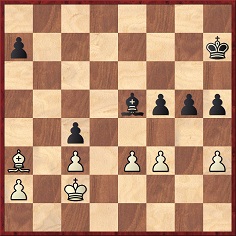
G.C.A. Oskam-F.J. Marshall, Rotterdam, 28 May 1906
Play continued: 39 Bc5 h4 40 f4
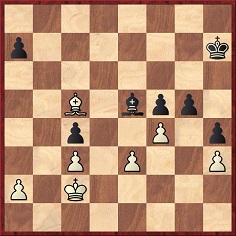
40…Bd6 41 Bxd6 g4 42 hxg4 h3 43 gxf5 h2 44 f6 h1(Q) 45 f7 Qe4+ 46 White resigns.
Source: Deutsches Wochenschach, 10 June 1906, pages 196-197.
(2523)
When this item was given on pages 180-181 of A Chess Omnibus the black pawn on a7 was incorrectly placed on g7.
Per Skjoldager (Fredericia, Denmark) provides the following report from the Rigasche Zeitung of 10 February 1912 (new style):
‘On 22 January 1912 the American chessmaster gave a simultaneous display in the Pernauer Schachklub (+22 –0 =1). On 25 January there followed an exhibition in the Rigaer Schachverein (+23 –2 =10). On 26 January Marshall played a serious game against the local master A. Ni[e]mzowitsch which ended in a draw after interesting play. On 27 January, in the Mitauer Schachklub, Marshall won all 18 games. On 28 January a small display was given in the Rigaer Börsen Café (+12 –2 =1).’
Our correspondent also supplies this game:
Frank James Marshall (simultaneous) – A. Grünlaub
Riga, 25 January 1912
Sicilian Defence
1 e4 c5 2 b4 e6 3 bxc5 Bxc5 4 d4 Bb6 5 c3 Ne7 6 Bd3 Nbc6 7 Qg4 h5 8 Qg3 Nxd4 9 Na3 Ndc6 10 Nb5 Ng6 11 Bg5 h4
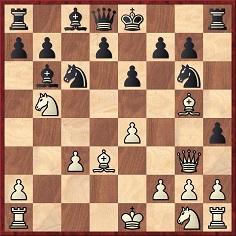
12 Bxd8 hxg3 13 Bxb6 Rxh2 14 Nc7+ Ke7 15 Nxa8 Rxh1 16 O-O-O axb6 17 fxg3 Nge5 18 Be2 Rh2 19 Nxb6 Na7 20 Nf3 Nxf3 21 Bxf3 Rh8 22 e5 Nc6 23 Bxc6 bxc6 24 c4 Kd8 25 c5 Rh5 26 Re1 f6 27 Kd2 Ba6 28 Re4 Rxe5 29 Rxe5 fxe5 30 Ke3 Kc7 31 Ke4 d6 32 Na8+ Kd7 33 Nb6+ Drawn.
Source: Rigasche Zeitung, 10 February 1912.
(2864)
C.N. 2514 quoted high praise of Frank Marshall’s endgame skill. A contrary view was voiced by E.G.R. Cordingley on page 109 of the Chess Students Quarterly, June 1947:
‘Marshall was never, contrary to the opinions expressed most often in his own country, among the world’s first three or four most accomplished living players, though he did gain one outstanding triumph and was both a very dangerous opponent to the best players and a potential winner in any tournament where there was a fair divergence in the abilities of the contending players. Again, he was definitely not a “master of the endgame”, as has been claimed; indeed, his technical skill was appreciably below that of the best during his years of practice, also well below his own marked talent for combinational play.’
On the other hand, Capablanca commented on page 8 of the New York Times, 13 February 1927:
‘In the endings, contrary to many people’s idea, Marshall is an A1 performer. To be truthful, he is no Dr Lasker or Rubinstein, when the latter is at his best, but only one or two of his competitors in the coming tournament [New York, 1927] will have the slightest advantage over him in this department of the game.’
(3072)
From page 210 of the November 1915 American Chess Bulletin:
‘At Marshall’s Chess Divan, Hudson Maxim’s new “War Game” is one of the attractions and frequently players can be seen trying their skill on the enlarged board and with the increased army of pieces made necessary by the addition of the flying machines. Kriegspiel, the German for war game, which had considerable vogue of late years in London, also serves to pass away many a pleasant hour.’
A photograph of Marshall and Maxim playing War Game is on page 22 of Marshall’s My Fifty Years of Chess. See also page 146 of Chess Explorations.
Another board game to which Marshall gave attention was Trench, invented by Abb Landis (1856-1927) of Nashville, Tennessee. It was described on page 119 of the May-June 1918 American Chess Bulletin:
‘The board (in our national colors) represents a battlefield with (red) “dug-outs” connected by “trenches” and protected by (white) “parapets”, which look out upon “No Man’s Land” (blue).
The 40 pieces represent officers and men of two infantry divisions. The insignia indicate rank; the numerals give values for scoring points by capture or exchange.
… Mr Landis claims that soldiers and those who want the excitement of military tactics and field operations can obtain perfect satisfaction in playing Trench as a war game …’
The same issue (page 136) contained a full-page advertisement for the game, with an illustration of the ‘men arranged in battle array’, while the June-August Bulletin gave information (on page 139) about Marshall’s interest in Trench, as well as (on page 172) the score of a game between Marshall and A.B. Hodges played at Marshall’s Chess Divan on 9 June 1918 and annotated by Landis.
(2602)
Marshall on Steinitz, from page 398 of Kings, Commoners and Knaves:
‘He was a very great player. He was wonderful, but too deep for any mortal power. He had to fail in the execution of such difficult plans as he followed. That is why he finally was defeated by the younger masters.’
Source: Lasker’s Chess Magazine, July 1906, page 126.
Napoleon was discussed at the end of an article by James Mortimer entitled ‘How to Win at Chess’ on page 9 of the Daily Mail, 6 October 1906:
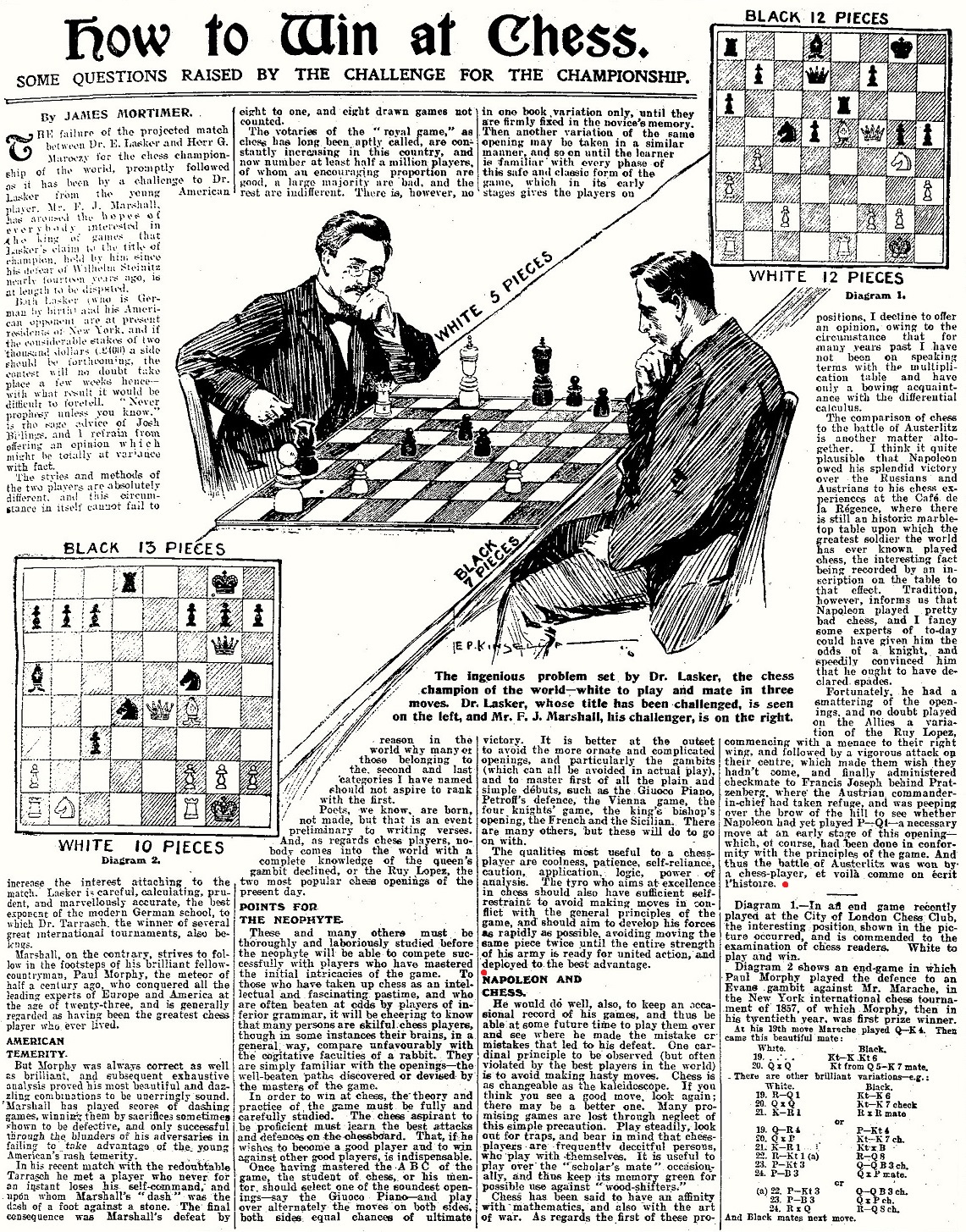
From Missed Mates:
The following position arose in R.J. Guckemus v F.J. Marshall, Sylvan Beach, August 1904:
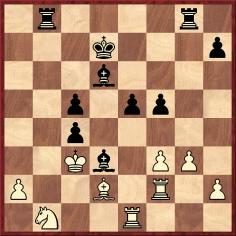
Source: American Chess Bulletin, September 1904, page 75. (If the score of this tournament game in various databases were to be believed, Black’s f-pawn would be at f6.) Marshall won by 27…Bxb1 28 Bc1 Bd3 29 Bb2 Bc7, after which White resigned, but there was a quiet mate in two beginning with 27…Bc7. A curiosity is that after 28 Rxe5 Black’s bishop can mate at either a5 or e5.
Publishing the next game on pages 280-281 of its September 1905 issue, the Deutsche Schachzeitung described the finish as ‘an original nine-move combination winning the enemy queen’.
Frank James Marshall – E. Pécher
Brussels, 22 May 1905
Danish Gambit
1 e4 e5 2 d4 exd4 3 c3 dxc3 4 Bc4 cxb2 5 Bxb2 Bb4+ 6 Nc3 Nc6 7 Nf3 Nf6 8 e5 Qe7 9 O-O Bxc3 10 exf6 Qxf6 11 Re1+ Kd8 12 Bxc3 Qxc3 13 Qd5 d6 14 Rac1 Qf6 15 Ng5 Be6 16 Nxe6+ fxe6 17 Rxe6 Qf4 18 Rce1 Rf8 19 Kh1 Kd7 20 Bd3 Rae8
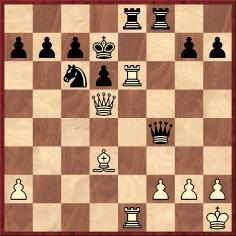
21 Rxe8 Rxe8 22 Bf5+ Kd8 23 Rxe8+ Kxe8 24 Qg8+ Ke7 25 Qxg7+ Ke8 26 Qg8+ Ke7 27 Qe6+ Kf8 28 Qf6+ Resigns.
(Kingpin, 1997)
In Kingpin in 1997 (see too page 285 of Kings, Commoners and Knaves) we gave the following Danish Gambit loss by Marshall against J.P. Hopkins in a simultaneous exhibition:
1 e4 e5 2 d4 exd4 3 c3 dxc3 4 Bc4 Nc6 5 Nf3 Nf6 6 O-O Be7 7 e5 Ng4 8 Qe2 d6 9 exd6 Qxd6 10 h3 Nd4
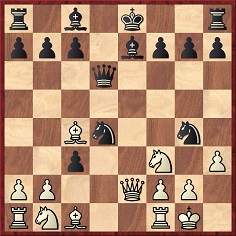
11 Nxd4 Qh2 mate.
We commented:
It is not recorded whether the spectators showered Marshall with anything.
Our source was page 201 of the June 1916 BCM, and the game was also given (‘New York, 1915’) in the ‘Chess Caviar’ column on page 71 of the March 1951 Chess Review. More detailed information is available on page *3 of the Brooklyn Daily Eagle, 13 April 1916:
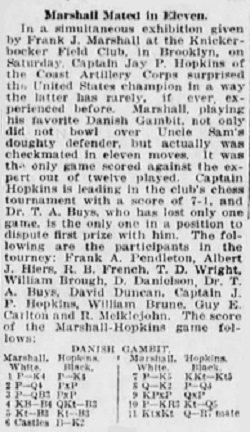
See also the feature article Black Plays ...Qh2 mate.
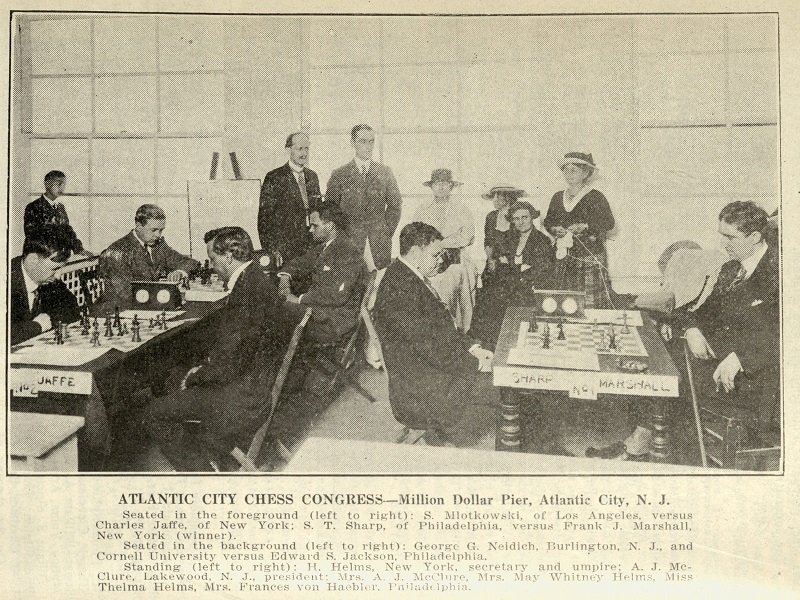
The above photograph (American Chess Bulletin, July-August 1920, page 120) was taken during the game F.J. Marshall v S. Sharp, Atlantic City, 19 July 1920.
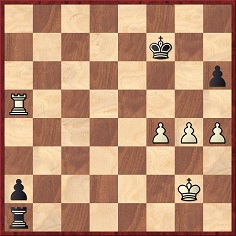
Position after 38...Kg7-f7
Neil Brennen (Norristown, PA) has pointed out to us that Marshall annotated the game (a) on pages 122-123 of the July-August 1920 American Chess Bulletin (where the conclusion is given as 39 Ra6 Kg7 40 g5 hxg5 41 hxg5 Kf7 42.f5 Resigns) and (b) on pages 164-165 of My Fifty Years of Chess (where the players’ 39th moves are missing). We note, moreover, that on page 247 of his book Frank Marshall, United States Chess Champion A. Soltis went further, suggesting that the game finished with White playing f5 at move 41 rather than 42.
(2797)
On pages xi-xiv of his book Chess Masterpieces (New York, 1928) Frank Marshall discussed various proposals for ‘eliminating the so-called hypermodern style’, the latter term ostensibly meaning for him ‘the tendency on the part of many of the grand masters to adopt an extremely close style of play, which involves a keen desire on the part of both players to avoid incurring the slightest risk’. Of the solutions available, Marshall was inclined to favour balloting:
‘The balloting for openings is of course an old plan in checkers or draughts, but I do not agree with those who think that if adopted in chess matches it would sooner or later lead to a large proportion of draws. In any event it should not be a great hardship for two players to have to play White and Black alternately in selected openings, and I am certain that the public would exhibit a lively interest in a contest where they were sure to see a large number of seldom-played openings which will give a welcome variety after the monotony of the Queen’s Pawn Game.’
(2877)
Following on from C.N. 2877, the following appeared as C.N. 2880:
From Tim Bogan (Chicago, IL, USA):‘Marshall's disparaging comment about “the monotony of the Queen’s Pawn Game” in C.N. 2877 struck me as slightly odd. Didn’t Marshall, when White, play 1 d4 about 90% of the time? (This percentage I gleaned from a very brief and cursory look at the 1,087 Marshall games contained in Chess Base’s Big Database 2002, triggered by the memory of reading when I was young that Marshall was known as a Queen’s Pawn player.)’
Marshall was indeed essentially a 1 d4 player, at least in tournament and match play. His comments in Chess Masterpieces were written in the immediate aftermath of the 1927 world championship match, and below is the paragraph preceding the one quoted in C.N. 2877:
‘Another feasible suggestion is that of balloting for openings. Of the 34 games played in the Capablanca-Alekhine match 32 were Queen’s Gambit Declined, one Queen’s Pawn and one French Defence. All the games were of the type termed “close” and as Mr Howell stated in the American Chess Bulletin in his interesting review of the championship match, “the match taught us very little with regard to the Queen’s Gambit Declined”.’
A few more quotations:
‘In my opinion there are only two really good opening moves, viz.: Pawn to King’s fourth and Pawn to Queen’s fourth.’
Source: Chess Openings by F.J. Marshall (Leeds, 1904), page 23.
And from the same book (page 25), at the start of the section on the Queen’s Gambit:
‘The attack and defence emanating from this classical opening produce some of the most beautiful chess it is possible to obtain. The Queen’s Gambit possesses the merit of being the soundest of all the openings.’
Finally, from the Introduction to Marshall’s Chess “Swindles” (New York, 1914):
‘Special prominence is given to the variations of the Queen’s Gambit, because that opening seems to have escaped the tender mercies of the theorists in chess libraries and received less space than its merits deserve, and also because the chess championship of the world, as fought for over the open board in the matches and tournaments of the past 20 years, has depended more upon a working knowledge of the Queen’s Gambit than of any other chess opening.’
Dale Brandreth has published a scrapbook entitled Chess Columns 1924 & 1925. Most of the items come from the Washington Post (column conducted by W.H. Mutchler) and the Brooklyn Daily Eagle (H. Helms). Not all of the reportage is of choice quality, and one of Mutchler’s columns (on page 6 of the scrapbook) even records:
‘When Philidor conducted three games sans voir, the populace of the fifteenth century entered it in the encyclopedias as miraculous.’
A number of unknown Torre scores are given, but we have picked, from the Brooklyn Daily Eagle of 25 December 1924 (page 63 of the scrapbook), two games from a thematic tournament in New York won by Marshall. (The outcome of the event was reported on page 52 of the March 1925 American Chess Bulletin.) Although by no means masterpieces, the games deserve a better fate than oblivion.
G. Gustafson – Frank James Marshall
New York, December 1924
Vienna Gambit
(Notes – unabridged … – by Marshall.)
1 e4 e5 2 Nc3 Nf6 3 f4 d5 4 fxe5 Nxe4 5 Nf3 Bc5 (‘Old, I believe, but apparently good.’) 6 d4 Bb4 7 Bd2 Bg4 8 Qe2 (‘Not good. Probably 8 Be2 was better.’) 8…Bxf3 9 gxf3 (‘Also, 8 Qxf3 Qh4+ 10 g3 Nxd2, with advantage.’) 9…Qh4+ 10 Kd1 Nf2+ 11 Kc1 Bxc3 12 bxc3 Nxh1 13 Qb5+ Nd7 14 Qxd5 Nb6 15 Bb5+ c6 16 Bxc6+ bxc6 17 Qxc6+ Kf8 18 c4 Qxd4 19 Bb4+ Kg8 20 Qd6 Qxa1+ 21 Kd2 Nxc4+ 22 White resigns.
C.E. Norwood – Erling Tholfsen
New York, December 1924
Vienna Gambit
1 e4 e5 2 Nc3 Nf6 3 f4 d5 4 fxe5 Nxe4 5 Nf3 Bg4 6 Be2 Be7 7 O-O O-O 8 Qe1 Nc6 9 Bd1 f5 10 Ne2 Nc5 11 d4 Ne6 12 Be3 f4 13 Bf2 Bf5 14 Kh1 Kh8 15 Qd2 g5 16 h3 Be4 17 c3 Qe8 18 Nh2 Qg6 19 Ng1 Rf7 20 Bf3 h5 21 Rfe1
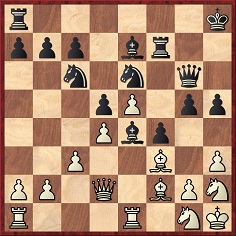
21…g4 22 hxg4 hxg4 23 Bxg4 Rh7 24 Qd1 Rg8 25 Rxe4 dxe4 26 Nh3 Bh4 27 Qe2 Bxf2 28 Qxf2 Ne7 29 Bxe6 Qxe6 30 Nxf4 Qh6 31 Nh3 Rf8 32 Qe1 Qg6 33 Qd2 Rg7 34 Rf1 Nf5 35 Kg1 Qg3 36 Kh1 Qg6 (Here and at move 38 Black had an immediate win with …Qxh3.) 37 Kg1 Qg3 38 Kh1 Qg6 39 Kg1 Rfg8 40 g4 Qh7 41 Rxf5 Qxf5 42 Qh6+ Rh7 43 Qf4 Qxf4 44 Nxf4 e3 45 Nd5 Rxh2 46 Nxe3 Re2 47 Nd5 Rxb2 48 Nf6 Rg6 49 d5 Rxf6 50 exf6 Rxa2 51 g5 Ra4 52 White resigns.
(2996)
The text below appeared on page 21 of the February 1922 American Chess Bulletin:
‘Leaving behind in the race the cities of Portland, Washington, Philadelphia and Buffalo, all of which held the record in turn, Montreal has stepped to the front as the foster mother of Frank J. Marshall’s greatest achievement in the line of simultaneous playing. Without any blare of trumpets and, in fact, with no advance notices whatsoever, so far as Marshall’s home town of New York was concerned, the United States champion quietly repaired to the Canadian Metropolis and, on 7 January, at the National Athletic Club, took on the astounding total of 155 opponents.
In seven hours and 50 minutes Marshall had completed his truly Herculean task with a score of 126 wins, 21 draws and only eight losses. The greatest number that had faced Marshall before at any one time was 144 at Buffalo, and previous to that it was 129 at Philadelphia and, before that, 105 at Washington, which had superseded Portland with 95.’
High figures have also been claimed for Schlechter and Bernstein (Chess Amateur, October 1907, page 5) and Abonyi (American Chess Bulletin, February 1931, page 33), but no particulars have yet been found. Indeed, establishing incontrovertible facts on any aspect of this topic is fraught with difficulties.
(3375)
See Large Simultaneous Displays.
CHESS, 14 January 1938, page 155 featured two photographs of Frank Marshall in play against Kurt Lüdecke, with the following explanation:
‘Frank Marshall and Kurt G.W. Lüdecke started a game on 31 July 1914, the photograph on the left being taken in the course of the game. The War broke out and Marshall had to make an expeditious getaway to Holland, England and home. On 1 December 1937 the game was resumed and concluded. In the meantime Marshall had held the US Championship for some two decades and his opponent had written the sensational book I Knew Hitler, published last year.’
(3449)
A rather different version of the Marshall v Lüdecke story was given on page 114 of the November-December 1937 American Chess Bulletin:
‘A game begun by Frank J. Marshall and Kurt G.W. Lüdecke, author of I Knew Hitler, at Mannheim two days before the world war broke out, was reproduced from a photograph when they met again the other day, after 23 years, at the Hotel Shelton in New York. Failing to recall whose move it was, they did not finish it. Instead they contested three rapid transit games, Marshall winning two and drawing one.’
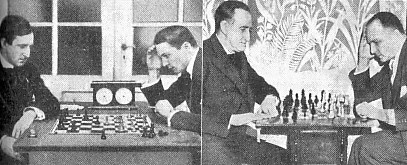
I Knew Hitler was subtitled ‘The Story of a Nazi Who Escaped The Blood Purge’. On pages 29-30 of the London, 1938 edition Lüdecke wrote:
‘One reason I think I was never a gambler at heart is that I can lay claim to the quality of patience – even the profound patience required of a chessplayer. Chess was an obsession with me. I can still spend hour after hour over the board, unconscious of the world around me.
On an evening at the Café Continental [in Paris], however, my concentration was broken into by the raucous cry of a newsboy. I was about to spring the decisive move in an intricate mate combination, and I bought the boy’s paper so that I could send him on his way. As I put it to one side, the headline caught my eye.
It announced the assassination of Archduke Ferdinand in Sarajevo. “C’est la guerre”, I said in thoughtless prophecy, and turned again to a matter of importance. I moved a pawn. “Check!”
... In July we motored to Heidelberg, following the lure of an international chess tourney at nearby Mannheim. There the war burst upon us.’
A player named Lüdecke was mentioned on page 58 of the February 1910 Deutsche Schachzeitung as having participated in a team match between Kiel and Bremen in Altona on 9 January that year, but there would seem only a slight chance that it was Kurt G.W. Lüdecke.
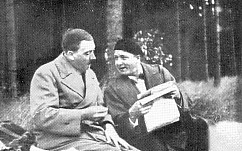
Adolf Hitler and Kurt Lüdecke
(3453)
Richard Forster (Winterthur, Switzerland) has found this cutting, from an unidentified journal:
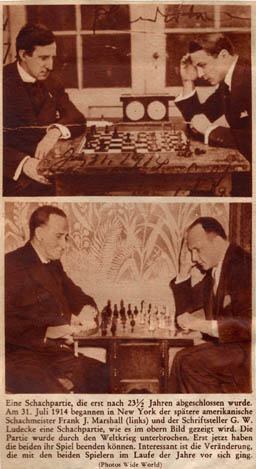
Below we add a further picture of Kurt Lüdecke with Adolf Hitler:
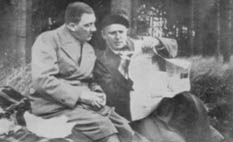
(3761)
Below is the inscription by Ely Culbertson in our copy of The Strange Lives of One Man:
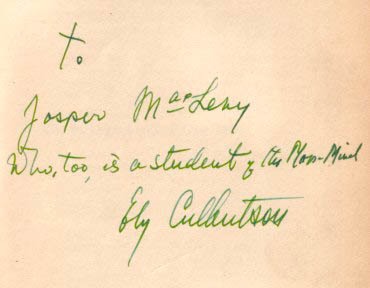
The following passage appeared on pages 416-417 and relates to the early 1920s:
‘I had occasionally dropped in at Frank Marshall’s Chess Club for a game of chess. There I had watched a bridge game which ran daily at half a cent a point. The bidding and play were atrocious, and I had often reflected that even at half a cent a point I should easily make a couple of hundred dollars a month ...
... I took a Fifth Avenue bus for my first hunting expedition in Greenwich Village.
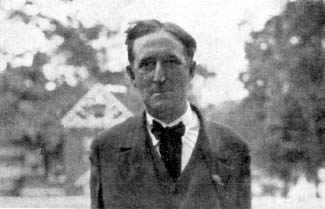
Frank Marshall and his charming wife greeted me cordially. Instead of playing chess, however, I asked if I could cut in at a bridge table.
“Do you play auction?” Everyone was surprised.
“A little.”
I was received with that naïve alacrity peculiar to many bridge players, who regard every stranger as a customer. Their hopes were amply confirmed as I started to play. Such bizarre, unconventional, crazy bidding had never been seen before.
No wonder – I was the only player in the world who then played the Culbertson System.
That night Janowsky, one of the world’s greatest chess champions, who also fancied himself a master at auction, was playing at my table. His luck was running badly, and he suggested that we double the stakes and play for a penny. Since everyone was already playing on Janowsky’s losses, it was agreed; and later we doubled the stakes again. We played all night. I had never worked harder nor played better. When the game broke up at ten in the morning I had won a hundred dollars, most of it from Janowsky. He told me he would pay me the next day. That was all right. But the next day he died.
I went on playing at Marshall’s, but the cards began to run against me. Day after day I lost; and my capital dwindled to less than ten dollars ...
My luck finally turned, and in a short time I regained my losses. From then on I seldom had a losing week, but at half a cent a point it was impossible to squeeze out more than an average of 150 dollars a month.’
A substantial problem with Culbertson’s story is that Janowsky died in Hyères, France, in 1927.
(3566)
Page 31 of Chess Strategy and Tactics by F. Reinfeld and I. Chernev (New York, 1933) referred to Janowsky’s ‘inordinate and aggressive self-confidence, which gave rise to many amusing incidents. Thus, after the loss of his match against Marshall in 1905, he sent the American master a telegram offering to play him at knight odds!’
Forty years later Chernev still found the tale amusing enough to include on page 53 of his book Wonders and Curiosities of Chess (New York, 1974), under the heading ‘Offers victor knight odds’, but it is not true.
Marshall and Janowsky played a match at the Cercle Philidor in Paris from 24 January to 7 March 1905, and the final score was +8 –5 =4 in Marshall’s favour. The view that Janowsky suffered many unlucky accidents and that the two masters were of more or less equal strength was expressed by, for example, Alapin on pages 88-89 of La Stratégie, 17 March 1905, and page 89 also featured a letter which Janowsky wrote to Marshall on the same day as the last match game was played:
‘J’estime que le résultat de notre match est loin d’établir nos forces respectives, au contraire, étant donné que dans la majorité des parties j’ai laissé échapper soit le gain, soit la nullité, je suis persuadé que normalement j’aurais dû vaincre facilement.
J’ai donc l’honneur de vous provoquer pour un match de revanche aux conditions suivantes:
Le vainqueur sera le premier gagnant 10 parties les nulles ne comptant pas; je vous offre l’avantage de 4 parties, c’est-à-dire que mes quatre premières parties gagnées ne compteront pas; l’enjeu ne devra pas être supérieur à 5000 francs.’
An English version appeared on page 27 of the American Chess Bulletin, February 1905. The Bulletin commented that ‘such an address to a successful adversary cannot but make an unpleasant impression with the rank and file of lovers of chess and good sportsmanship’. That is hard to dispute, but it should be noted that there was no question of Janowsky offering Marshall knight odds; he was proposing to his victor the advantage of four points.
The sketch of Janowsky given below was on page 251 of the July 1905 issue of the Bulletin:
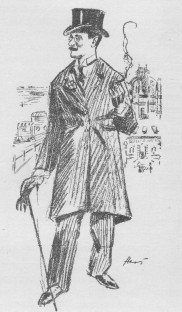
Another (less good) English version of Janowsky’s letter appeared on page 79 of Frank Marshall, United States Chess Champion by A. Soltis, after which Soltis commented: ‘To this Marshall made no formal reply’. That is not true either. As recorded on page 150 of La Stratégie, 19 May 1905, a reply from Marshall, written in London on 22 April 1905, was published by Janowsky in Le Monde Illustré of 29 April 1905:
‘J’accepte le défi de votre lettre du 7 mars dernier à condition que vous pourrez obtenir pour moi les mêmes arrangements que le Cercle Philidor m’a accordés pour notre précédent match.’
Despite Marshall’s acceptance, the arrangements foundered, and it was not until January-February 1908 that the return match took place (five games up, with no odds) at the villa of L. Nardus in Suresnes. Janowsky won +5 –2 =3.
The photograph below, of Marshall, Nardus and Janowsky, is the frontispiece in The Match and The Return Match: Janowsky v. Marshall by L. Hoffer (London, 1908):
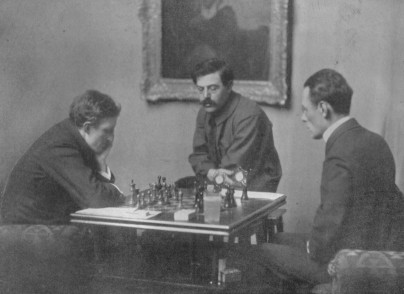
(3699)
On the basis of Janowsky’s weekly chess column in Le Monde Illustré (11 February to 18 March 1905), as well as La Stratégie of 20 February and 17 March 1905, we list the total times taken by Marshall and Janowsky in their 17-game match in Paris. Marshall, who won +8 –5 =4, had White in the odd-numbered games:
1: 4.14 – 4.11;
2: 2.30 – 2.30;
3: 2.48 – 2.13;
4: 3.48 – 4.12;
5: 3.00 – 2.48;
6: 3.19 – 3.00;
7: 2.00 – 2.12;
8: 2.05 – 1.57;
9: 4.24 – 4.21;
10: 4.14 – 4.31;
11: 3.43 – 3.46;
12: 3.10 – 2.40;
13: 4.12 – 4.40;
14: 3.20 – 2.18;
15: 2.52 – 4.57 (Le Monde Illustré) or 4.37 (La Stratégie);
16: 1.49 – 3.00;
17: 3.03 – 4.35 (times omitted by Le Monde Illustré).
(6129)
A portrait of Marshall by Nardus was shown in C.N. 3715:
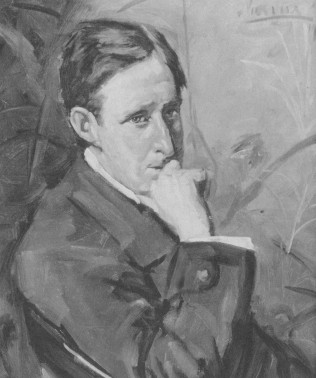
See also Léonardus
Nardus.
Michael McDowell (Westcliff-on-sea, England) has sent us a number of problems composed by over-the-board masters, and the series begins here with this composition by Frank J. Marshall (Our Folder, February 1917):
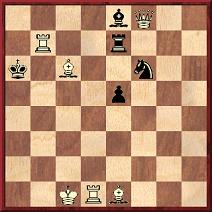
Mate in two
Our correspondent observes:
‘A neat rendering of a familiar idea. Marshall had clearly learned something about composing technique since making the trivial problem below, which was quoted on page 236 of the Chess Amateur, May 1914.’
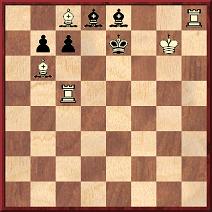
Mate in two
(3765)
A group photograph from London, 1927:
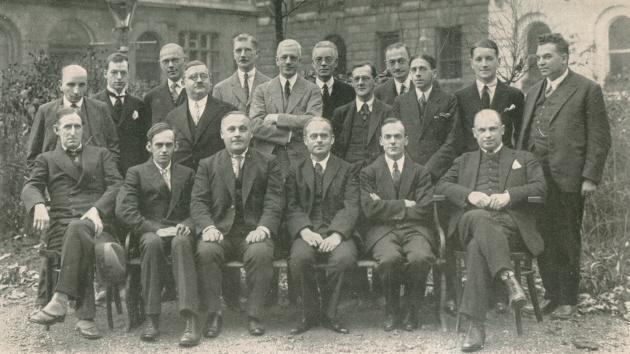
Seated from left to right: F.J.
Marshall, W. Winter, E. Bogoljubow, A. Nimzowitsch, W.A.
Fairhurst, S. Tartakower.
Standing: W.H. Watts, M.E. Goldstein, H. Kmoch, M. Vidmar, R.C.
Griffith, Sir George Thomas, E. Busvine, F.D. Yates, J. Schumer,
E. Colle, V. Buerger, R. Réti
(3959)
David Zechiel (Lake Forest, CA, USA) sends the following photograph from a frail, unidentified newspaper:
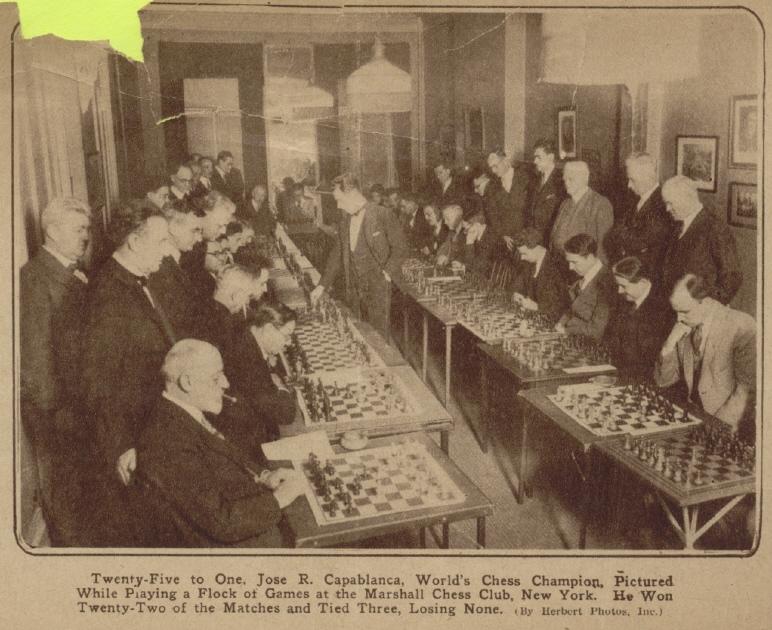
Our correspondent remarks that the figure standing second from the left is apparently Frank J. Marshall.
We can add that the occasion seems to have been the Cuban’s display on 30 November 1926. Below is the report on page 154 of the December 1926 American Chess Bulletin:
‘World champion Capablanca was in splendid trim when he encountered 25 of the members of the Marshall Chess Club in simultaneous play on the evening of 30 November. Not one of his opponents could defeat him. He won 22 and drew three against Rudolph Smirka, Milton Hanauer and Fred Reinfeld.’
(4454)
Past items (see page 192 of A Chess Omnibus and pages 130-131 of Chess Facts and Fables) mentioned that Gerald Abrahams and André Chéron wrote monographs on both chess and bridge. Another person in that category is James Cruickshank Henderson Macbeth, who co-authored with F.J. Marshall Chess Step by Step (New York, 1924) and also penned Common Sense in Auction Bridge (1924) and Auction Bridge Simplified (1925).
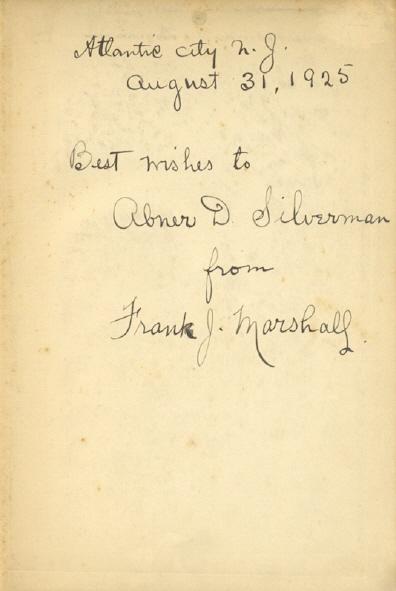
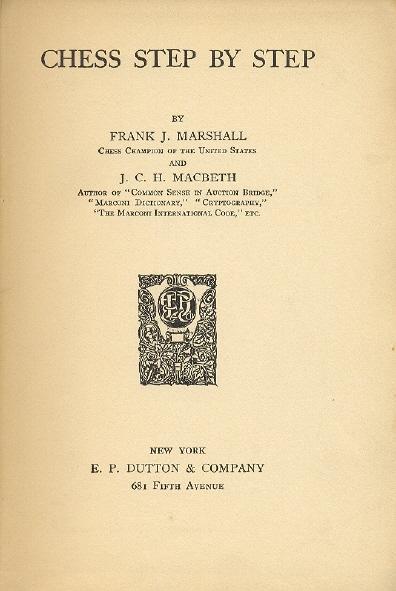
From Hermann Helms’ biographical note on pages xii-xiii of Chess Step by Step:
‘J.C.H. Macbeth was born in Scotland, and educated at Aberdeen University. He inherited a taste for chess, as both his father and grandfather were good players, and while in his early 20s he won the championship of the Aberdeen Chess Club for three years in succession. He was invited to take part in the great match between England and Scotland in 1903, and justified his selection by winning both his games.
For several years he was one of the leading figures in Scottish chess circles ...’
What is to be made of these claims on Macbeth’s behalf?
(4462)
The book Chess Step by Step by F.J. Marshall and J.C.H. Macbeth (New York, 1924) is a further matter where A. Soltis’s 1994 monograph on Marshall (see C.N.s 4738 and 6266) went awry. On page 347 Soltis stated that Chess Step by Step ‘went into five printings’ and that another book written by Macbeth was Cryptography. Chess Step by Step had far more printings, the final one in our collection, the tenth, being dated November 1945. The author of Cryptography (London, 1922) was André Langie. As shown by our copy below, Macbeth was the translator (although he added a section at the end of the work):
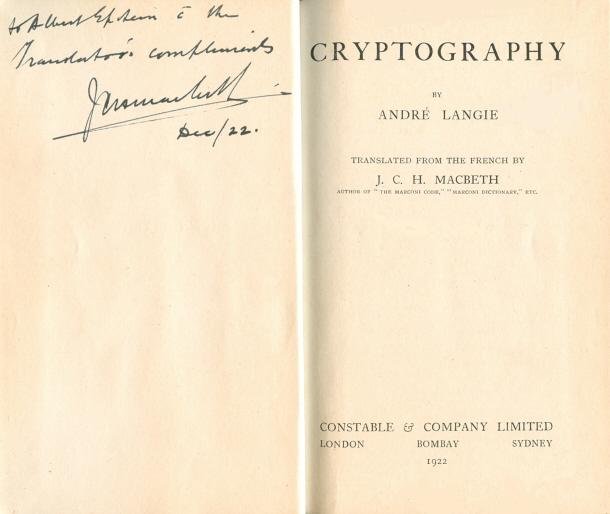
Published opinions on the Marshall/Macbeth book have varied widely. Soltis described it as ‘a routine introductory text of 306 pages’, whereas the book itself carried high praise from the Boston Herald: ‘the finest book on chess fundamentals ever written’.
(6342)
We have now acquired an even later printing of Chess Step by Step, published in 1953. The imprint page lists 12 printings:
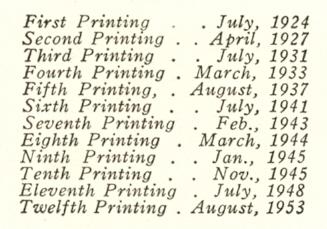
The final game (pages 289-291) is a rather elementary brevity lost by Marshall:
Richard Stutz – Frank James Marshall1 e4 ... 2 d4 c5 3 e5 (‘This move is the invention of Mr Stutz, and the sacrifice of a pawn, followed eventually by another, constitutes the Stutz Gambit.’) 3...cxd4 4 Bd3 Qa5+ 5 Nd2 Qxe5+ 6 Ne4 Nc6 7 Nf3 Qa5+ 8 Bd2 Qc7 9 O-O Nf6 10 Re1 Nd5 11 Nfg5 g6 12 c4 dxc3 13 Bxc3
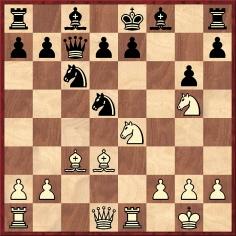
13...Nxc3 14 Nf6+ Resigns.
(6356)
John Blackstone (Las Vegas, NV, USA) sends a brief report from page 3 of the New York Times, 26 June 1904. It begins:
‘Five of the masters who were competitors in the recent international chess tournament at Cambridge Springs, Penn. participated in a team match at the Brooklyn Chess Club Friday night [24 June], the sides being captained by Frank J. Marshall, winner of the international event, and Richard Teichmann, who was then finishing a three days’ engagement at the Brooklyn Club.
Marshall was in a reckless mood, chose an eccentric opening and made an unsound sacrifice, with the result that he lost his individual encounter with Teichmann at Board 1, after a long and far from uninteresting game.
Carl Schlechter, the Austrian champion, won his game from J.S. Jones, Vice President of the Western Chess Association, and A.W. Fox won from C. Jaffe. W.E. Napier and C.S. Howell were matched at the second board, and the game resulted in a draw. The match was won by Teichmann’s team on totals of five to four.’
The newspaper then listed the complete board results, but presented no moves. Mr Blackstone asks if anything further is known about the event and whether any games have survived.
The match was mentioned on page 217 of Napier The Forgotten Chessmaster by John S. Hilbert (Yorklyn, 1997), which gave the moves of Napier v Howell, but we have come across no other games. Can any reader trace them and, in particular, the Marshall v Teichmann game-score?
(4476)
The position below was given in C.N. 354, taken from page 12 of the January 1909 Wiener Schachzeitung. It occurred in a simultaneous exhibition (+ 21 –2 =6) between F.J. Marshall and Dr Hartlaub in Hamburg on 15 December 1908.
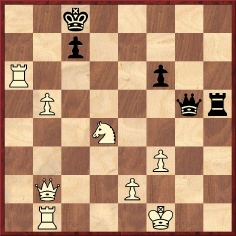
Marshall won with 1 Ra8+ Kb7 2 Ra7+ Kb6 3 Ra6+ Kb7 4 e3 Rh1+ 5 Ke2 Rh2+ 6 Kd3 Rxb2 7 Rxb2 c5 8 bxc6+ Kxa6 9 c7 Qf5+ 10 Nxf5 Ka7 11 c8(R) Resigns.
Is it possible to find the complete game-score in a newspaper of the time?
(4516)
C.N. 4550 quoted the remark by Newell Williams Banks, ‘my best achievements at chess were probably my isolated victories over Marshall and Kashdan in one tournament’. That was in Chicago, 1926, and the event was won by Marshall ahead of Maróczy and Torre. Strange to say, it has not yet proved possible to find the game-score of Banks’ win over Marshall.
On pages 11-12 of Banks’ Blindfold Checker Masterpieces by N.W. Banks (Philadelphia, 1947) H. Helms wrote:
‘Marshall, as a rule, was a good loser. I can vividly recall his chagrin at losing this game. For a brief spell he was completely upset. They were nearing the end of the contest and the United States champion felt that this point might cost him the prize.
However, Fortune favored Marshall in the final round, in which all the “breaks” were in his favor and he came through half a point in advance of the field. It was in that round that Banks won brilliantly against Kashdan.’
Below is an inscription by Banks in one of our copies of the second edition of Banks’ Scientific Checkers (Detroit, 1929):
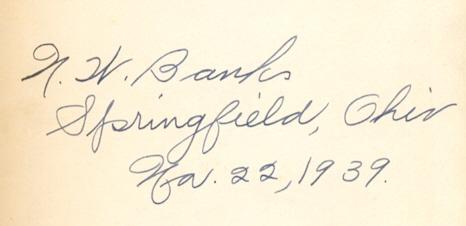
(4562)
C.N. 4562 quoted H. Helms’ remark that Frank J. Marshall was ‘completely upset’ after losing to Newell Banks at Chicago, 1926, and we mentioned our inability to find the game-score. Jack O’Keefe (Ann Arbor, MI, USA) has now traced it in Helms’ column on page 4A of the Brooklyn Daily Eagle, 16 September 1926. The introduction read:
‘In the ninth round [Banks] came near blighting Marshall’s prospects by defeating the United States professional chess champion. The latter took the ending entirely too easy, and the Detroiter demonstrated that it contained greater possibilities than what his redoubtable opponent had suspected.’
Newell Williams Banks – Frank James Marshall
Chicago, 1926
Queen’s Pawn Opening
1 d4 d5 2 Nf3 Nf6 3 Bg5 e6 4 e3 h6 5 Bf4 c5 6 c3 Nc6 7 Nbd2 Bd6 8 Bxd6 Qxd6 9 Bb5 O-O 10 O-O Bd7 11 Qe2 a6 12 Bxc6 Bxc6 13 Rfe1 Ne4 14 Ne5 Be8 15 f4 f6 16 Nxe4 dxe4 17 Nc4 Qc7 18 dxc5 Qxc5 19 Nd2 Qf5 20 g4 Qg6 21 Qg2 Rd8 22 Rad1 Rd3 23 Nb3 Ba4 24 Rxd3 exd3 25 Nc5 Bc6 26 e4 Rd8
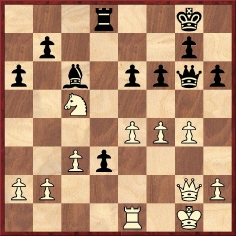
27 Rd1 f5 28 Rxd3 Rxd3 29 Nxd3 Bxe4 30 Ne5 Qf6 31 Qd2 fxg4 32 Nxg4 Qg6 33 h3 Bd5 34 Kf2 Qe4 35 Ne5 Qg2+ 36 Ke3 Qxh3+ 37 Kd4 Qh1 38 c4 Qg1+ 39 Qe3 Qxe3+ 40 Kxe3 Bc6
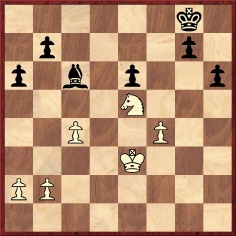
41 Kd4 h5 42 b4 h4 43 Kc5 h3 44 Ng4 Bf3 45 Nh2 Be2 46 a4 Kf7 47 b5 axb5 48 cxb5 Bd1 49 a5 Be2
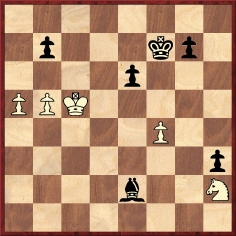
50 a6 b6+ 51 Kxb6 Bd3 52 a7 Be4 53 Kc7 e5 54 fxe5 Ke6 55 b6 Kxe5 56 b7 Bxb7 57 Kxb7 Kf4 58 a8(Q) Kg3 59 Qb8+ Kg2 60 Kc6 g5 61 Kd5 Kh1 62 Ke4 g4 63 Nxg4 Resigns.
Page 7 of Banks’ Blindfold Checker Masterpieces by Newell W. Banks (Philadelphia, 1947) quoted his view of F.J. Marshall:
‘I received more good ideas on opening and mid-game chess play from my old friend Frank Marshall than from all the other chessplayers I have known. If Marshall had had the urge to continue to apply himself to study and analysis he could have been at the top all his life. He was the greatest natural player of them all.’
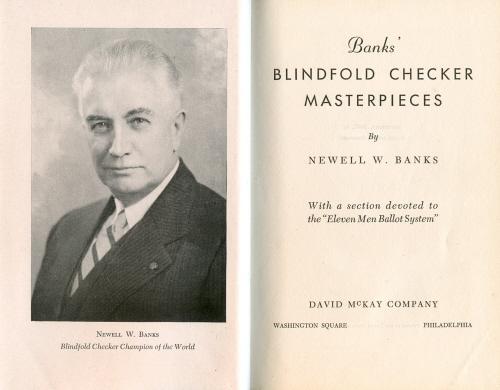
(6495)
Jim Kulbacki (Cheyenne, WY, USA) sends an advertisement featuring Frank J. Marshall, from the Saturday Evening Post, 28 April 1934:
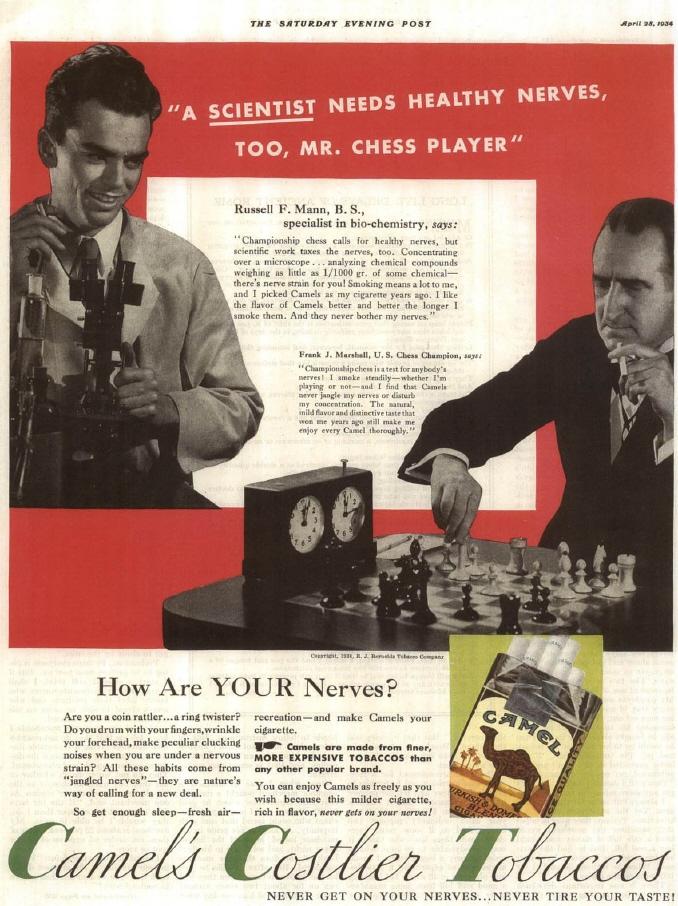
(4622)
See too Chess in Advertisements.
Karel Mokrý (Prostějov, Czech Republic) submits some pictures relating to Frank J. Marshall and Bedřich Fuchs. The latter was the President of the Marshall Chess Club in Prague, and biographical information about him is being sought.
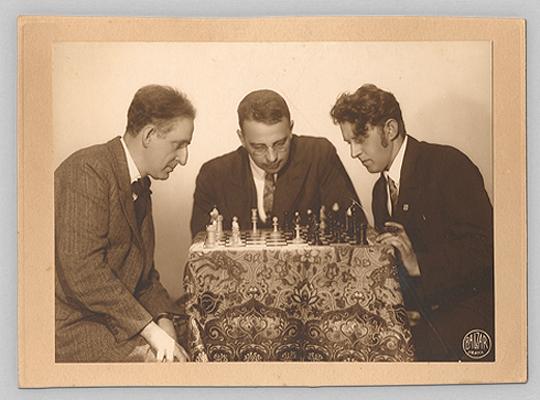
Frank J. Marshall, N.N., Bedřich Fuchs
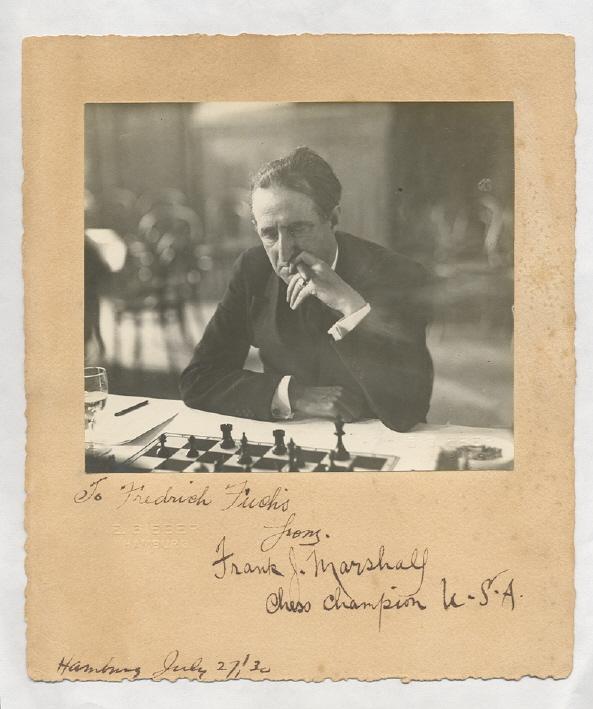
Photograph of Marshall inscribed to Fredrich [sic] Fuchs at the end of the 1930 Hamburg Olympiad.
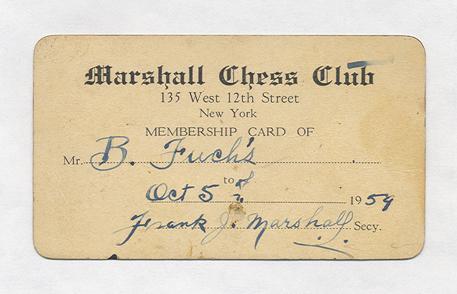
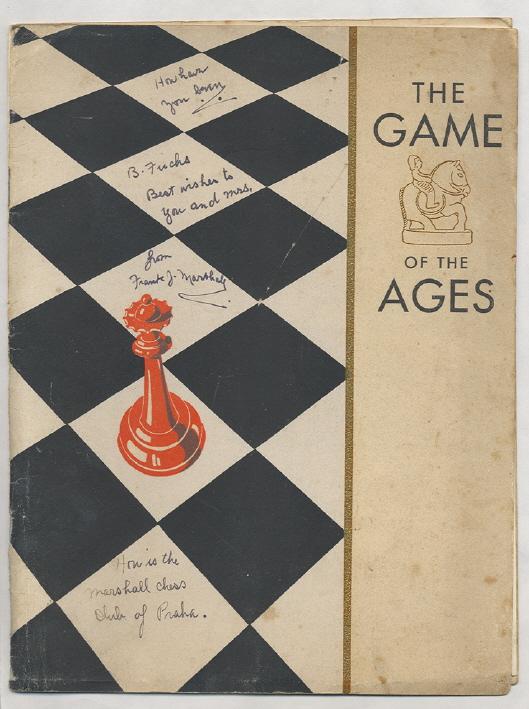
An inscription by Marshall on the 12-page publication of the Marshall Chess Club, The Game of the Ages
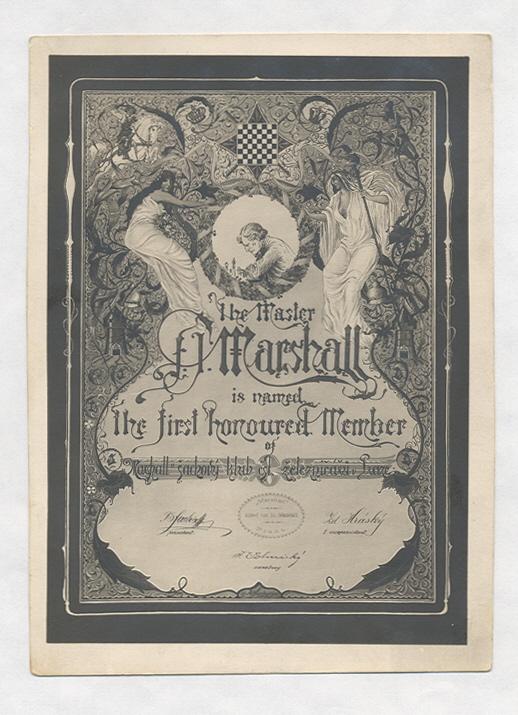
Copy of a certificate enrolling Marshall in the Marshall Chess Club in Prague.
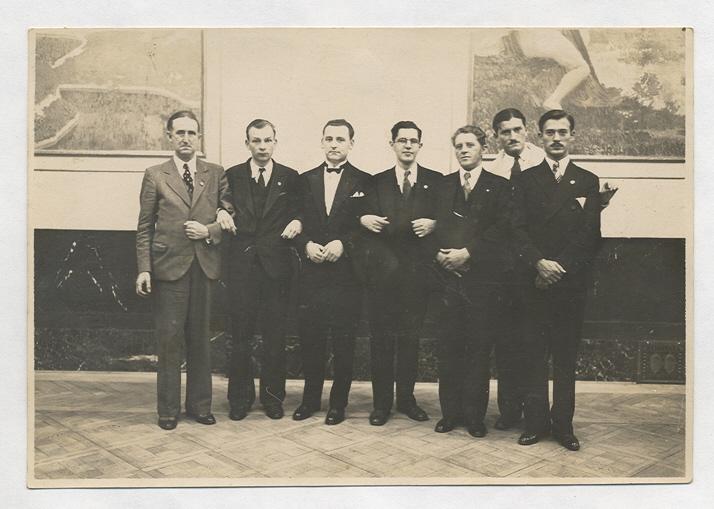
Prague Olympiad, 1931. From left to right: F.J. Marshall, A.W. Dake, N.N., I.I. Kashdan, B. Fuchs, I.A. Horowitz, H. Steiner.
This group photograph was published in the Prague, 1931 book (without any names) and opposite page 416 of El Ajedrez Español, September 1935 (where Fuchs was merely identified as a suplente and the person between Dake and Kashdan was described as a delegado).
It may be recalled here that our correspondent Karel Mokrý runs an online chess shop which is notable for its attractive prices and impeccable service.
(4737)
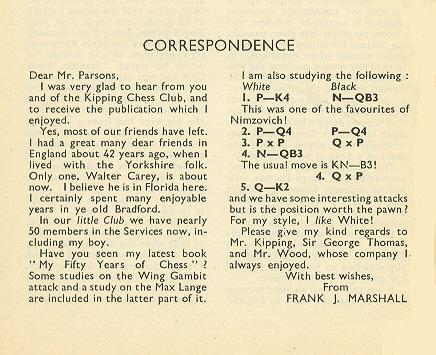
This letter to A.E. Parsons, the Club Secretary, was published on page 6 of The Kipping Chess Club Year Book 1943-1944 (Liverpool, 1944). The communication is undated, but the Year Book was published only a month or so before Marshall’s death (CHESS, October 1944, page 1).
C.N. 4772 dealt with the famous Nimzowitsch v Sistemsson parody, and now Javier Asturiano Molina (Murcia, Spain) mentions a fantasy game between ‘Aaron Marshall’ and ‘Frank Nimzowitch’: 1 e4 a6 2 Bc4 Nh6 3 Bb3 Nf5 4 Be6 Na7 5 Qh5 Resigns 6 Drawn.
It was published on pages 121-122 of Ajedrología by Julio Ganzo (Madrid, 1971):
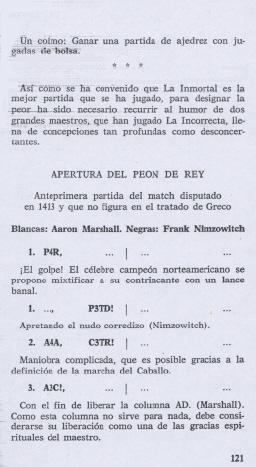
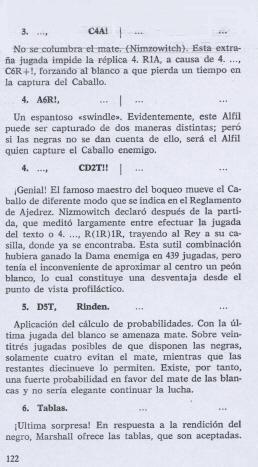
Had the spoof already been published elsewhere?
(4842)
A group photograph from page 173 of the December 1925 American Chess Bulletin:

(4992)
‘One of the best photographs ever taken of Frank James Marshall’ was the comment on page 26 of the February 1931 American Chess Bulletin regarding this portrait:
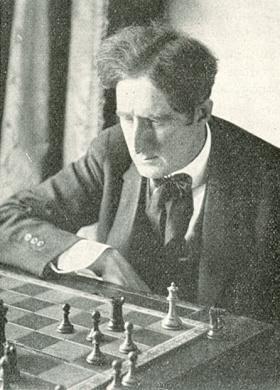
Frank James Marshall
However, Marshall is shown examining an incorrectly-set board. It would not seem to be a photograph mistakenly reversed, given that he customarily parted his hair on the left.
(5114)
From Ola Winfridsson (Cambridge, England):
‘The photograph could be correct. It looks as if the board folds in the middle, and I assume this to be between the fourth and fifth ranks rather than between the d and e files. It all depends on the original shade of the squares of the chessboard; in some old black and white photographs and films, lighter colours appear darker than darker colours.’
(5124)
On the subject of possible misunderstandings in photographs of board positions, C.N. 5514 showed this picture from page 26 of the February 1931 American Chess Bulletin:
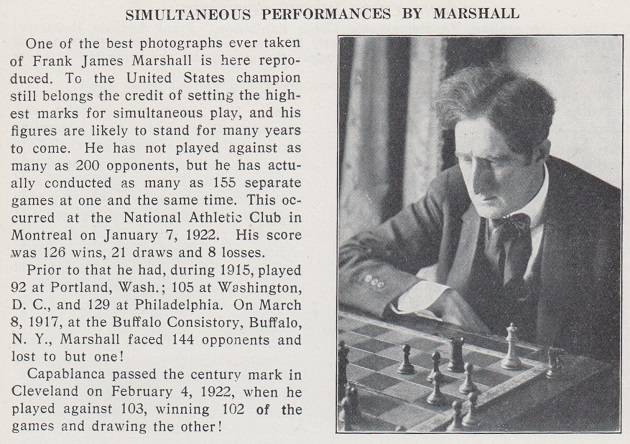
(11447)
This picture from page 26 of the February 1931 American Chess Bulletin was discussed in C.N.s 5114 and 5124, the question being whether the ostensibly incorrect board position was a photographic illusion.
The same, or a very similar, chessboard is on the front cover of the December 1944 Chess Review:
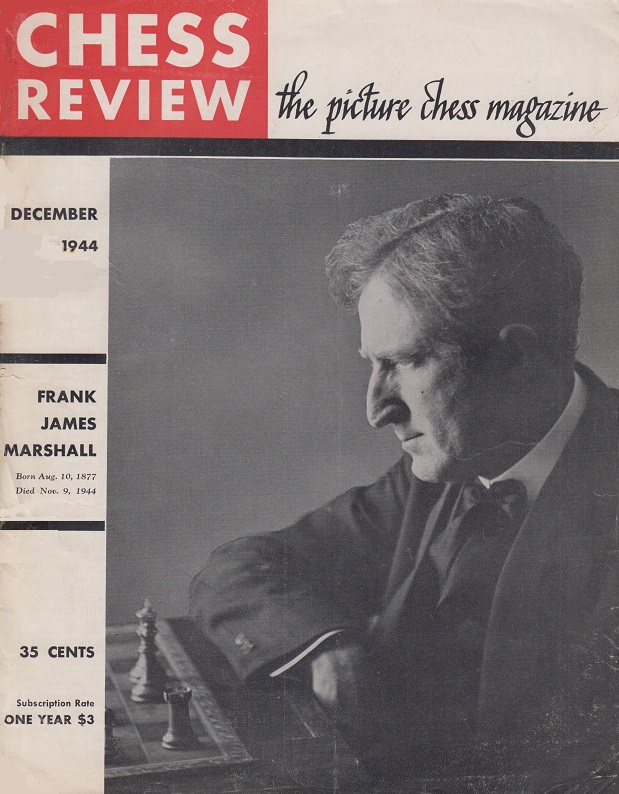
(11712)
John Blackstone writes:
‘On page A8 of the Los Angeles Times of 13 November 1927 a column called “Chess” by Clif Sherwood stated:
“United States champion Frank J. Marshall, in his chess department of the November issue of the Sportsman, gives the following ...”
What, if anything, is known about that magazine?’
(5142)
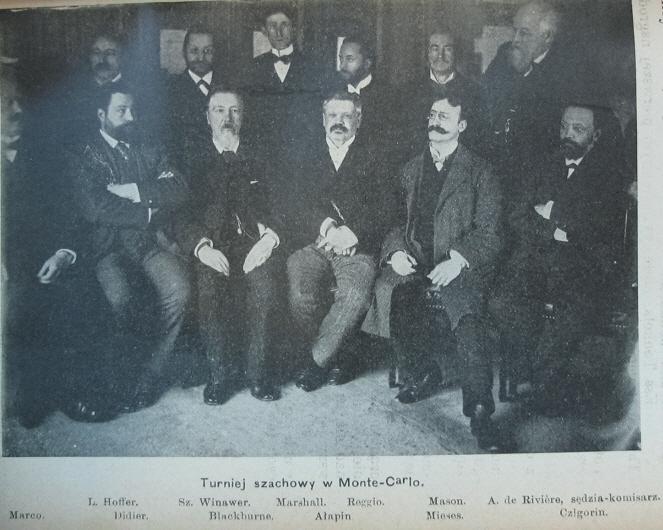
Tomasz Lissowski (Warsaw) submits the above group photograph of Monte Carlo, 1901, published in that year’s Sport, a Polish weekly periodical. He asks whether a copy of better quality can be obtained.
(5305)
Wanted: specimens of the anti-Turton theme in over-the-board play. Only two instances have been given in C.N. so far (see C.N.s 553 and 681, on pages 5-6 of Chess Explorations).
The first occurred in the game Edward Lasker v Marshall, New York, 1924.
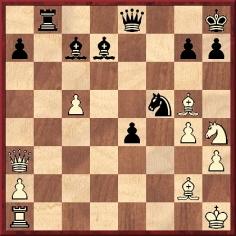
White played 28 Bf4 (preventing ...Qe5).
Wolfgang Heidenfeld’s explanation of the anti-Turton theme, using the above example, was quoted in C.N. 553 from pages 10-11 of his book Lacking the Master Touch (Cape Town, 1970):
‘It consists in forcing the attacker who wishes to double two pieces on the same gait in such a way as to have the stronger piece in front and the weaker behind (called the Turton in the jargon of problemists) into playing the weaker piece across the so-called “critical square” (here Black’s K4) and thus into reversing the planned line-up ...’
The second position was provided in C.N. 681 by our correspondent Michael McDowell from page 124 of Modern Chess Tactics by L. Pachman (London, 1970):
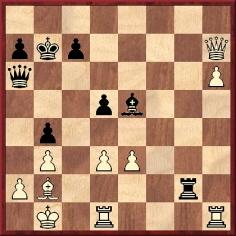
Lucarelli v Carra, Bologna, 1932. If 1 d4 then 1...Qe2. White therefore played 1 Rd2 Rxd2 2 d4 Qe2 3 Bc1, and Black resigned.
Is the full game-score available?
(5350)
On the anti-Turton theme, see too C.N.s 5512 and 5644.
Palle Henriksen (Birkeroed, Denmark) reports that his copy of Marshall’s Chess “Swindles” by F.J. Marshall (New York, 1914) contains some handwritten comments:
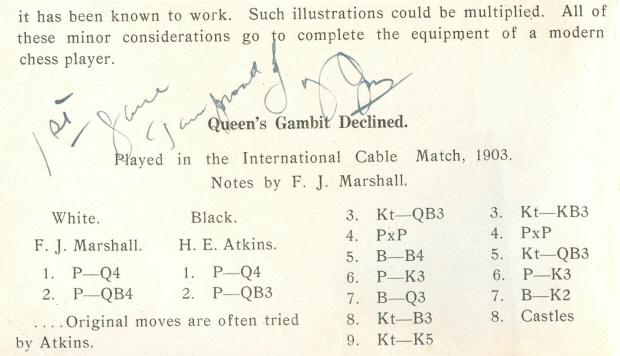
The Blackburne game (won after a lengthy ending) was not included in Marshall’s My Fifty Years of Chess (New York, 1942).
For purposes of comparison, it may be recalled that C.N. 4462 reproduced a Marshall inscription from our collection.
(5621)

The above illustration was shown in C.N. 4600.
An extract from our article Disappeared, on David A. Mitchell:
A revised edition of Mitchell’s Guide was issued by David McKay in 1920 and included a collection of Marshall’s best productions which was ‘unique in that the games were selected by the champion himself as being those which appeal especially to him, out of the thousands he has played’. It is of historic interest to note Marshall’s favorites and the corresponding comments thereon.
- Marshall v Pillsbury, Vienna, 1903. ‘Mr Marshall considers it his best game from the standpoint of attack and counter attack.’
- Marshall v Atkins, Cable Match, 1903: ‘My game with Atkins in the International Cable Match in 1903 was a thriller. There was attack and counter-attack galore, and I look back upon it as one of my greatest victories.’
- Marshall v Schlechter, Ostend, 1907: ‘My game at Ostend in 1907, against the late Carl Schlechter, I have never surpassed, in my opinion, for constructive combination.’
- Teichmann v Marshall, San Sebastián, 1911: ‘The end-game was especially difficult and I never surpassed it in that respect.’
A further quote from the above-mentioned article:
Mitchell’s other chess book, simply entitled Chess, was first issued by The Penn Publishing Company, Philadelphia in 1917 and was dedicated to Rudolph Blankenburg. It proved less enduring than the Guide, even though the title page sang out:
‘The best beginners [sic] manual ever made. The book is a model of clearness. There are many excellent diagrams and scores of problems.’
The problem section was substantial, with 75 compositions, and the work concluded with an account of four-handed chess and a brief history of the regular game. The book again showed Mitchell’s interest in the career of Marshall, and pages 76-78 gave a game Eddy v Marshall: ‘Frank J. Marshall recently encountered A.J. Eddy, a well-known chessplayer from Chicago, at the rooms of the Manhattan Chess Club, New York City, in a series of games, the object of which was to test the Queen’s Gambit Declined opening.’ Little seems to have been recorded elsewhere about this event.
A view from Tarrasch which was given on page 388 of Kings, Commoners and Knaves:
‘... there are some masters, unfortunately notable among them being Marshall, who are quite devoid of any sense of tact, and who make it a matter of principle to continue playing with stupid obstinacy in the most hopeless positions. Such procedure makes them themselves look ridiculous, and is degrading to the tourney as a spectacle.’
Tarrasch expressed these sentiments in Die Schachwelt, and they were reported on page 204 of the May 1912 BCM. He was referring to his 90-move win against Marshall at San Sebastián, 1912, in which the American fought out an ending with a rook against rook, bishop and two pawns.
C.N. 2113 (see page 233 of Kings, Commoners and Knaves) mentioned the report on page 10 of the January 1906 American Chess Bulletin that F.J. Marshall’s son (born on 28 December 1905) was named Frank Rice Marshall. We wondered whether the second forename was chosen in honour of Isaac Rice, but nothing further has yet come to light.
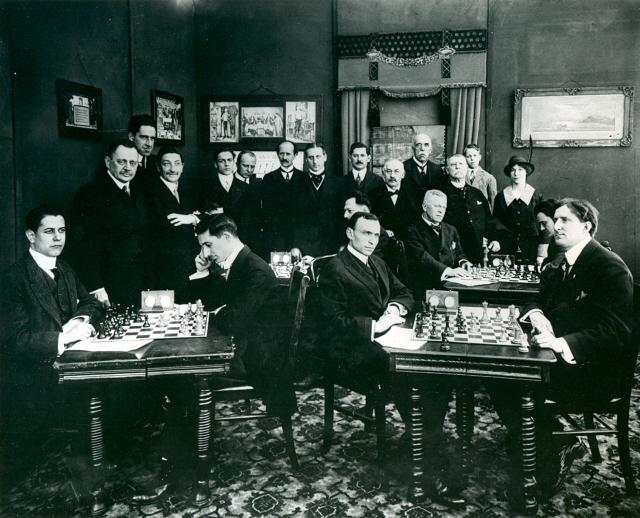
C.N. 5753 suggested that the boy in the above New York, 1915 group photograph was probably Marshall Junior.
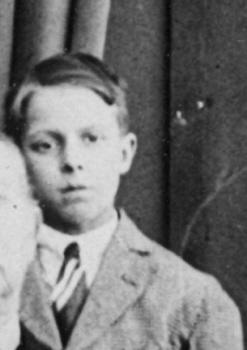
Below is a picture of him on page 15 of My Fifty Years of Chess by Frank J. Marshall (New York, 1942):
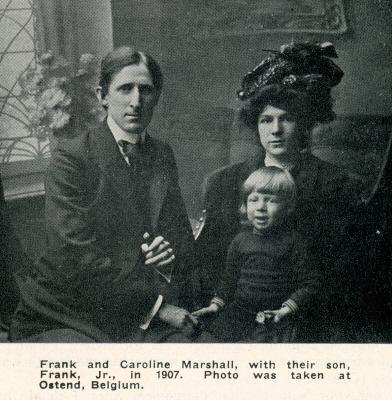
Regarding the Ostend, 1907 tournament, page 16 of Marshall’s book stated:
‘Carrie and I decided that we would go abroad together and take Frankie along, although he was only 16 months old.’
He looks considerably older.
Although biographical details about Marshall Junior are sparse, his photograph occasionally appeared in US chess magazines. An example, from page 9 of the April 1945 Chess Review, was given in C.N. 4347. Page 5 of the January-February 1945 American Chess Bulletin presented him in army uniform (and stated that he had served in France as a corporal in the Signal Corps and that ‘he weathered three of the major campaigns with Gen. Patton’s army’).
The photograph below was published on page 10 of the December 1945 Chess Review. It shows him preparing a radiogram for transmission to Moscow in the USA v USSR Radio Match, and on his left is Al Horowitz.
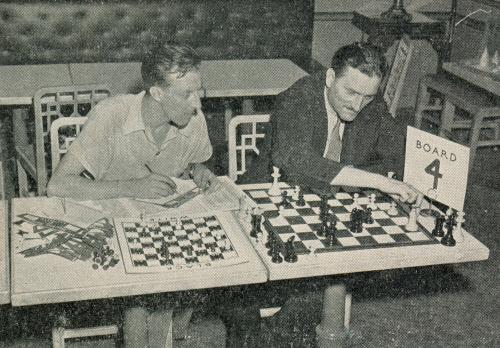
(5778)
C.N. 4421 referred to an essay ‘Capa, hijo de Caissa’ by the Cuban-born writer Guillermo Cabrera Infante (1929-2005) on pages 211-234 of Vidas para leerlas (Madrid, 1998).
Previously, the text had appeared on pages 406-422 of his anthology Mea Cuba (Barcelona, 1992). An English translation of the book, under the same title, was published by Faber and Faber in 1994, with a paperback edition the following year.
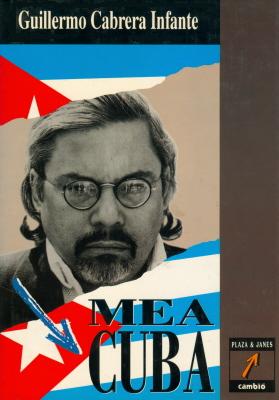
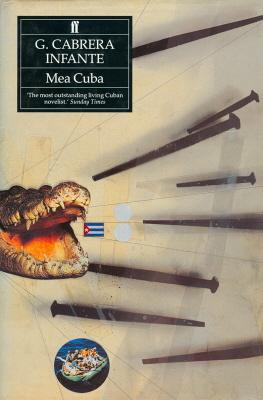
Cabrera Infante was unfamiliar with basic facts about Capablanca’s life, and one passage seems particularly odd. From pages 421-422 of the translation (by Kenneth Hall, in conjunction with the author):
‘In the Manhattan Chess Club the Cuban grew close to one of the greatest American players, Frank Marshall, whom he would defeat decisively in 1909. Capablanca was 21 [sic] years old, Marshall 33 [sic]. A very bored Capablanca playing against Marshall nodded off more than once. With a sense of humour often absent from across the chessboard, Marshall tells: “I made the worst move of the game. I woke up Capablanca.” Capablanca proceeded to execute a reveille checkmate.’
The original text was on page 409 of the 1992 Spanish volume:
‘En el club de Ajedrez de Manhattan, Capablanca intimó con uno de los grandes jugadores americanos, Frank Marshall, a quien derrotaría decisivamente en 1909. Capablanca tenía 21 años, Marshall 33. Marshall relata la ocasión en que un muy aburrido Capablanca, jugando en su contra, cabeceó más de una vez. Con un sentido del humor muchas veces ausente del tablero, contó Marshall: “Cometí el peor movimiento del juego: desperté a Capablanca.” Capa ejecutó un jaque mate fulminante.’
What are the origins of this yarn, which are reminiscent of the untrue story about Capablanca falling asleep during a match-game against Alekhine in 1927 (C.N. 5118)? Certainly, though, the Capablanca v Marshall match dragged on, and we pointed out on page 18 of our monograph on the Cuban that the 1927 world title match lasted only eight days longer. The cartoon below appeared on page 33 of the Chess Weekly, 26 June 1909:
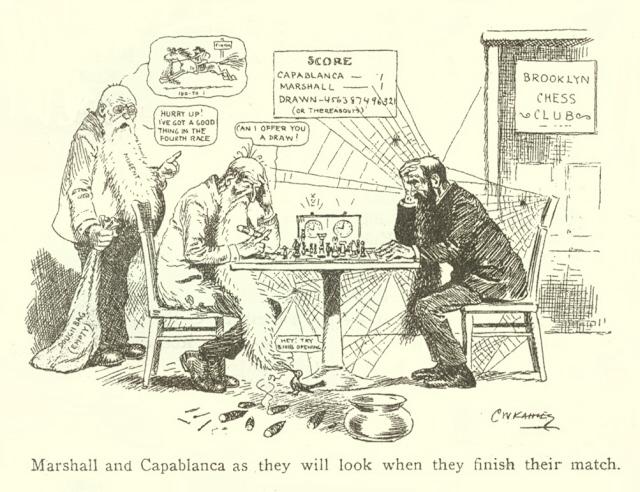
(5897)
Taylor Kingston (Shelburne, VT, USA) writes:
‘Guillermo Cabrera Infante’s account of Capablanca supposedly falling asleep while playing Marshall in 1909 bears a great resemblance to an incident involving Fischer and Bisguier. One account is on page 197 of The Even More Complete Chess Addict by M. Fox and R. James (London, 1993):
“It’s New York 1963, the last round of the American championship. Bisguier and Fischer are equal first. Fischer doesn’t make a move for a long time. Bisguier looks up and sees his opponent is fast asleep. In another half-hour, the great Bobby’s clock will fall, making Bisguier the champ. That’s where we come to the most gracious blunder of all. In Bisguier’s words: ‘I made a bad move. I woke up Bobby Fischer.’ And of course Bobby, after a couple of yawns, went on to collect his fifth US title.”
This is almost identical to what Cabrera Infante reports that Marshall said (“I made the worst move of the game. I woke up Capablanca”). Could he have confused Capablanca-Marshall with Fischer-Bisguier?
Whether he did or not, there is already ample confusion about if and when Fischer may have fallen asleep while playing Bisguier. Contemporary reports on the game which was referred to by Fox and James, and was played in the last round of the US Championship in New York on 3 January 1963, mention no such incident (see, for example, Chess Life, January 1963, page 3; Chess Review, February 1963, page 63 and March 1963, pages 76-77).
Frank Brady’s Profile of a Prodigy (New York, 1973) is unsure, but indicates that it was more likely in the Western Open at Bay City, Michigan, in July 1963. Page 70 describes Fischer playing an all-night set of high-stakes blitz games and then states:
“The next morning, Fischer faced Bisguier, and though perhaps apocryphal, it has been said that he was so tired he actually fell asleep at the board and had to be awakened. It didn’t affect his play, however, as he defeated Bisguier soundly.”
Bisguier himself, though, places the incident at the New York State Open, held in Poughkeepsie, NY in August-September 1963, on page 69 of The Art of Bisguier, Selected Games 1961-2003 (Milford, 2008):
“Paired against Bobby in the New York State Open that year, I noticed that he was taking a long time to move. Then I saw that he’d fallen sound asleep. In a few minutes the flag on his clock would fall, and he’d lose on time. That’s not the way I like to win games, tourneys or titles. So I made what some called my biggest blunder of the tournament. I awakened Fischer. Bobby yawned, made a move, punched his clock and proceeded to beat me. It ended up as Game 45 in his My 60 Memorable Games. Later I heard that Fischer had stayed up late the previous night playing speed chess for money.”
Brady seems to have confused the Michigan and New York tournaments. Whether Cabrera Infante has confused Fischer with Capablanca, I cannot say, but the two accounts are remarkably similar.’
We note that a) the above-quoted text by Messrs Fox and James also appeared on page 149 of The Complete Chess Addict (London, 1987) and b) the Fox/James book was referred to, in another context, in Cabrera Infante’s ill-informed essay on Capablanca. Indeed, he clearly used it for a number of his ‘facts’.
See too C.N. 7441.
The cartoon in C.N. 5897 provides a reminder of the lack of photographs of the peripatetic match between Marshall and Capablanca in 1909. The illustration below, by C.W. Kahles (1878-1931), comes from page 177 of the Chess Weekly, 1 May 1909. On page 345 of A Chess Omnibus we commented that it had been ‘sketched with some artistic licence’.
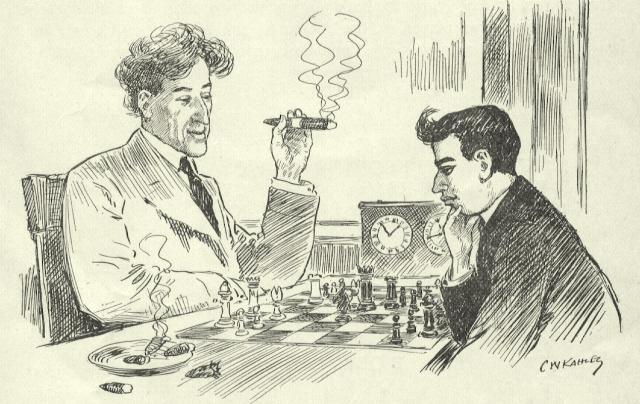
(5921)
Page 17 of our book on Capablanca gave a chart of the time consumed by the Cuban and Marshall in their 23-game match in 1909:
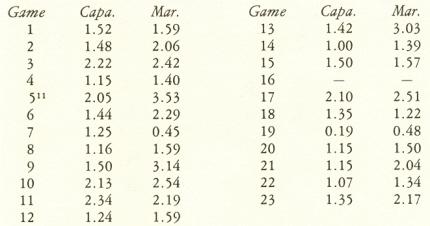
Our source was the June, July and August 1909 issues of the American Chess Bulletin, which omitted the timings only for game 16 (a draw at the Brooklyn Chess Club on 21 May). Information for that game was also absent from the table on page 6 of Imre König’s book on the match (San Francisco, 1955). The match book published in Stockholm in 1916 gave no clock times.
Is there any hope of finding the missing details for game 16?
(5934)
A portrait of Frank Marshall with the Hamilton-Russell Cup was the frontispiece of Marshall’s Comparative Chess (Philadelphia, 1932):
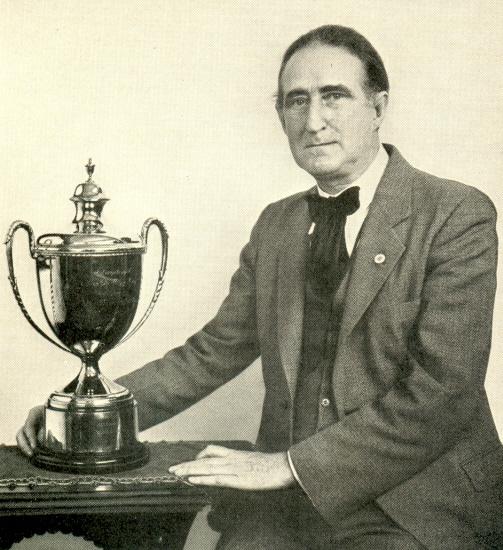
(6114)
Following publication of the agreement signed by Lasker and Marshall on 26 October 1906 for a world championship match (see pages 147-148 of Lasker’s Chess Magazine, August-September 1906) James Mortimer quoted a few unhappy passages on page 8 of the Daily Mail, 5 December 1906 and commented:
‘All this is wonderfully weird. It may be very good Liskeranto or very elegant Marshallpuk, but it is certainly not very good English.’
(6123)
From Olimpiu G. Urcan (Singapore) comes this sketch on page 438 of the November [sic – it was mistakenly headed ‘October’] 1905 BCM:
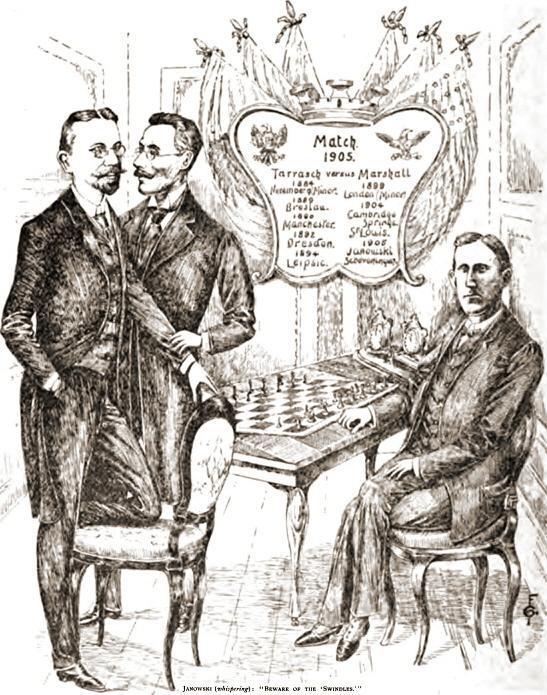
(6149)
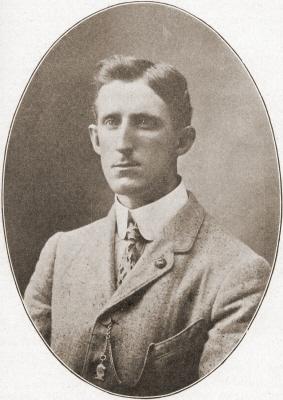
Frank James Marshall
C.N. 48 (see page 105 of Chess Explorations) mentioned a surprising report on page 12 of the Daily Sketch (London) of 23 December 1909 that Frank Marshall was retiring from chess. Below is the full text:
‘After a career extending over 21 years, Frank J. Marshall, the famous American chessplayer, has retired from the game. He retires with the title of champion chessplayer of America, which distinction he won recently from J.W. Showalter in Louisville.
Marshall’s defeated opponent received the title at the decease of Pillsbury, who in turn won it from him. Showalter received the title because of the fact that he had made the best showing against Pillsbury of all the claimants to the title. Marshall won the title from Showalter after four games, three of which were drawn and the fourth being a victory for him by the score of 7 to 2.
Marshall’s genius for the game was hereditary, for his father’s folk before him were all “sharks” at the game. When a boy Marshall devoted all his time to chess. When he was nine years of age his (Marshall’s) parents moved to Montreal from New York City, where Frank was born, and remained until he was 17 years old. They then moved to Brooklyn, and still reside in that borough.
Frank won his first title at the age of 15 years, when he became champion of Montreal. Since that time many other titles have been won by him, and although while in Europe he was billed as the champion of America the title was actually won by him recently in Kentucky.
Marshall’s retirement is due to two reasons – his wife and his business. The former seems to be the greater cause, for she claims that her husband should devote his time to her and to their little son, Frank Rice Marshall.
When asked for his reasons for retirement Marshall said: “The game is too absorbing. To play it one must devote to it all of his time. No game in the world calls for such deep study and devotion as chess, and while I love it there are other things which must occupy my attention. I have private business responsibilities which suffer from the game, so I decided to quit playing for good.”’
We refrain from commenting on the content of that report, but what are its origins? A brief announcement had appeared in the New York Times of 28 November 1909 (sporting news section, page S1):
‘Lexington, Ky., Nov. 27. – Frank J. Marshall of New York City, who yesterday won the chess championship of the United States over J.W. Showalter of Georgetown, Ky, authorizes the statement that he has quit the chess game for good and that he will give his attention to his business interests. He made this statement here today, upon coming from Georgetown, where his series with Mr Showalter ended last night.
Mr Marshall has been in every chess tournament of the past ten years and holds, besides the championship of this country, the Salta championship of the world. He has in his possession a prize Salta board, presented to him by the Emperor of Germany and the Prince of Morocco [sic] in 1906, when he won the world’s championship.’
(6168)
A sketch from page 9 of the Daily Mail, 6 October 1906, which accompanied the article by James Mortimer with the ‘rabbit quote’ (C.N. 6122):
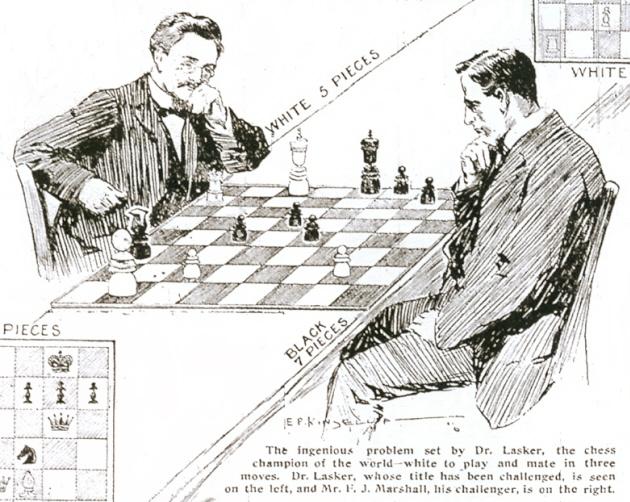
(6177)
1 d4 d5 2 e3 Nf6 3 Bd3 c5 4 c3 Nc6 5 f4 e6 6 Nf3 Ne4 7 O-O f5 8 Ne5 Nxe5 9 fxe5 Bd7 10 Nd2 Be7 11 Nxe4 dxe4 12 Bc4 b5 13 Bb3 c4 14 Bc2 O-O 15 Bd2 Bc6 16 Qh5 Qe8 17 Qxe8 Rfxe8 18 a4 a6 19 b4 Reb8 20 Ra2 g5 21 Rfa1 Kf7 22 axb5 axb5 23 Rxa8 Bxa8 24 Ra7 Bb7 25 Bd1 Kg6 26 g3 Bd8 27 Be2 Bb6 28 Ra1 h5 29 h4 Ra8 30 Rxa8 Bxa8 31 Kf2 Bd8 32 hxg5 Bxg5
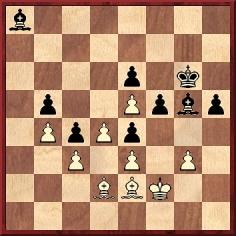
33 Bf1 h4 34 Bc1 Bc6 35 Kg2 Be8 36 Kh3 hxg3 37 Kxg3 Kh5 38 Be2+ Kh6 Drawn.
Such a quiet game seemingly deserves scant attention, but that may not be so. It was played by Marshall and Capablanca in the fifth round of the New York tournament on 26 January 1911 (the day after the Capablanca v Black game discussed in C.N. 6239). Page 9 of the New York Times, 27 January 1911 reported:
‘The game did not produce the exciting play hoped for, as both players were ultra-conservative, taking no chances whatever, the game finally being recorded as a draw after 38 moves.’
Page 49 of the March 1911 American Chess Bulletin made the general remark on the tournament that ‘not a hitch occurred to mar the smoothness of the proceedings’, and the game-score was given on page 58 of the same issue:
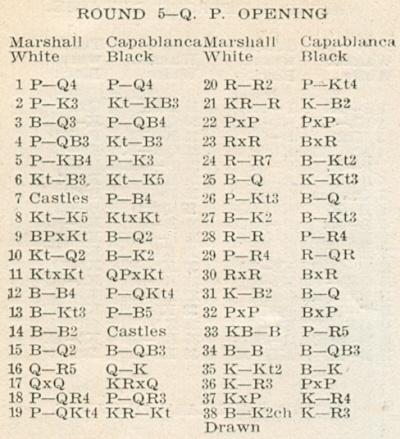
However, a report on page 71 of Deutsches Wochenschach, 19 February 1911 (based on an account in the New Yorker Staats-Zeitung) suggested a less pleasant story:
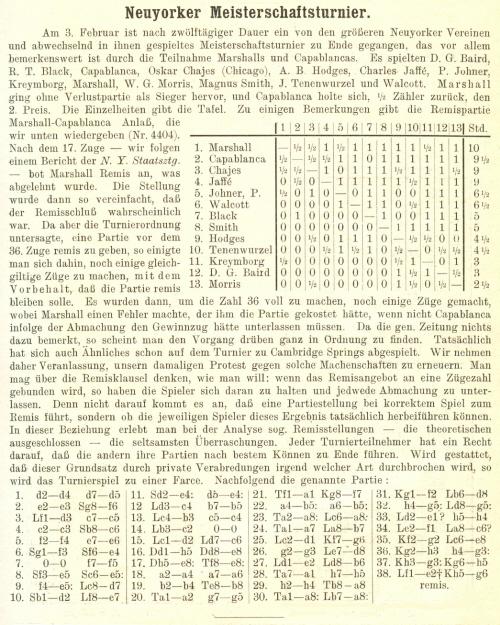
The report was picked up on page 100 of the March 1911 BCM:
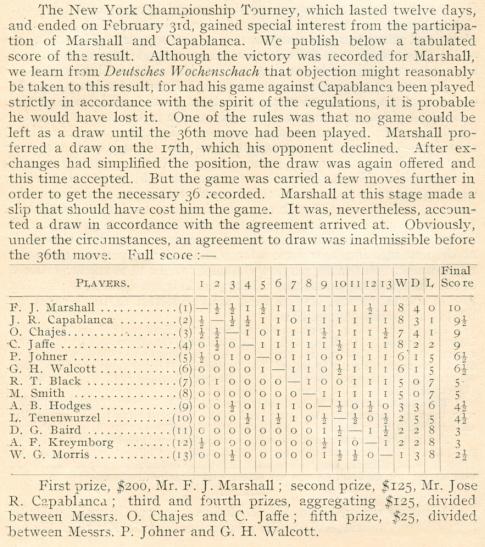
What is to be made of all this? We note that the game-scores in the American Chess Bulletin and Deutsches Wochenschach are slightly different (leaving aside the discrepancy over 38...Kh6/Kg6). According to the Bulletin, play from our diagram above continued 33 Bf1 h4 34 Bc1 Bc6, whereas the German magazine gave 33 Be1 h4 34 Bf1 Bc6. In the latter version, 34...Bc6 would indeed deserve a question mark, since Black can play 34...hxg3+. If, though, the game-score in the Bulletin is accurate, the story of a missed win collapses.
(6249)
Dominique Thimognier (Fondettes, France) sends this game from page 6 of L’Echo de Paris of 16 March 1903:
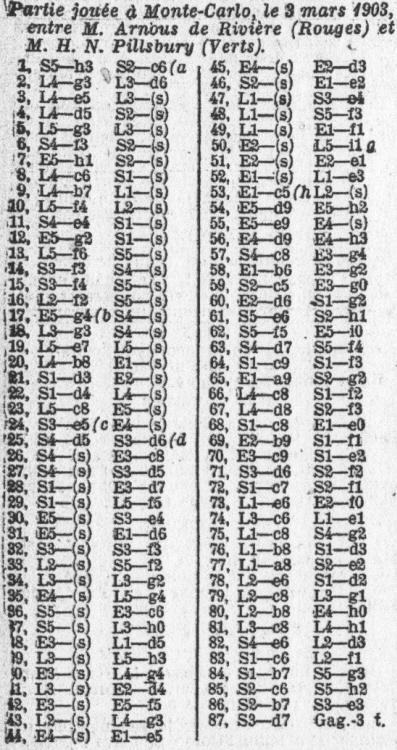
For more information, see the complete column.
Our correspondent has also provided, from page 6 of L’Echo de Paris of 8 April 1901, the game Marshall v Henig, Monte Carlo, March 1901.
(6478)
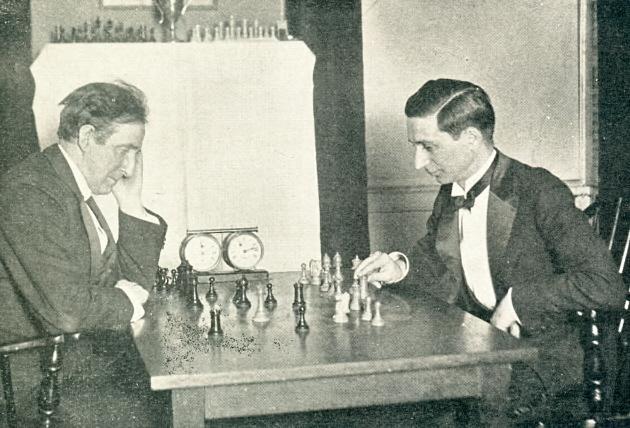
In this photograph, taken from page 8 of the December 1944 Chess Review, Frank J. Marshall and Edward Lasker are engaged in the first game of their 1923 match for the US championship. Lasker is about to play 31 Rc2, the move which was sealed at the first adjournment (American Chess Bulletin, March 1923, pages 51-52). For his notes to parts of the game, see pages 251-256 of his book Chess Secrets I Learned from the Masters (New York, 1951).
(6552)
Addition on 20 December 2022:
Olimpiu G. Urcan has sent us this fine version of the above photograph:
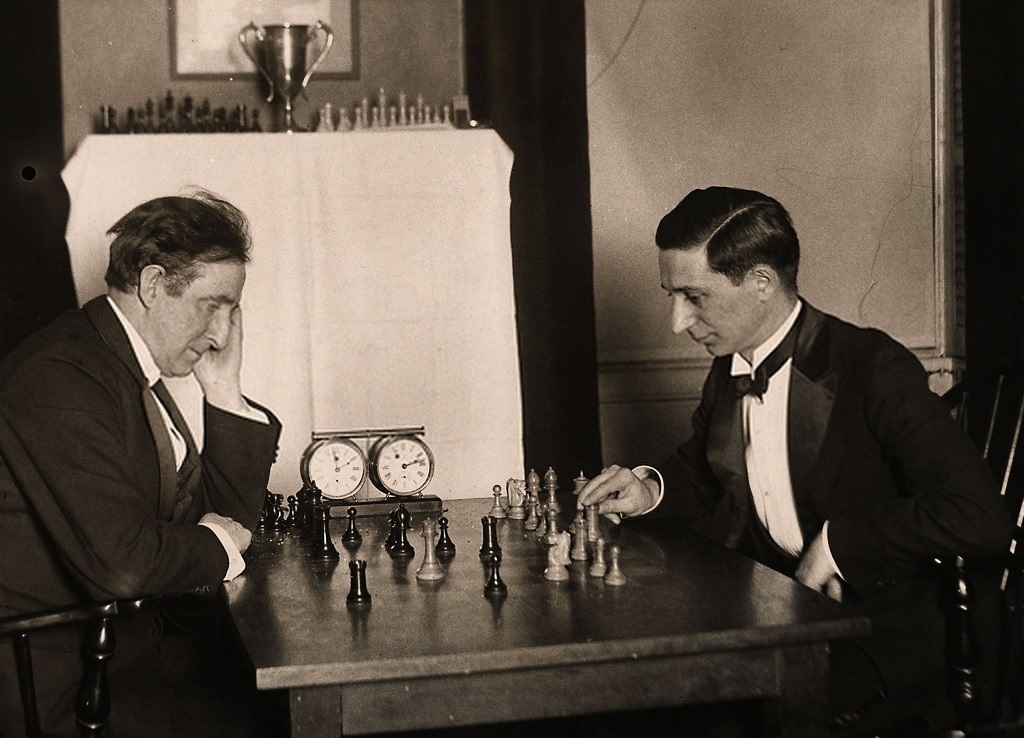
John Blackstone sends this report from page 26 of the Brooklyn Daily Eagle, 14 January 1935:
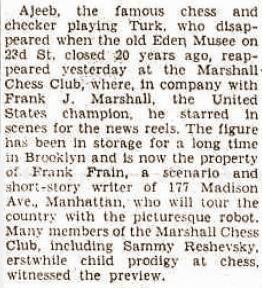
Can any reader discover whether the footage has survived?
Page 219 of Chess: Man vs Machine by Bradley Ewart (London, 1980) stated:
‘Under Frain’s guidance Ajeeb was reintroduced to the world in early January 1935. At that time the automaton, “rigged out anew in resplendent oriental regalia”, posed for a newsreel troupe at the Marshall Chess Club with US Champion Marshall himself. Frain later claimed that Marshall “encountered Ajeeb at chess, and went away shaking his head after a draw”.’
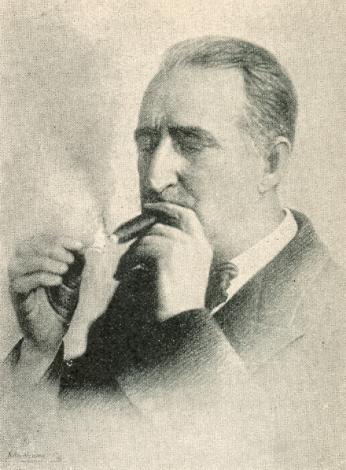
Frank James Marshall (American Chess Bulletin, December 1935, page 171)
(6527)
C.N. 1815 noted a reply by Marshall about how many cigars he smoked, in an interview in the Indianapolis Sun, 20 November 1906, as quoted on page 250 of Lasker’s Chess Magazine, October 1906:
‘Oh, very few now. I’m in training for the match with Dr Lasker. I’ll probably smoke ten a day. A few days before the games start I’ll rest up still more, for as soon as that day comes round, I’ll smoke 25 cigars a day. In three hours’ play I smoke about 15.’
Marc Hébert (Charny, Canada) notes a game on pages 214-215 of Frank Marshall, United States Chess Champion by A. Soltis:
1 e4 c5 2 Nf3 e6 3 d4 cxd4 4 Nxd4 Nf6 5 Bd3 Nc6 6 Nxc6 bxc6 7 O-O d5 8 Qe2 Be7 9 Nd2 Qc7 10 Re1 Rb8 11 Nf3 Bc5 12 b3 Ng4 13 Rf1 Bd4 14 Rb1 h5 15 c4 dxc4 16 Bxc4 c5 17 Bb2 Bb7 18 Bxd4 cxd4 19 Rbc1 Qf4 20 Bb5+ Kf8 21 Bd3 Rh6 22 Qd2 Qxd2 23 Nxd2 Ne5 24 Bb1 Ba6 25 Rfd1 Be2 26 Re1 d3 27 h3 Rg6 28 Kh2 Rf6 29 Kg1 h4 30 Rc7 Ng6 31 f3 Nf4 32 Kf2 Rg6 33 Rg1 Rb5 34 Rc8+ Ke7 35 Rgc1 Rxg2+ 36 Ke3 e5 37 R8c7+ Kf6 38 R1c6+ Kg5 39 Rxf7 g6 40 Rxf4 exf4+ 41 Kd4 Rg3 42 e5 Bxf3 43 Rxg6+ Kxg6 44 Bxd3+ Kf7 45 Bxb5 Rxh3 46 Nc4 Rh1 47 Nd6+ Kf8 48 Nf5 Rd1+ 49 Kc3 h3 50 e6 Re1 51 White resigns. (The score here corrects the ‘19 Rac1’ and ‘35 Rfc1’ in Soltis’ book.)
Our correspondent observes that the game was given as won by Marshall against Jacob Rosenthal in the 1913 team match between the Manhattan Chess Club and the Franklin Chess Club, being accompanied by various details about the occasion in Soltis’s narrative of Marshall’s chess activity that year. However, on page 369 of Walter Penn Shipley by John S. Hilbert (Jefferson, 2003) a different game was presented as played in that team match – a French Defence in which Marshall was White against Shipley. Commenting that the latter game was published in the report on the match on page 150 of the July 1913 issue of the American Chess Bulletin, Mr Hébert asks why two games against different opponents have been ascribed to Marshall.
As John Hilbert points out to us, the above Rosenthal v Marshall game was played in the match between the Manhattan Chess Club and the Franklin Chess Club three years later, on 30 May 1916. The game-score was given, together with the full match result, on pages 156-157 of the July-August 1916 American Chess Bulletin.
Marshall v Shipley (1913) was played in Philadelphia, and Rosenthal v Marshall (1916) in New York.
(6656)
Olimpiu G. Urcan writes:
Frank James Marshall – Eugene Ernest Colman‘Pages 71-75 of my book Surviving Changi. E.E. Colman: A Chess Biography provided an account of the match at the City of London Chess Club between F.J. Marshall and Colman on 27-29 April 1911 (won by Marshall +2 –1 =0). It was mentioned that only one of the games, Colman’s win, had been found, but I have now traced further information about the match, as well as the moves of the other two games.
The Straits Times of 31 May 1911, page 2, provided an extensive report dated 1 May 1911. All three games were included, and an eye-witness stated:
“While there [in Tunbridge Wells], he [Colman] arranged with the American champion, Mr F.J. Marshall, who had come over from his victories at San Sebastián to lead his countrymen in the cable match, to play a match of three games in London for a small stake. This match took place at the City of London Chess Club last week. The time-limit was 15 moves an hour, and Mr Colman lost the odd game. It was unfortunate that the deciding game had to be abandoned to the American at an interesting point through an oversight by Mr Colman, who was pressed for time. The games proved full of vigorous chess on both sides. I was fortunate to be present on Friday night when your champion beat the great American master, who was evidently chagrined at his loss.”
Colman’s victory over Marshall (in which he had White in a Queen’s Gambit Declined) was given on page 253 of my book, culled from the chess column of The Globe and Traveller of 6 May 1911 (page 10). Below are the other two games, and they show that Bruce Hayden was wrong when he stated that during this match Colman “repelled the famous Marshall Counter-Attack in the Ruy López, many years before its inventor was to play it against Capablanca in the New York tournament of 1918”. (See Hayden’s article in Chess Review, May 1953, pages 139-140, and his obituary of Colman in the October 1964 BCM, pages 298-300.)
The score of the first match-game has been corrected by me, starting with move 39. I reconstructed the game from that point, being convinced that there were typos in the score. Other errors were found: “23 Re7” instead of the obvious 23 Rd7, and “47 a7” and “48 Ra1” whereas it is evident that the moves 47 Ra1 and 48 a7 occurred in the game.’
1 e4 e5 2 d4 exd4 3 Nf3 Nc6 4 Bc4 Nf6 5 O-O Nxe4 6 Re1 d5 7 Bxd5 Qxd5 8 Nc3 Qd8 9 Rxe4+ Be7 10 Nxd4 f5 11 Rf4 O-O 12 Be3 Bd6 13 Nxc6 bxc6 14 Rd4 c5 15 Rd2 Bb7 16 Bf4 Qh4 17 Bxd6 cxd6 18 Rxd6 f4 19 f3 Rae8 20 Qf1 Rf5 21 Qf2 Qg5 22 Rad1 Rfe5 23 Rd7 Bc6 24 Rxa7 Re3 25 h4 Qh5 26 Rf1 R8e6 27 Rc7
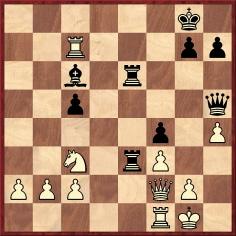
27...Bxf3 28 Rc8+ Kf7 29 Qd2 Qg4 30 Nd5 Bxd5 31 Qxd5 Qxh4 32 Qf5+ Rf6 33 Rc7+ Re7 34 Qd5+ Rfe6 35 Qxc5 h6 36 Rc6 g6 37 a4 Kf6 38 Rxe6+ Rxe6 39 Qd4+ Kf5 40 Qd3+ Kf6 41 Qd8+ Re7 42 Qd6+ Kf5 43 Qd3+ Kg5 44 a5 Qg3 45 Qxg3+ fxg3 46 a6 h5 47 Ra1 Re8 48 a7 Black resigned.
Source: The Straits Times, 31 May 1911, page 2.
Frank James Marshall – Eugene Ernest Colman1 d4 d5 2 c4 e6 3 Nc3 c6 4 e3 Nd7 5 Bd3 Bd6 6 f4 f5 7 Nf3 Ngf6 8 O-O Ne4 9 Bd2 Nxd2 10 Qxd2 Nf6 11 Rac1 O-O 12 Qc2 Ne4 13 g4 fxg4 14 cxd5 exd5 15 Nxe4 dxe4 16 Bc4+ Kh8 17 Ng5 Qc7 18 Qb3 h6 19 Nxe4 Bf5 20 Nxd6 Qxd6 21 Bd3 Rae8 22 Bxf5 Rxf5 23 Qd3 Qe6 24 Rce1 g5 25 fxg5 Rxg5 26 Qc3 Kg8 27 e4 g3 28 hxg3 Qh3 29 Rf3 Rh5 30 Kf2 Rf8 31 Qb3+ Black resigned.
Source: The Straits Times, 31 May 1911, page 2.
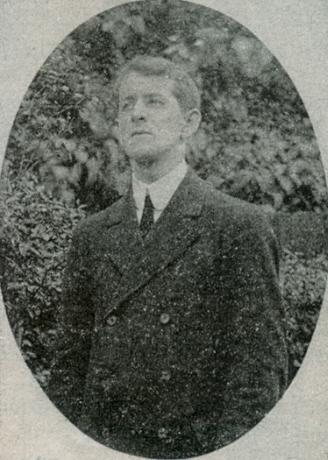
Eugene Ernest Colman (Chess Review, May 1953, page 139)
(6577)
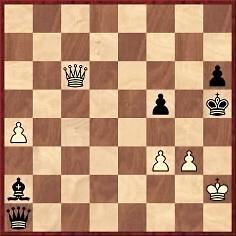
White to move
In a recent ChessBase article about copying we commented on a game (Marshall v Capablanca, fifth match-game, New York, 1909) in which many writers have claimed that White overlooked an immediate win with 45 Qe8+ Kg5 46 f4+ Kg4 (or 46...Kf6 47 Qh8+) 47 Qe2 mate. As is well known, no such win was missed because in the game Marshall’s queen stood not on c6 but on b6.
The oldest citation for the faulty position which was listed by Irving Chernev in his fine scrutiny of the matter (e.g. on page 128 of the May 1951 Chess Review) was ‘Gutmayer’s Schach-Praktiker on page 10’. That book (full title: Der fertige Schach-Praktiker) was originally published in Leipzig, undated but with a Foreword written by Gutmayer in October 1921. The second edition, from the same publisher, was dated 1923. Only the latter volume had the position allegedly from the Marshall v Capablanca game, on page 31:
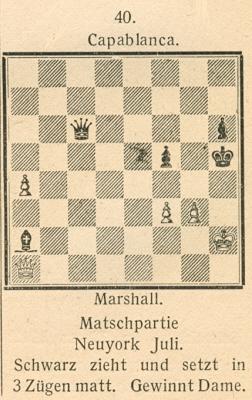
The mix-up in the diagram and the caption regarding White and Black (as well as the incorrect date – the game was played in April 1909) may be noted. The solution on page 135 also went awry:
Was this the publication to which Chernev was referring, even though he wrote ‘page 10’?
In C.N 2359 we wrote:
‘When Deutsche Schachblätter published the game on page 67 of its 5 September 1909 issue it gave White’s 43rd move as Qc6+ instead of Qb6. After a consequently incorrect diagram following Black’s 44th move the magazine reported that some chessplayers in Hamburg had found that White could have achieved mate or the win of the queen.’
(6655)
Before the Gutmayer books are cleared away, we add some examples of his treatment of Capablanca’s games:
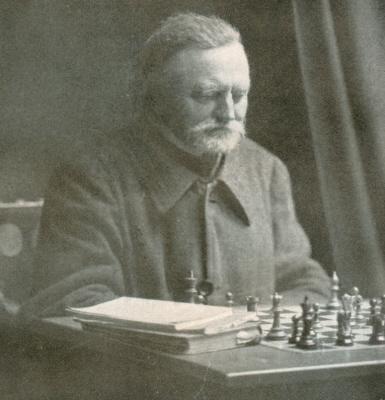
Franz Gutmayer
(7409)
See also The Facts about Larry Evans, where we wrote of the 1909 position as presented in his 1998 book The 10 Most Common Chess Mistakes:
Then page 157 has an alleged position from the Marshall v Capablanca match of 1909 (5th game), with Evans claiming that, “incredibly”, White missed an immediate victory (mate or gain of the queen) through 45 Qe8+. Untrue, because Marshall’s queen was on b6, and not c6. This elementary matter has been pointed out countless times, and even by Evans himself on page 750 of Chess Life & Review, November 1974.’
We are grateful to Patrick Neslias (Esse, France) for additional illustrations from his collection, including two Marshall items and the ‘other’ Carlsbad, 1929 group photograph (which was referred to in C.N. 5372):
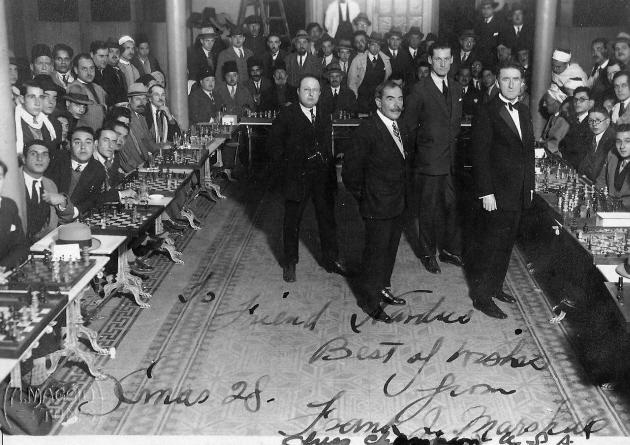
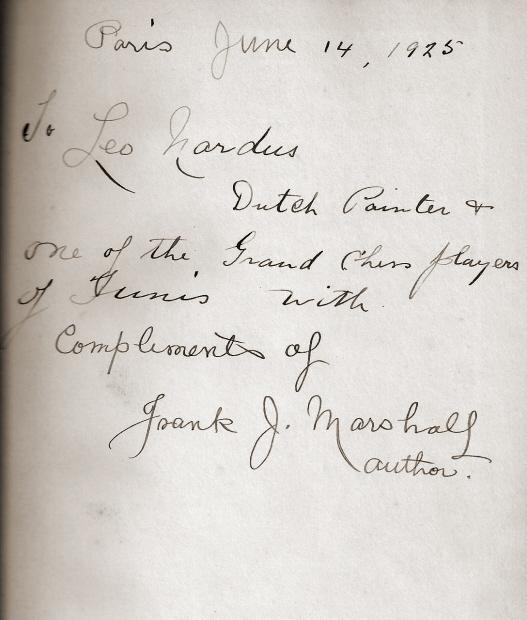
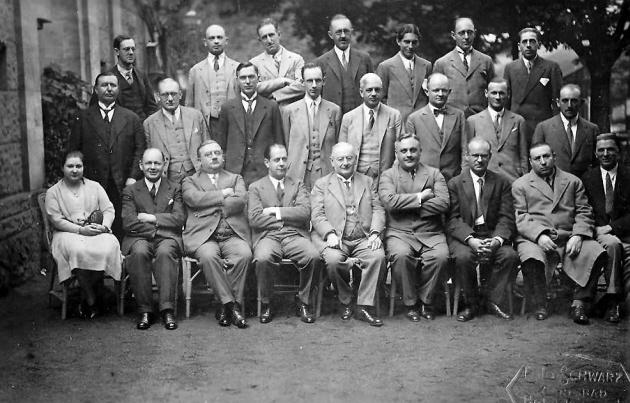
(6709)
John Blackstone notes that on page 7 of the 16 December 1908 issue of the New York Evening Post Emanuel Lasker gave a version of the seventh match-game between Marshall and Mieses (played in Berlin on 28 November 1908) which deviated from the commonly-published score.
Lasker’s text was repeated on page 63 of the December 1908-January 1909 issue of Lasker’s Chess Magazine, and for reasons of legibility that is the version reproduced here:
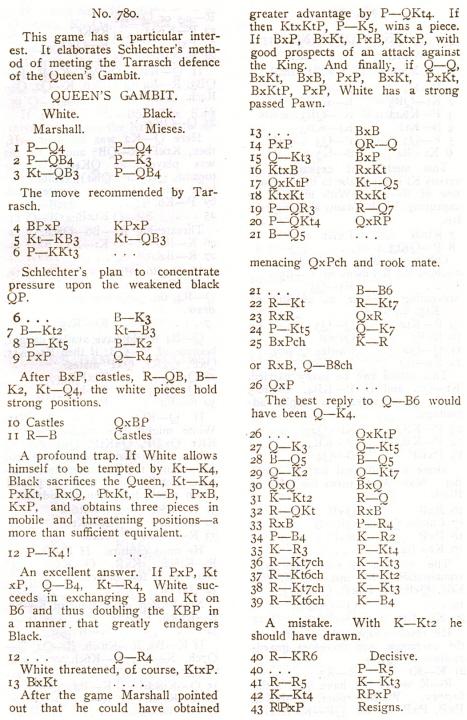
The game-score as regularly presented elsewhere is below (with, in square brackets, observations by Mr Blackstone on the differences from Lasker’s version):
1 d4 d5 2 c4 e6 3 Nc3 c5 4 cxd5 exd5 5 Nf3 Nc6 6 g3 Be6 7 Bg2 Nf6 8 Bg5 Be7 9 dxc5 Qa5 10 O-O Qxc5 11 Rc1 O-O 12 e4 Qa5 13 Bxf6 Bxf6 14 exd5 Rad8 15 Qb3 Bxd5 16 Nxd5 Rxd5 17 Qxb7 Nd4 18 Nxd4 Rxd4 19 a3 Rd2 20 b4 Qxa3 21 Bd5 Bc3
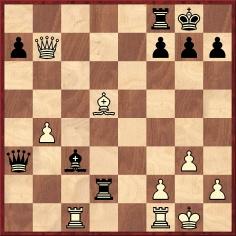
22 Bxf7+ [‘22 Rb1 Rb2 23 Rxb2 Qxb2 24 b5 Qe2 25 Bxf7+ Kh8 is the line given by Lasker.’] 22...Kh8 23 Rb1 Rb2 24 Rxb2 Qxb2 25 b5 Qe2 [‘Now the lines come back together.’] 26 Qxa7 Qxb5 27 Qe3 Qb4 28 Bd5 Bd4 29 Qe2 Qb2 30 Qxb2 Bxb2 31 Kg2 Rd8 32 Rb1 Rxd5 33 Rxb2 h5 34 f4 Kh7 35 Kh3 g5 36 Rb7+ Kg6 37 Rb6+ Kf5 [‘37...Kg7 38 Rb7+ Kg6 39 Rb6+ Kf5 40 Rh6 was given by Lasker.’] 38 Rh6 h4 39 Rh5 Kg6 40 Kg4 hxg3 41 hxg3 [‘This is where Lasker states that Black resigned.’] 41…Kf6 42 Rxg5 Rxg5+ 43 fxg5+ Kg6 44 Kh4 Kg7 45 Kh5 Kh7 46 g6+ Kg7 47 Kg5 Kh8 48 Kh6 Resigns.
The 48-move version was given in various magazines of the time, an example being Deutsches Wochenschach, 13 November 1908, pages 449-450. Even so, Lasker was in Berlin at the time of the game. His column in the Evening Post was headed ‘Berlin, 2 December’, and the introductory text too was reproduced in Lasker’s Chess Magazine (on page 40 of the above-mentioned issue).
(6711)
From Dan Scoones (Port Coquitlam, BC, Canada):
‘I wonder if there is a reasonable explanation as to how Aron Nimzowitsch’s name became attached to 3...c6 in the Falkbeer Counter-Gambit (after 1 e4 e5 2 f4 d5 3 exd5) when the move had already been played with success by Frank Marshall. On page 99 of the algebraic edition of their book The King’s Gambit (New York, 1986) V. Korchnoi and V. Zak append this note to 3...c6:
“Suggested by Nimzowitsch. However, it is more difficult for Black to achieve full equality in this variation than in other variations of the Falkbeer Counter-Gambit.”
Unfortunately, the authors do not indicate where or when Nimzowitsch may have made the suggestion. Y. Estrin’ s 1988 Russian book “Korolevsky Gambit” is more specific, and page 179 states:
“This interesting counter-gambit was introduced in a match game Spielmann v Nimzowitsch, Munich, 1907.”
The occasion was, in fact, the Munich tournament of 1906, but there is still the slight problem that the move had already occurred in the game Teichmann v Marshall, Ostend, 1905. In his well-known book My Fifty Years of Chess, Marshall included an appendix containing his analysis of some interesting opening ideas. He gave a paragraph or two on Keres’ line in the Falkbeer Counter-Gambit, but nothing about 3...c6. Had Marshall accepted Nimzowitsch’s priority regarding that move? However, it is one thing to suggest a move and another thing to play it over the board, and especially when it involves a pawn sacrifice for Black.’
We note that Spielmann v Nimzowitsch (played in the Munich tournament on 16 November 1906) appeared on, for instance, pages 8-9 of the January 1907 Deutsche Schachzeitung, where 3...c6 was described as an interesting novelty (‘eine interessante Neuerung’). Pages 788-789 of the Handbuch des Schachspiels (Berlin and Leipzig, 1922) stated that 3...c6 was introduced by Nimzowitsch (‘von Niemzowitsch eingeführt’), with no mention of the earlier Teichmann v Marshall game.
The Marshall game was played in the Ostend Supplementary Tournament in 1905 but was not widely published at the time. It did, though, appear on page 32 of the February 1906 American Chess Bulletin, without notes. Marshall’s own annotations, in which he described 3...c6 as ‘an innovation’, were given on page 119 of Marshall’s Chess “Swindles” (New York, 1914):
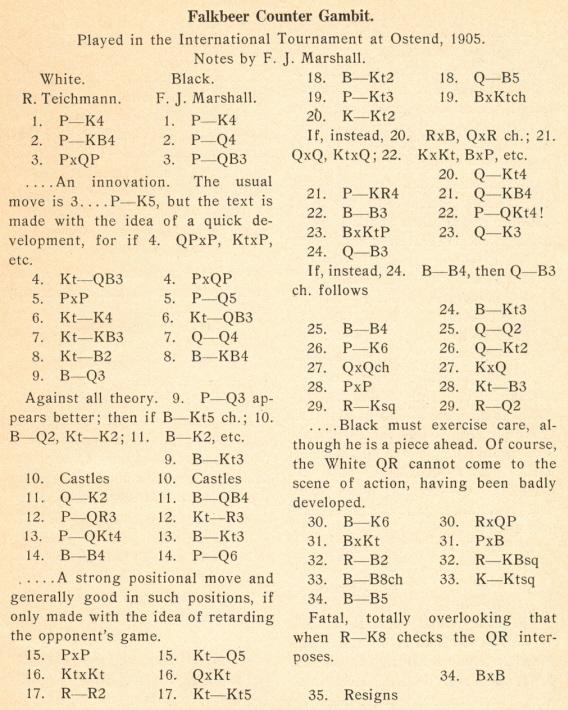
(6792)
We have compiled some references to pre-Second World War magazine features on the Falkbeer Counter-Gambit:
It may be recalled that A. von Claparède was the author of Die moderne Ablehnung des Königsgambits (Berlin, 1924) and Die Widerlegung des Königsgambits (Berlin, 1930).
Page 94 of Chess Openings by F.J. Marshall (Leeds, 1904):
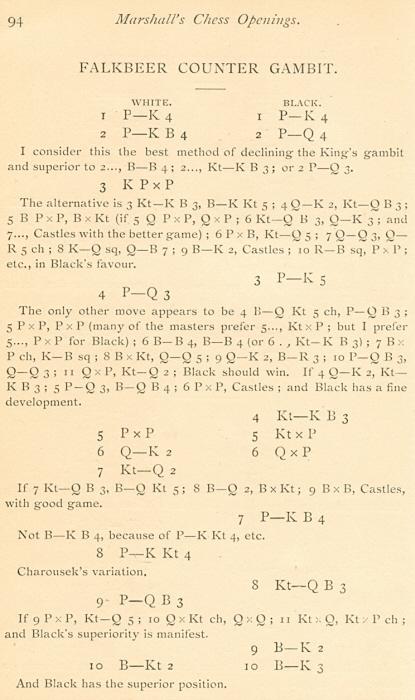
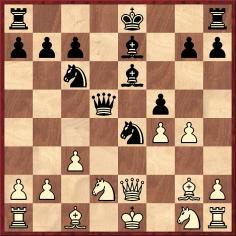
Position after 10 Bg2 Be6
A comment by W.H.S. Monck was published on page 131 of the February 1910 Chess Amateur:
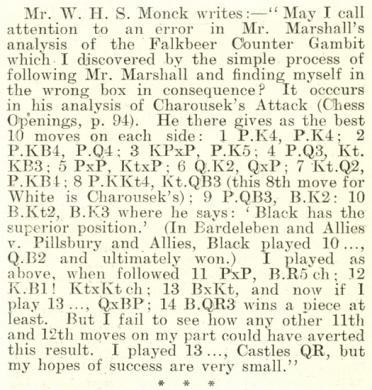
The Chess Amateur reverted to the subject when reviewing Griffith and White’s Modern Chess Openings (Leeds, 1911) on page 515 of the February 1912 issue:
‘... In the Chess Amateur Mr Monck complained of having been misled by Marshall’s Chess Openings in a variation of the Falkbeer Counter-Gambit, in which the master had left off with a remark that Black had the best of it when in fact the loss of a piece could not be avoided. This variation is given without comment p. 59 col. 25. We should wish to know how the able authors would reply to the obvious move 11 PxP.’
Page 69 of the second edition of Modern Chess Openings (London, 1913) had no mention of 10...Be6, giving instead (after 10 Bg2) the line 10...Qf7 11 Nxe4 fxe4 12 Bxe4 Bh4+ (13 Kd1 Be6) and referring to the 1902 consultation game opposing von Bardeleben and Pillsbury.
William Henry Stanley Monck, incidentally, was an eminent astronomer, as mentioned on page 153 of Chess Facts and Fables.
(6938)
From our feature article on the astronomer E.M. Antoniadi:
Regarding Antoniadi’s chess career, its high spot came in a tournament in Paris in 1907; with a score of +6 –1 (a loss to de Villeneuve) =0 he came equal first with Marshall, a point ahead of Tartakower. In the three-game play-off, Marshall won the first game and the other two were drawn. Antoniadi commented:
‘Until now I have had few opportunities to face top-rank players, but I have studied a great deal. Firstly, with the excellent ABC des Echecs [by Preti] and then by following most faithfully the learned commentaries of Dr S. Tarrasch, whom I consider one of the best annotators of our time and of whom I am an ardent disciple.’
Source: La Stratégie, 24 July 1907, pages 258-259.
On page 132 of the June 1922 La Stratégie Antoniadi claimed that he had an equal score against Marshall (‘two games won, two lost and three draws between 1902 and 1907’) and that this success was almost entirely due to his study of Tarrasch’s books.
Below is his tournament victory over Marshall, who had played a world championship match against Lasker earlier the same year:
Frank James Marshall – Eugène M. Antoniadi
Paris, 7 July 1907
Queen’s Gambit Declined1 d4 d5 2 c4 e6 3 Nc3 Nf6 4 Bg5 Be7 5 e3 Ne4 6 Bxe7 Qxe7 7 cxd5 Nxc3 8 bxc3 exd5 9 Bd3 Nd7 10 Nf3 O-O 11 O-O Re8 12 c4 dxc4 13 Bxc4 Nb6 14 Qc2 Bf5 15 Qxf5 Nxc4 16 Rfc1 Nd6 17 Qc5 c6 18 Rab1 Ne4 19 Qc2 Rad8 20 Ne5 Nd6 21 Qa4 Nb5
22 Rxc6 Nxd4 23 exd4 bxc6 24 h3 Rd6 25 Nxc6 Qe4 26 Rc1 Rg6 27 g4 h5 28 Qc2 Qf3 29 Qb3 Qf4 30 Qc3 hxg4 31 Ne5 gxh3+ 32 Kh1 Qg5 33 White resigns.
Antoniadi annotated the game on pages 247-248 of La Stratégie, 24 July 1907, and an English translation was published on page 169 of the September 1907 American Chess Bulletin. Tarrasch’s notes to the game in the Berliner Lokal-Anzeiger were reproduced on pages 187-188 of Traité du jeu des échecs by J. Taubenhaus (Paris, 1910). Tarrasch concluded: ‘Apart from the erroneous opening, M. Antoniadi conducted the game in absolutely masterly fashion’.
John Blackstone asks whether any games are available from the match between Marshall and Dus-Chotimirsky in Warsaw in 1908.
(6816)
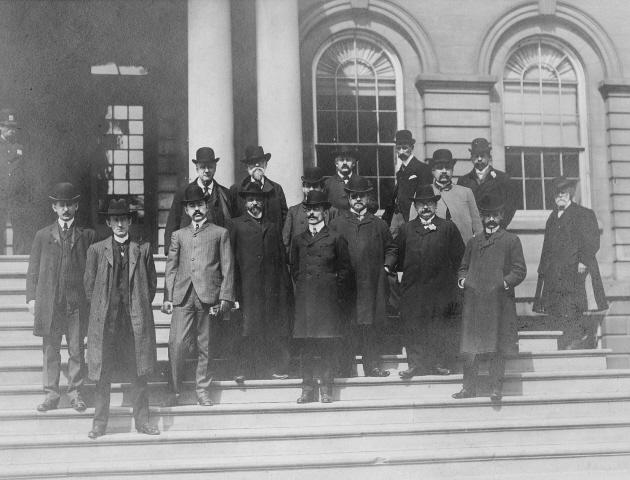
We offered a book prize for the best attempt by a reader to identify the above figures in a photograph forwarded by David DeLucia (Darien, CT, USA). It was a difficult task, even though some masters, such as Marshall, Janowsky, Teichmann and Schlechter, are immediately recognizable and even though, as will be seen, the photograph concerns a famous tournament.
The winner of our contest is Dominique Thimognier (Fondettes, France), and we can do no better than paraphrase his excellent entry, which identifies virtually the entire group.
The photograph shows players in, and organizers of, Cambridge Springs, 1904. Newspaper reports of the time mentioned by Mr Thimognier relate that eight players (Lasker, Chigorin, Teichmann, Janowsky, Schlechter, Marco, Lawrence and Marshall), accompanied by the treasurer of the Carlsbad Club, Victor Tietz, arrived in the United States on the Pretoria. (Mieses followed a few days later on the Graf Waldersee.) This account of their reception appeared on page 16 of the New York Daily Tribune, 19 April 1904:
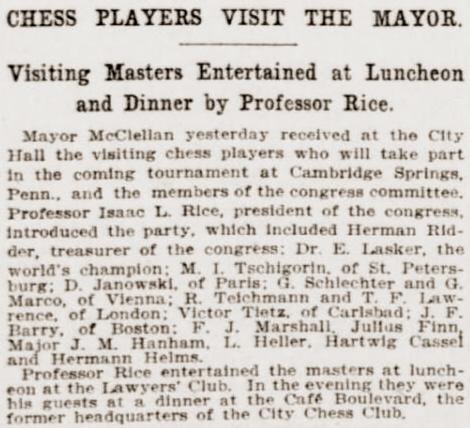
Mr Thimognier also points out that an Internet search confirms that the building in the photograph is the New York City Hall. He offers the following key:
Foreground (left to right): J. Finn, F.J. Marshall, J.F. Barry, M. Chigorin, D. Janowsky, R. Teichmann, V. Tietz, C. Schlechter and J.M. Hanham.
Background (left to right): H. Ridder, I.L. Rice, Em. Lasker, H. Cassel, T.F. Lawrence, G. Marco and N.N. (L. Heller?).
(6891)
Page 436 of the December 1897 American Chess Magazine had this game from the Brooklyn Chess Club Championship, then in progress:
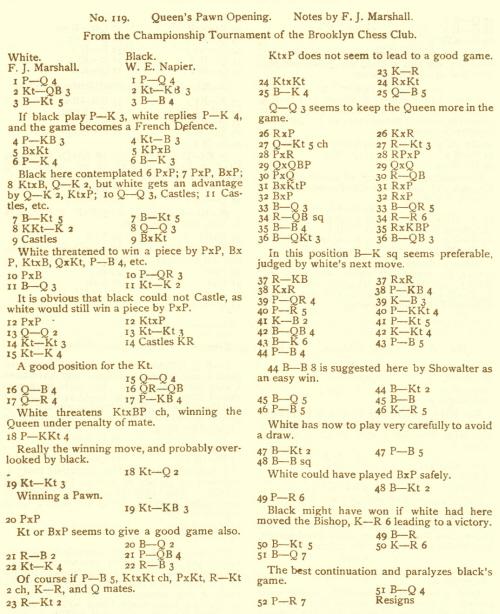
The game was included, also with Marshall’s annotations, on pages 170-171 of Young Marshall by John S. Hilbert (Olomouc, 2002), which noted that it had been played in round one, at the very beginning of December 1897. Another source mentioned was the Brooklyn Eagle of 4 December 1897. Page 267 of the book gave the crosstable of the single round-robin tournament, played in 1897-98. The joint winners were Marshall and Napier, after which Marshall was victorious in a short play-off match in February-March 1898. See also pages 66-67 of another work by Dr Hilbert, Napier The Forgotten Chessmaster (Yorklyn, 1997).
It was therefore a surprise to receive from John Blackstone this cutting from page 5 of the New York Evening Post, 10 December 1897:
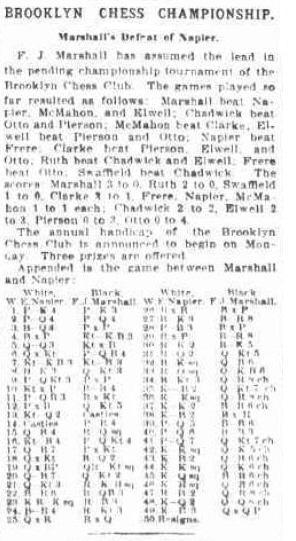
The item is too faint for us to give a transcription with full confidence, but how, in any case, is the existence of two entirely different games to be explained?
(6910)
A contribution from Eduardo Bauzá Mercére (New York, NY, USA):
‘The correct Marshall v Napier score is the one published in the American Chess Magazine and later reproduced in John S. Hilbert’s books on Napier and Marshall. It was also given in Hermann Helms’ column in the Brooklyn Daily Eagle, 4 December 1897, page 4. The game started on Thursday, 2 December and after adjournment was resumed the following day.
The score in the New York Evening Post of 10 December 1897 was the game between R.P. Messiter and H.I. McMahon (published in the Brooklyn Daily Eagle of 7 December 1897, page 5).’
On the basis of that Eagle item (as well as a clearer copy of the New York Evening Post column) our correspondent has provided the Messiter v McMahon game which the Post misattributed to Napier and Marshall:
1 e4 e6 2 d4 d5 3 Bd3 dxe4 4 Bxe4 Nf6 5 Qd3 Nxe4 6 Qxe4 c5 7 Nf3 Nc6 8 Be3 Qb6 9 b3 cxd4 10 Nxd4 Bc5 11 c3 Bxd4 12 cxd4 Qb4+ 13 Nd2 O-O 14 O-O f5 15 Qf4 Rd8 16 Nc4 b5 17 Qc7 bxc4 18 Qxc6 Bd7 19 Qxc4 Rab8 20 Qc7 Qb7 21 Qg3 Rf8 22 Bh6 Bc6 23 Rfe1 Rf6 24 Bf4 Rg6 25 Bxb8 Rxg3 26 Bxg3 Bxg2 27 Re3 Bh1 28 f3 Bxf3 29 Rxe6 Bh1 30 Re2 Be4 31 Rd2 Qb4 32 Be1 Qc3 33 Rad1 Qf3 34 Bg3 Qh1+ 35 Kf2 Qg2+ 36 Ke1 Qh1+ 37 Ke2 Bf3+ 38 Kf2 Bxd1 39 d5 Bf3 40 d6 Bc6 41 d7 Qg2+ 42 Ke1 Qe4+ 43 Kf2 Qf3+ 44 Ke1 Qe3+ 45 Kd1 Bf3+ 46 Kc1 Qc3+ 47 Rc2 Qa1+ 48 Kd2 Qd1+ 49 Kc3 Qxd7 50 White resigns.
(6916)
We continue to seek a primary source for a game which Wenman gave on pages 160-161 of his book Frank J. Marshall (Leeds, 1948):
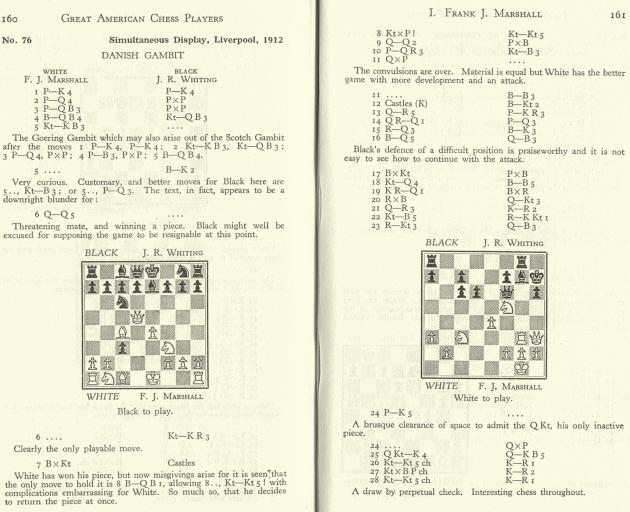
1 e4 e5 2 d4 exd4 3 c3 dxc3 4 Bc4 Nc6 5 Nf3 Be7 6 Qd5 Nh6 7 Bxh6 O-O 8 Nxc3 Nb4 9 Qd2 gxh6 10 a3 Nc6 11 Qxh6 Bf6 12 O-O Bg7 13 Qh5 h6 14 Rad1 d6 15 Rd3 Be6 16 Bd5 Qf6 17 Bxc6 bxc6 18 Nd4 Bc4 19 Rfd1 Bxd3 20 Rxd3 Qg6 21 Qh3 Kh7 22 Nf5 Rg8 23 Rg3 Qf6 24 e5 Qxe5 25 Ne4 Qf4 26 Ng5+ Kh8 27 Nxf7+ Kh7 28 Ng5+ Kh8 Drawn.
The 6 Qd5 line was discussed in C.N.s 3075 and 3076; see page 55 of Chess Facts and Fables.
(6963)
From page 35 of the December 1940 CHESS:
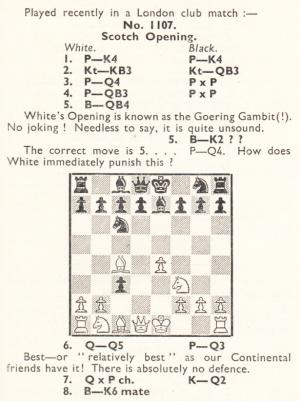
Publication of that game prompted the following:
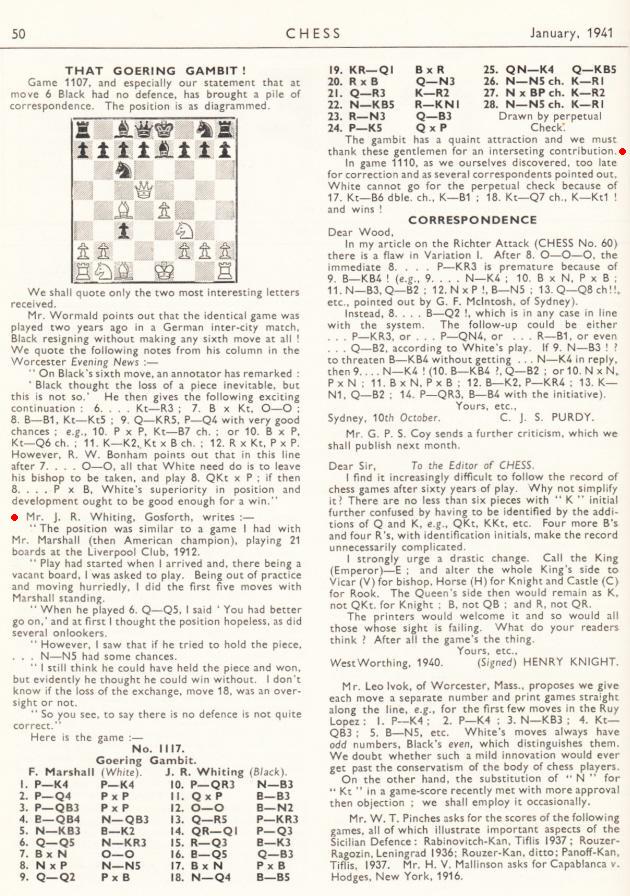
(8345)
Further to our feature article Old Opening Assessments, Olimpiu G. Urcan notes a case of a leading master strongly criticizing an opening shortly before playing it in an important game. Our correspondent sends these extracts from the February 1905 American Chess Bulletin (pages 29-30 and 31 respectively):
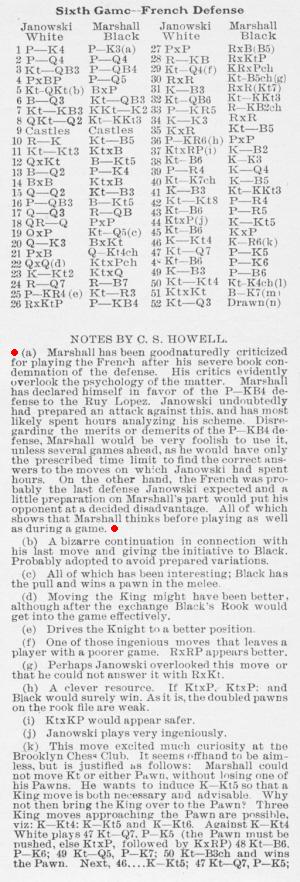
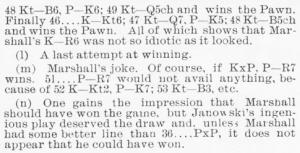
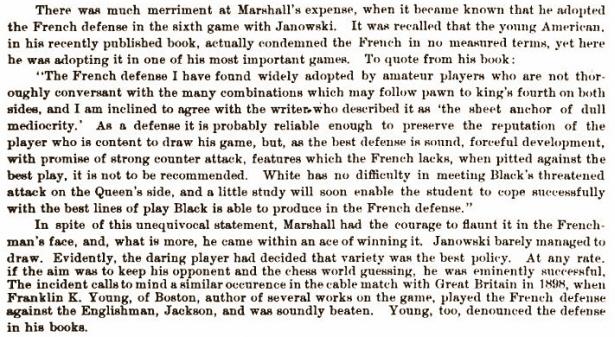
It will be recalled that Marshall played the French Defence (by transposition) in his most famous game, against Levitzky at Breslau, 1912. We add in passing that on page 27 of the February 1935 Chess Review Arnold Denker wrote regarding the conclusion of that game:
‘This is by far the finest and most artistic queen sacrifice that I have ever seen.’
(6984)
John Blackstone draws attention to an article about gambling in which Marshall related experiences in Monte Carlo. It appeared on page 62 of the Otago Witness of 28 June 1905, with an introductory paragraph which stated that the item was reproduced from the New Orleans Picayune. A reporter from the latter newspaper had recorded the reminiscences during Marshall’s visit to New Orleans the previous December.
Caution is required. For example, it was back in 1901 that Janowsky came first in a tournament at Monte Carlo, and his prize was 5,000 francs and an objet d’art (La Stratégie, 15 March 1901, page 88), and not 8,000 francs as stated in Marshall’s account.
(6985)
Russell Miller (Vancouver, WA, USA) has found the original article, on page 23 of the Times-Picayune (New Orleans), 4 December 1904.
(6999)
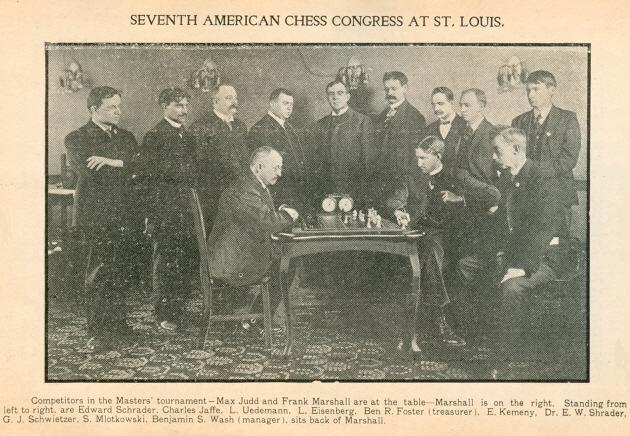
Source: American Chess Bulletin, November page 106.
(6986)
Leon L. Labatt – Frank James Marshall
New Orleans, 13 March 1913
Petroff Defence
1 e4 e5 2 Nf3 Nf6 3 Nxe5 d6 4 Nf3 Nxe4 5 c4 d5 6 Nc3 Nxc3 7 dxc3 Be6 8 Qb3 Nc6 (‘After the game was over, Marshall remarked that perhaps 8...dxc4 was stronger at this point than the text move; but he had been willing to give up the pawn for the development of his pieces.’) 9 Qxb7 Na5 10 Qa6 c6 11 cxd5 Qxd5 12 Be3 Be7 13 Be2 O-O 14 Qd3 Rab8 15 b3 Ba3 16 Rd1 Qxd3 17 Bxd3 Bb2 18 c4 Bc3+ 19 Ke2 Rfe8 20 h3 Rbd8 21 g4 c5 22 Kf1 f5 23 Bxc5
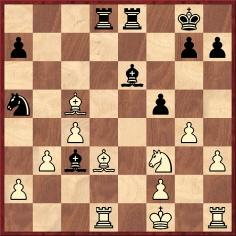
23...Nxc4 (‘One of Marshall’s surprises (called by the masters “Marshall’s swindles”). The knight cannot be captured with advantage.’) 24 gxf5 Nb2 25 fxe6 Nxd3 26 e7 Rd7 27 Ba3 a5
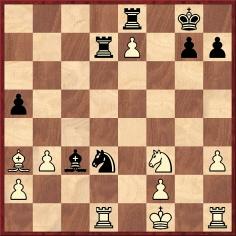
28 Ke2 (‘This is the psychological moment for the king to come into the game, and Judge Labatt showed excellent judgment and daring in bringing his majesty unattended into the enemy’s country. However, the maneuver ending with the play of 37 Kf7 wins the game for White.’) 28...Nf4+ 29 Ke3 Nd5+ 30 Ke4 Nf6+ 31 Kf5 Rd5+ 32 Ke6 Rb5 33 Rd8 Bb4 34 Bxb4 Rxb4 35 Rhd1 h6 36 Ne5 Kh7 37 Kf7 Ne4
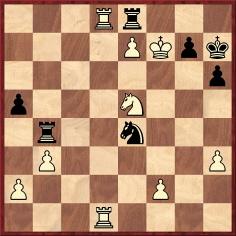
(‘Marshall now sets a neat little trap for White; if here 38 Rxe8 Ng5+ 39 Kf8 Rf4+ 40 Nf7 Rxf7 mate.’) 38 Kxe8 Rb7 39 Kf8 Ng5 40 e8(Q)
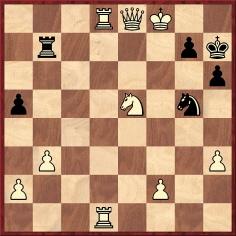
40...Kh8 (Threatening 41...Nh7 mate.) 41 R1d7 Resigns.
Source: American Chess Bulletin, June 1913, pages 138-139, with a correction on page 151 of the July 1913 issue. The notes cited came from the New Orleans Times-Democrat.
The conclusion of this (individual) game was given in C.N. 1291. See pages 14-15 of Chess Explorations.
(7026)
Our collection includes a copy of Marshall’s book Modern Analysis of the Chess Openings (Amsterdam, 1912 or 1913), inscribed by him in Pittsburgh on 18 April 1913:
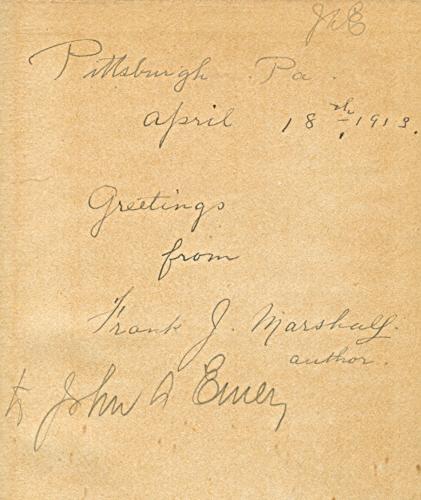
(7027)
Olimpiu G. Urcan submits a cutting from page 18 of the Niagara Falls Gazette of 16 August 1926:
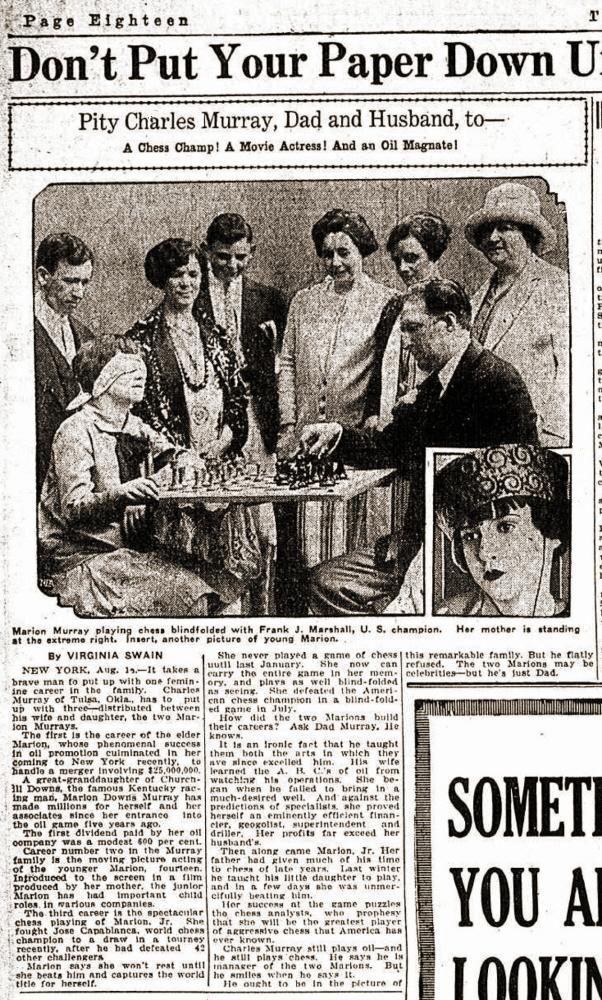
Our correspondent adds:
‘H.R. Bigelow’s column in the New York Evening Post of 30 June 1926 noted that Marion Murray was active at the Marshall Chess Club, playing, for instance, in a rapid transit handicap tournament and winning third prize behind A. Pinkus and C.S. Howell:
“The third prize was won by Miss Marion Murray, aged 12, of Tulsa, Okla. Champion Marshall was impressed by her grasp of the game and remarked afterward that with a little careful coaching she might easily become a serious rival to the present American lady champion, Mrs Natalie Nixdorff”.’
(7070)
On page 16 of Comparative Chess (Philadelphia, 1932) Frank Marshall referred to Zukertort as ‘a former champion of the world’ (see page 297 of A Chess Omnibus).
Russell Miller draws attention to this passage on page 5 of the Sedalia Weekly Bazoo of 5 February 1884:
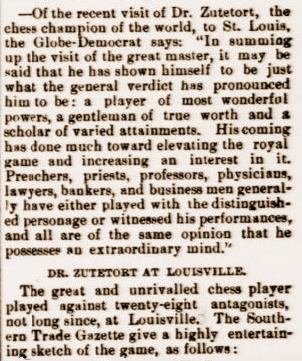
We note that the text quoted from the Southern Trade Gazette, which also referred to a 12-board blindfold exhibition by Zukertort in Louisville on 26 December 1883, ended as follows:
‘When Mr Lovenhart opened 1 P-KKt4 the doctor waited a full minute before he made his reply. A bystander suggested that Zukertort was not thinking of the game but merely trying to form a mental image of the man who would open a game in that manner.’
(7112)
John Blackstone points out this letter on page 11 of the New York Evening Post, 5 October 1910:
‘My dear Blackburne,
I notice with a great deal of pleasure the movement which has been set on foot to commemorate the completion of 50 years of chess life in your career, and I want to add my personal good wishes to the many that will pour in upon you as the brilliant and much-loved representative of British chess. Your style of play, which to my mind should be cultivated much more than it is, has always appealed to me, and I believe I have profited much by a study of your famous games. Whether I have lost or won I have thoroughly enjoyed the games we have had together and both because of your standing in the chess world and my own regard for you I value as such the privilege of having met you so often face to face across the chequered board.
Regretting my inability to greet you personally on this auspicious occasion and hoping you may long survive in the interest of the cause you espoused and for the gratification of your man [sic], friends and admirers I remain yours very sincerely
(Signed) Frank J. Marshall
New York, 29 September.’
The result of the jubilee testimonial for Blackburne was announced on page 322 of the August 1912 BCM:
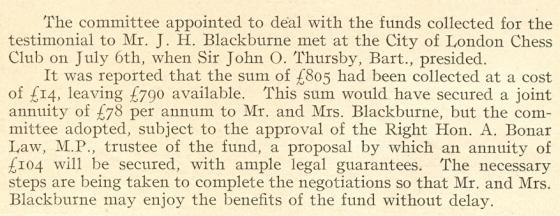
(7114)
1 d4 d5 2 Nf3 c5 3 c4 dxc4 4 e3 e6 5 Bxc4 Nf6 6 O-O Nc6 7 Nc3 Be7 8 Qe2 O-O 9 dxc5 Bxc5 10 a3 Bd7 11 b4 Be7 12 Bb2 Rc8 13 Rfd1 Qb6 14 Rac1 Rfd8 15 Na4 Qc7 16 b5 Na5 17 Bxe6 Bxe6 18 Rxc7 Rxd1+ 19 Qxd1 Rxc7
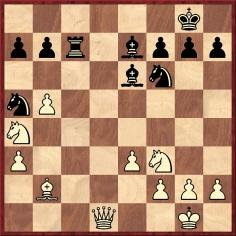
Noting that databases have these moves as a game in the 1912 Marshall v Janowsky match, Pierre Bourget (Quebec, Canada) asks whether the game really ended at move 19 (as a win for White).
The answer is no. The above is less than half of the game, as Janowsky did not resign until move 45. The full score (eighth match-game, Biarritz, 12 September 1912) is on pages 440-441 of La Stratégie, November 1912, the additional moves being: 20 b6 axb6 21 Nxb6 Rc6 22 Na4 Nc4 23 Bxf6 gxf6 24 Nd4 Rc7 25 h4 Bd7 26 Qf3 Ne5 27 Qd1 Bxa3 28 Nc2 Bf8 29 Nb6 Bg4 30 f3 Be6 31 Nd4 h5 32 Nxe6 fxe6 33 Qd8 Rc1+ 34 Kf2 Kf7 35 Nd7 Be7 36 Nxe5+ fxe5 37 Qh8 Bxh4+ 38 Ke2 Bg3 39 Qxh5+ Kf6 40 Qh3 Be1 41 Qh6+ Kf7 42 g4 Bb4 43 g5 Be7 44 g6+ Ke8 45 Qh8+ Resigns.
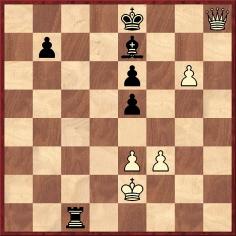
(7455)
‘An interesting ending’ was Marshall’s conclusion in his notes to the following game, played against Frank Altschul (1887-1981), a prominent banker and philanthropist:
Frank Altschul – Frank James Marshall
Simultaneous exhibition, New York, 3 August 1938
Ruy López
1 e4 e5 2 Nf3 Nc6 3 Bb5 a6 4 Ba4 Nf6 5 O-O Be7 6 c3 b5 7 Bc2 O-O 8 d4 d6 9 h3 h6 10 d5 Nb8 11 Be3 Nbd7 12 Nbd2 Bb7 13 a4 c6 14 dxc6 Bxc6 15 axb5 axb5 16 Rxa8 Qxa8 17 Qa1 Qb7 18 Qa7 Qxa7 19 Bxa7 Ra8 20 Be3 Ra2 21 Rb1 d5 22 Bb3 Ra8 23 exd5 Bxd5 24 Bd1 Ne4 25 Nxe4 Bxe4 26 Rc1 f5 27 Nd2 Bc6 28 b4 f4 29 Bc5 Nxc5 30 bxc5 Bxc5 31 c4 b4 32 Nb3 Be7 33 c5 Ra3 34 f3 Ba4 35 c6 Bd6 36 Nc5 Bxd1
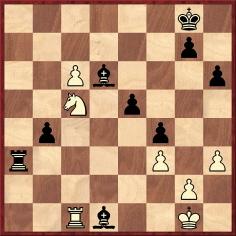
37 Ne4 Bc7 38 Rxd1 b3 39 Rb1 Kf7 40 Nd2 Bb6+ 41 Kf1 Ra2 42 Rxb3 Rxd2 43 Rxb6 Rc2 44 Rb7+ Kf6 45 Rc7 g5 46 Rc8 Ke6 47 Rh8 Rxc6 48 Rxh6+ Kd5 49 Rh5 Drawn.
Source: Chess Review, September 1938, page 221.
A small picture featuring Altschul was published on page 259 of the November 1938 Chess Review:
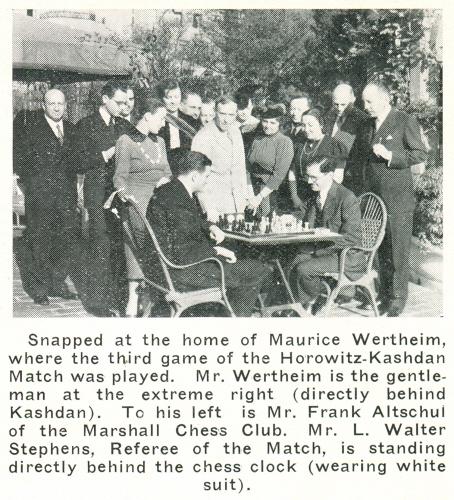
(7171)
Per Skjoldager has sent us a game which will be appearing in the book he has written with Jørn Erik Nielsen, Aron Nimzowitsch On the Road to Chess Mastery, 1886-1924 (C.N. 7108). It was a ‘serious game’ played at the Börsen Café, Riga, and the co-authors believe that it has not been published until now, except in the Riga press of the time.
Aron Nimzowitsch – Frank James Marshall
Riga, 26 January 1912 (new style)
Petroff Defence
(Annotations by Nimzowitsch, translated by Per Skjoldager and Jørn Erik Nielsen)
1 e4 e5 2 Nf3 Nf6 3 Nxe5 d6 4 Nf3 Nxe4 5 Nc3 d5 Involves a promising sacrifice of a pawn. Normally 5...Nxc3 6 dxc3 Be7 7 Bd3 is played, with a somewhat better game for White. 6 Qe2 Be7 7 Nxe4 dxe4 8 Qxe4 O-O 9 Bc4 Bd6 10 O-O Re8 11 Qd5 The introduction to a faulty combination. 11 Qd3 was better. 11...Be6! 12 Qxb7 Bxc4 13 Qxa8
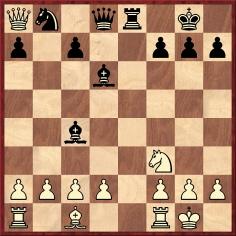
13...Bd5! White had overlooked this move in his calculations. Now, he loses his queen but obtains quite a lot of wood in return. Bad was 13...Bxf1 14 Kxf1 Qe7 15 g3 c6 16 d3 Qd7 17 Be3 and the queen will be saved. Also 13...Bc5 was less strong than the text move since 14 d4 (not 14 Qb7 because of 14...Bb6!) 14...Bb6 15 Bg5 f6 16 Rfe1! Rxe1+ 17 Rxe1 fxg5 18 Qe4 and White has two pawns for the exchange and a good game. 14 Qxd5 Bxh2+ 15 Kxh2 Qxd5 16 d3 h6 17 Bd2 A fine move! White intends to put the black knight out of action by means of Bc3, i.e. to deprive him of the squares f6 and e5. 17...Nd7 18 Bc3 Re6 19 Rae1 Rg6 20 Re3 Nf6 The a2 pawn is not worth much since the already weak pawns on the black queen’s flank then become even more vulnerable (after Ra1). 21 Bxf6 Rxf6 22 b3 Qa5 23 a4 Qc3 24 Re2
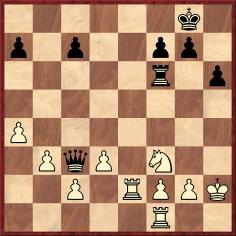
24...Re6! 25 Rfe1 Rc6! A fine point! The rook should not be immediately placed on c6 because of 24...Rc6 25 Re8+ Kh7 26 Ne5 Rc5 27 Nd7 and perpetual check. With the rook placed at e1, Ne5 is not possible any more because of Qxe1. 26 Re8+ Kh7 27 R1e4! Qb2 28 Ne1 Rxc2 This must, if at all, happen immediately; otherwise 29 Rc4 Rxc4 30 dxc4 with a bombproof position. This attempt to split the pawns by means of the sacrifice of the exchange only fails to the vivid defence by White. 29 Nxc2 Qxc2 30 Rf4! The only move in order to avoid the loss of a pawn.
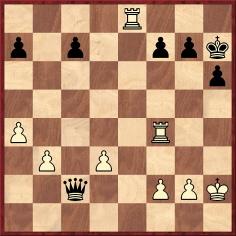
30...Qc5! A beautiful protection. 31 Re1! a5 32 Kg1 Qc3 33 Rf1 Qxb3 34 Rc4 Qxd3 35 Rxc7 Qd4 36 Rxf7 Qxa4 37 Rf3! The isolated a-pawn cannot be saved after this move. 37...Qa2 38 Re1 a4 39 Ree3 Qb2 40 Ra3 Qb4 41 Ra1! Qd4 42 Rfa3 The game could have been drawn at this point. White still made attempts to win the game by attacking the g-pawn from behind, which Black however knew how to parry with the threat of perpetual check. 42...Qe5 43 Rxa4 Drawn.
Source: page 3 of Feuilleton-Beilage der “Rigaschen Rundschau”, 10 February 1912 (new style).
Mr Skjoldager adds that Nimzowitsch’s encounter with Capablanca in Riga (game 22 in My Chess Career) was also played at the Börsen Café, Sandstrasse 11 (now Smilsu lela), as were the Cuban’s two simultaneous displays around the same time. In the photograph below, which dates from the early twentieth century, our correspondent notes that the Café is the white building on the left, behind the driver of the horse and carriage:
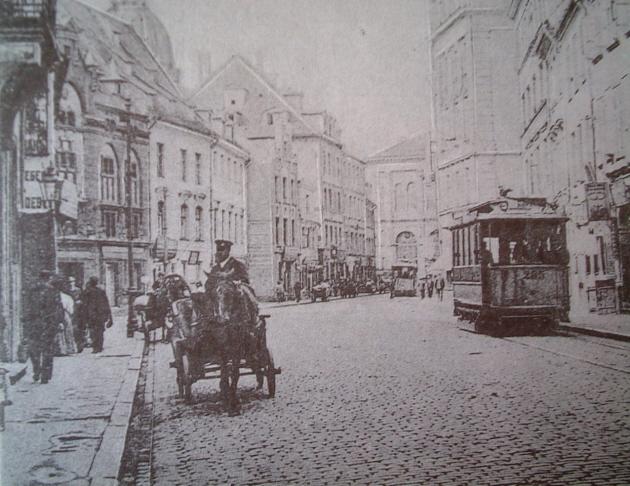
(7310)
The last game in Frank Marshall, United States Chess Champion by A. Soltis – see pages 361-362 – was played by correspondence against Ed Robson and is said to have ended ‘21 Rd1 g5! White resigns’. However, the following was published in the Marshall memorial issue of Chess Review (December 1944, pages 28-29):
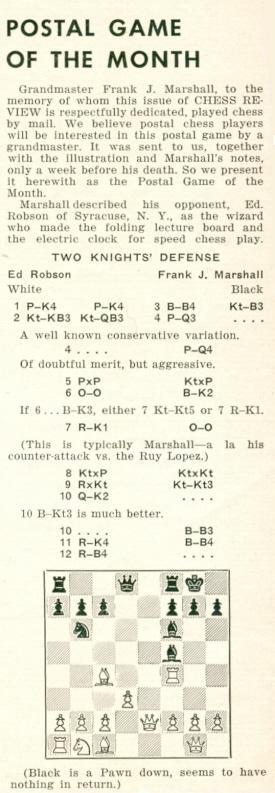
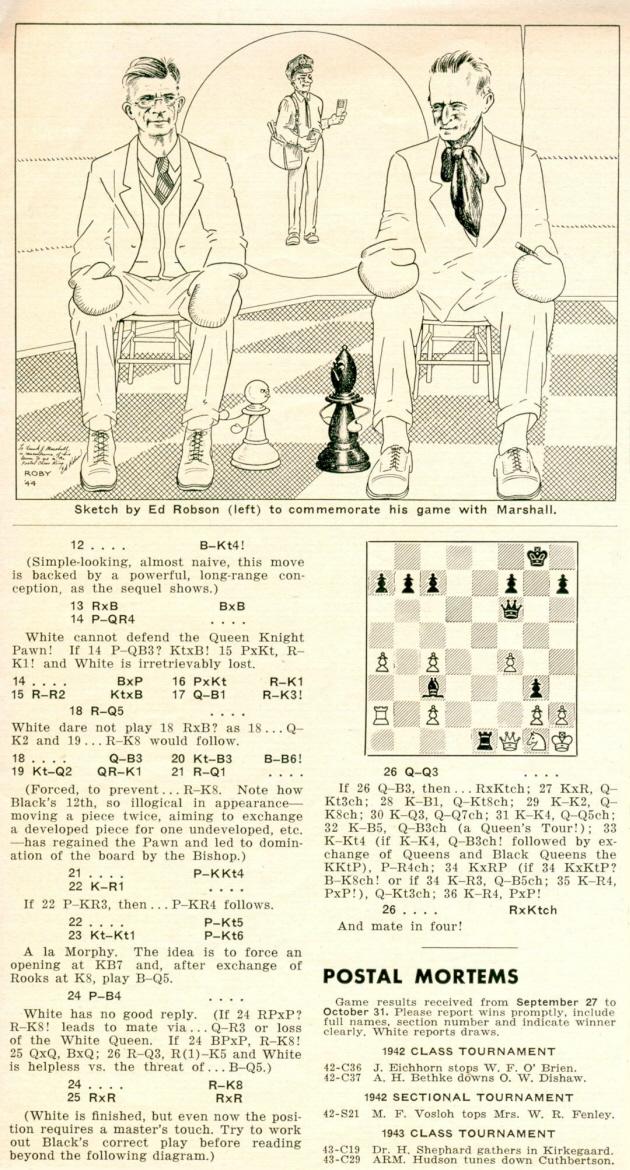
(7374)
Pierre Bourget notes this photograph on page 230 of the December 1941 Chess Review:
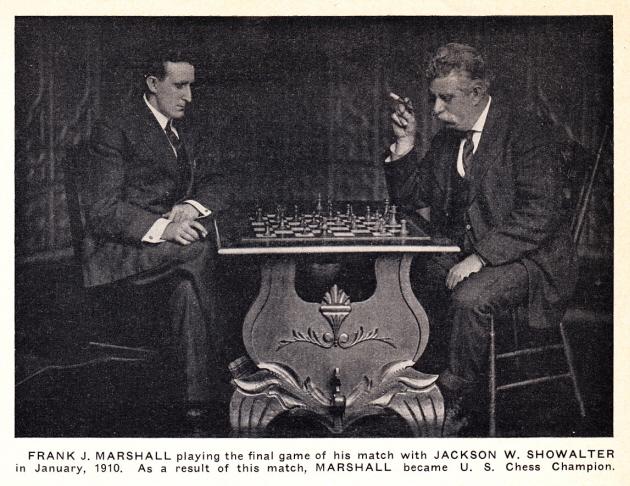
In fact, the match ended on 26 November 1909 (American Chess Bulletin, January 1910, page 7), and the board position bears no relation to the final match-game (in which Marshall was White). The photograph also appeared on page 17 of Marshall’s autobiographical games collection (with a reference to 1909).
From page 9 of the January 1910 Bulletin:
‘With the intention, it is understood, of publishing the entire set of games for the United States championship in book form, Marshall has permitted only a few of the scores of the games to see the light of day. While everyone concedes the right to Marshall to create a possible source of revenue for himself, yet opinion is divided as to whether his course is beneficial to chess in general, and, therefore, to his own interests, or not.’
Marshall did not produce a book on the match.
(7488)
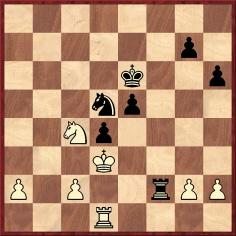
Black has just played 32...Ne7-d5, and the game (Marshall v Treybal, played in the penultimate round of the Baden-Baden tournament, on 13 May 1925) was agreed drawn. In his analysis on page 197 of N.I. Grekov’s tournament book N.M. Zubarev wondered about Treybal’s peacefulness in such an advantageous position:
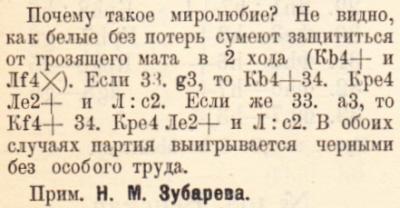
From page xi of Tarrasch’s tournament book:
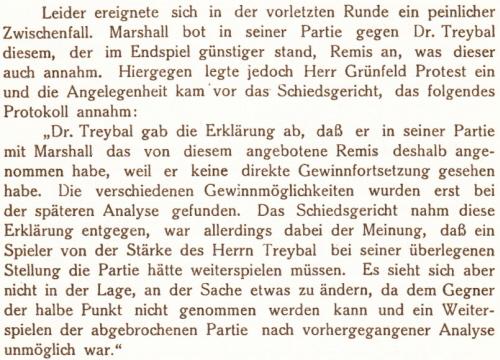
An account of the incident was provided by Hans Kmoch at the start of an article, ‘Farce Versus Farce’, on page 328 of the November 1962 Chess Review:

(7855)
John Blackstone notes a photograph of Roy T. Black and Frank J. Marshall in the 13 March 1910 issue of the New York Herald:
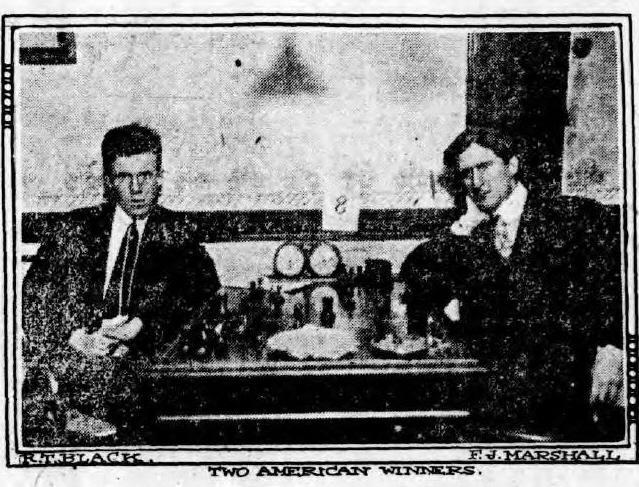
The occasion was the United States versus Great Britain cable match on 11 and 12 March, a ten-board contest in which Black and Marshall were the only victors on the American side.
(7924)
John Blackstone has forwarded an article about Frank Marshall by Harvey T. Woodruff on page B3 of the Chicago Daily Tribune, 31 January 1915. It discusses the US champion’s departure from Mannheim, 1914 but also has some information on his family and early life, such as the following:
‘Marshall was born 37 years ago – on 21 August 1877, to be exact – in New York City, where his father was engaged in the flour business. He is of English-Scotch descent. The head of the family was born in England and the mother, who is still living, is Scotch. When Frank was eight years old his father removed to Montreal, where three brothers were added to the family. Two of them are in the railroad business in Minneapolis, while another is located in Kansas City ...’
Clarification is sought regarding the discrepancy over Marshall’s birth-date, which was 10 August 1877 according to page 7 of his book Chess Openings (Leeds, 1904) and page 3 of My Fifty Years of Chess (New York, 1942). On the other hand, 21 August 1877 was the date given on, for instance, page 574 of the March 1898 American Chess Magazine, on page 283 of the December 1910 American Chess Bulletin and, even, on page 16 of Marshall’s book Chess Masterpieces (New York, 1928), in a biographical section by J.C.H. Macbeth.
(8013)
Russell Miller notes that 10 August 1877 was the date given for Frank Marshall’s birth in the 1942 World War II Draft Regulation Cards.
Further evidence in favour of 10 August 1877 is Marshall’s passport application, shown in C.N. 7885 (see below).
(8022)
Below is part of C.N. 7885, supplied by Olimpiu G. Urcan:
5 feet 10 inches – Source: Passport Application (1914), National Archives and Records Administration (NARA); Washington, DC; Passport Applications, 2 January 1906-31 March 31 1925; Collection Number: ARC Identifier 583830/MLR Number A1 534; NARA Series: M1490; Roll: 205. Via ancestry.com.
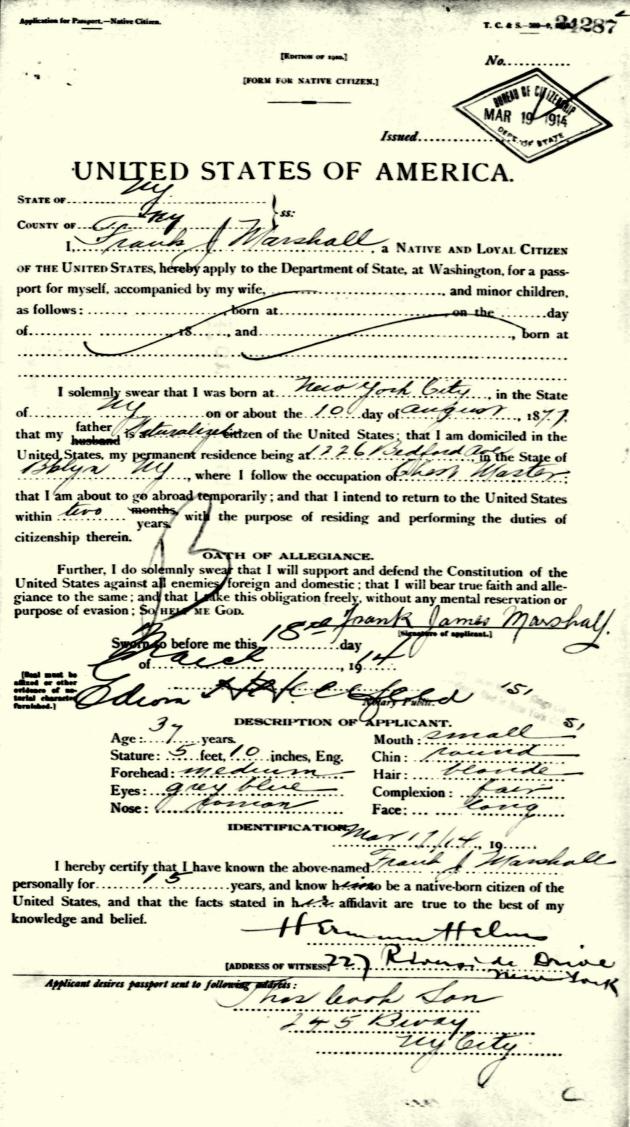
Dwight Weaver (Southaven, MS, USA) draws our attention to his article World Chess Championship in Tennessee – 1907, which includes an account of Marshall’s protest over the use of stop-watches rather than a chess clock.
(8641)
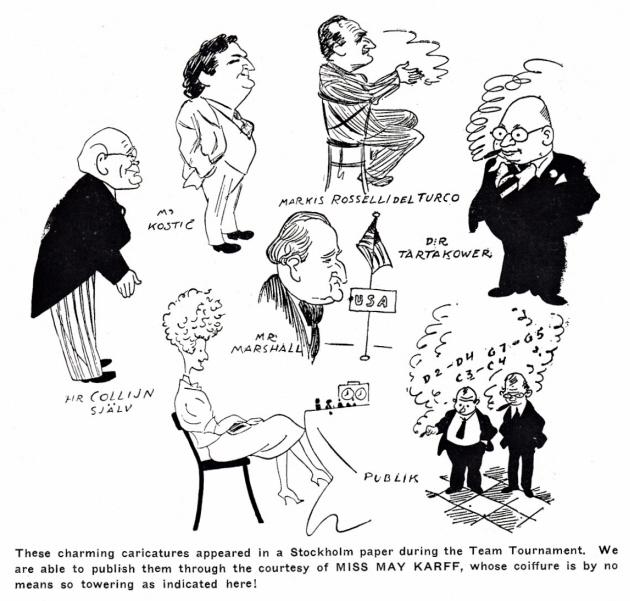
Chess Review, December 1937, page 277
(8756)
Frank Brady (New York, NY, USA) informs us that he has been commissioned to write an article on the history of the Marshall Chess Club, to mark its centenary in 2015. We shall be pleased to pass on to Dr Brady, who is President Emeritus of the Club, any messages from readers who can provide memorabilia, photographs, letters or other information.
Page 210 of the November 1915 American Chess Bulletin reported the founding of the Club, then known as ‘Marshall’s Chess Divan’, at 70 West Thirty-Sixth Street, New York, ‘just back of Herald Square and within a stone’s throw of one of the busiest sections of Broadway’.
(8765)
A simultaneous game from pages 106-107 of Schachjahrbuch für 1905 I. Teil by L. Bachmann (Ansbach, 1905):
Frank James Marshall – Eduard Dyckhoff
Augsburg, 7 April 1905
Max Lange Attack
1 e4 e5 2 d4 exd4 3 Nf3 Nc6 4 Bc4 Nf6 5 e5 d5 6 Bb5 Bb4+ 7 c3 dxc3 8 bxc3 Qe7 9 O-O Ne4 10 cxb4 Be6 11 Nd4 O-O 12 Nxc6 bxc6 13 Bxc6 Rad8 14 a3 f5 15 Be3 f4 16 Bxa7 f3 17 gxf3 Qg5+ 18 Kh1 Bh3 19 Rg1 Qxe5 20 Bd4
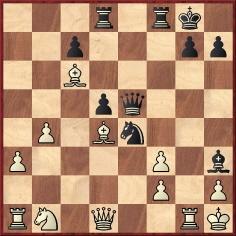
20...Rxf3 21 Rxg7+ Qxg7 22 Bxg7 Nxf2+ 23 Kg1 Nxd1 24 Nd2 Rd3 25 Rxd1 Kxg7 26 a4 Bg4 27 Ra1 Rxd2 28 a5 Rf8 29 a6 d4 30 a7 Rd1+ 31 Rxd1 Bxd1 32 a8Q Rxa8 33 Bxa8 Kf6 34 Kf2 Ke5 35 Ke1 Bc2 36 Kd2 Be4 37 Bxe4 Kxe4 38 h4 c6 39 h5 d3 40 Kd1 Kd4 41 Kd2 h6 42 Kd1 Kc3 43 Kc1 Kxb4 44 White resigns.
The display (+26 –3 =0) was reported on page 156 of the May 1905 Deutsche Schachzeitung.
(8795)
Pete Tamburro (Morristown, NJ, USA) asks whether information is available about a photograph which he bought many years ago:
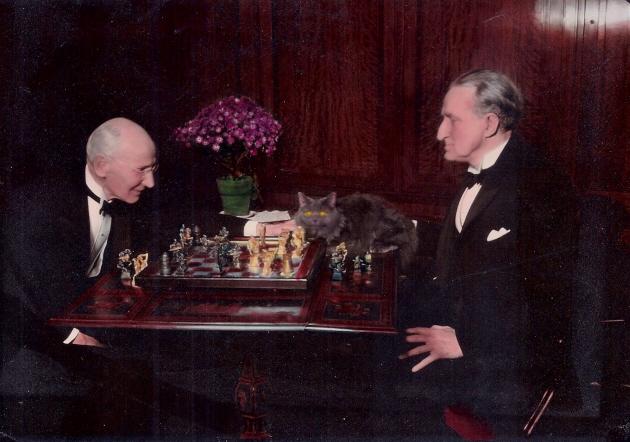
(8799)
It may be imagined that ‘instant books’ on chess matches are a modern development, but the first sentence in the Foreword to Tarrasch’s 62-page work Der Schachwettkampf Marshall-Tarrasch im Herbst 1905 (Nuremberg, 1905) reported that the manuscript was ready for printing one week after the match ended and that the book appeared a fortnight later:
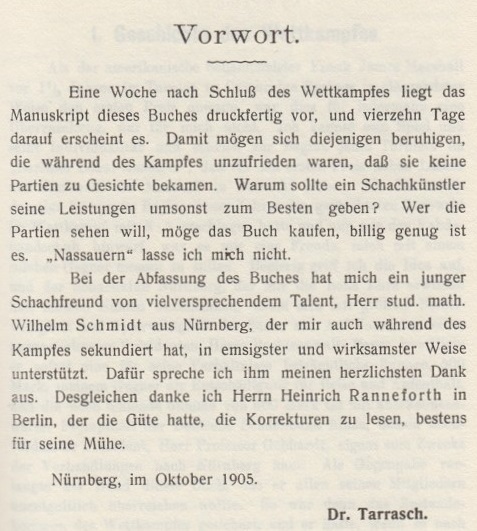
(8914)
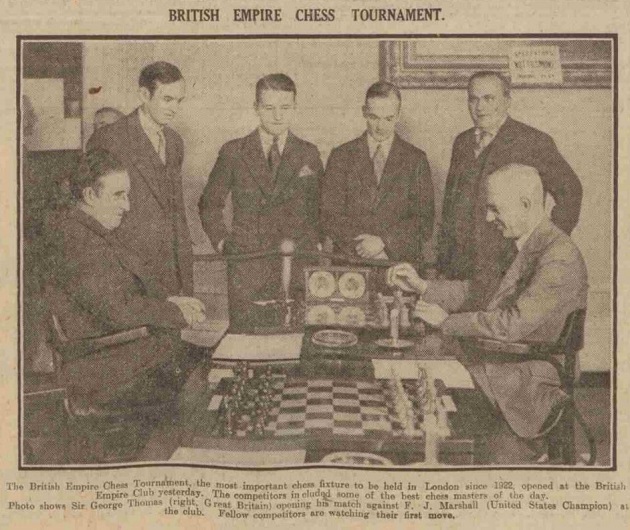
Dundee Evening Telegraph, 11 October 1927, page 1.
(8960)
From Olimpiu G Urcan:
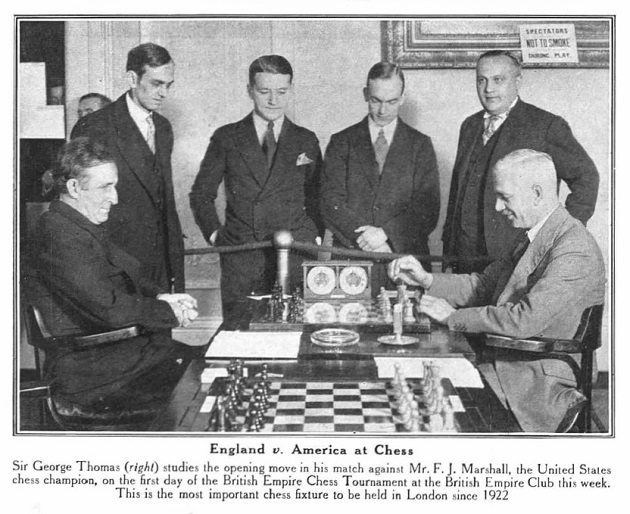
The Graphic, 15 October 1927, page 92
A slightly different version of this photograph exists, and page 202 of A History of Chess by Harry Golombek (London, 1976) had another shot, taken from the opposite direction and showing a cameraman.
(10302)
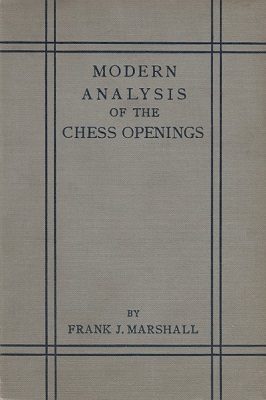
Modern Analysis of the Chess Openings by F.J. Marshall (Amsterdam, 1912/13) has been mentioned a number of times (see, for instance, pages 273-274 of Kings, Commoners and Knaves and page 256 of Chess Facts and Fables). Below, and not for the squeamish, is a complete section of Marshall’s work, from pages 15-17:
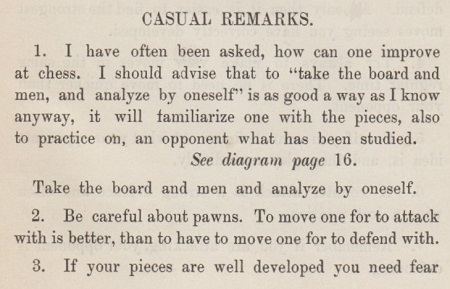
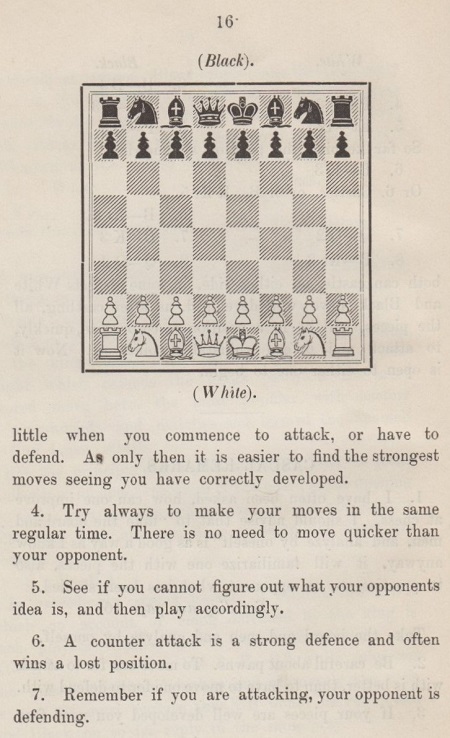
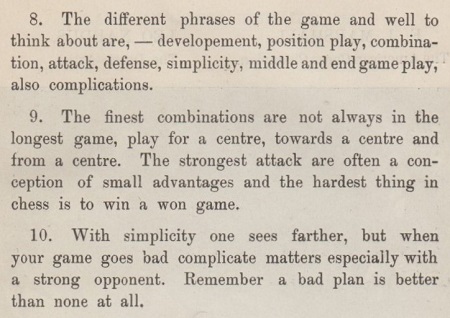
C.N. 2019 (see page 383 of Kings, Commoners and Knaves) extracted Marshall’s final remark, ‘a bad plan is better than none at all’. That advice can be traced back to the nineteenth century, e.g. on page 30 of the anonymous work The Chess Player’s Hand-Book (Philadelphia and New York, 1849):
‘Be careful, then, in all commencements of this super-excellent game, to have a prescribed plan – better have a bad plan than no plan at all.’
On page 210 of the April 1978 Chess Life & Review Julio Kaplan wrote:
‘... all good players agree on one thing: even a bad plan is better than no plan at all.’
How much truth lay in that remark in 1978 is impossible to say, but we wonder whether many chess authorities today would write in such terms.
(9091)
See also Chess Planning.
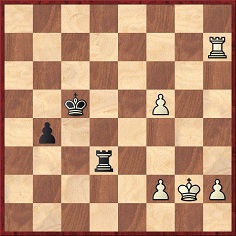
White to move
This position was discussed at length by Capablanca in the section ‘The danger of a safe position’ in Chess Fundamentals (London, 1921). As mentioned on page 22 of our book about him, he had analysed the ending on pages 117-118 of the Chess Weekly, 8 January 1910:
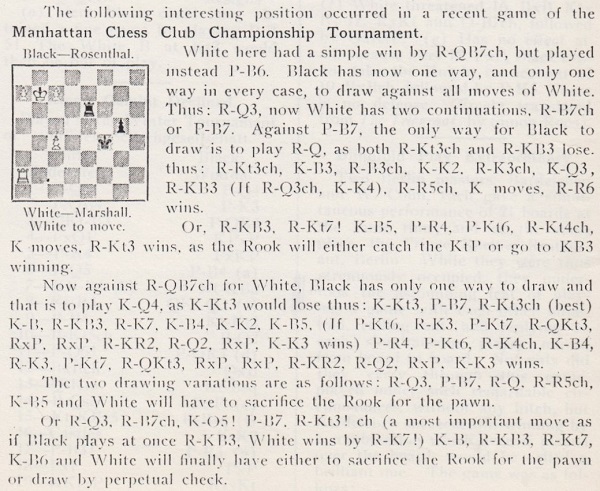

Page 310 of our book also noted that the following year Capablanca examined the position in a lecture in Buenos Aires, as reported on pages 54-56 of the Revista del Club Argentino de Ajedrez, April-June 1911:
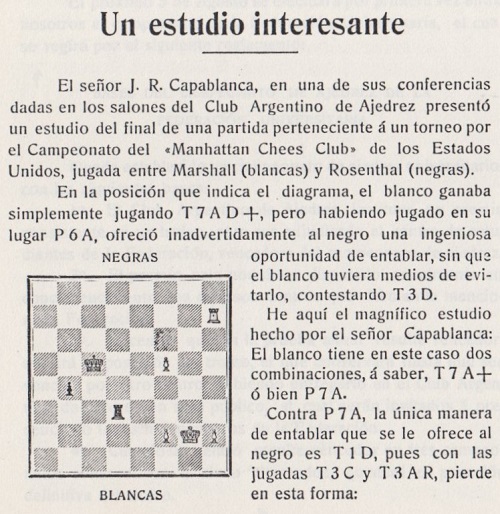
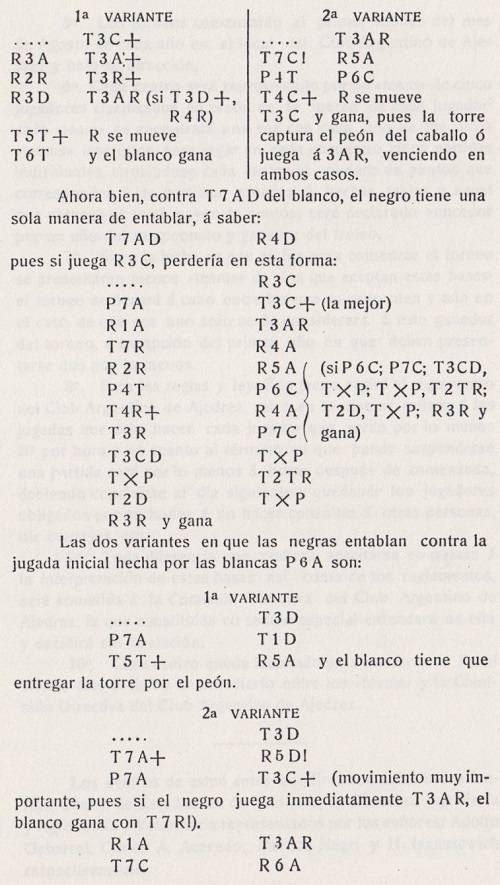
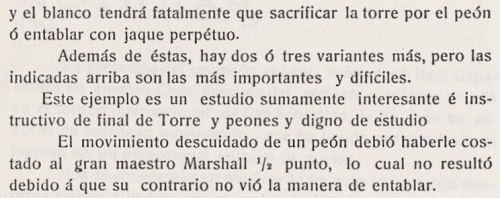
However, an item in T.R. Dawson’s Endings column on pages 297-298 of the July 1927 Chess Amateur should be noted:

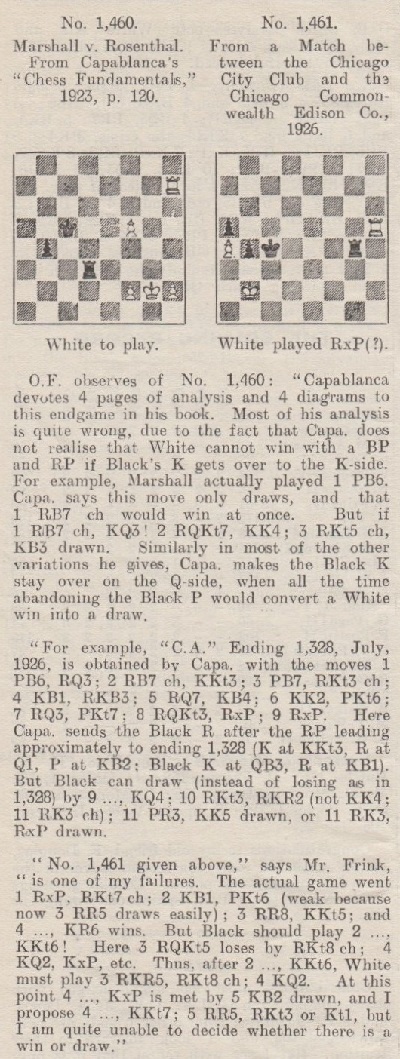
Below is the material referred to in the penultimate paragraph, from Dawson’s column on pages 297-298 of the July 1926 Chess Amateur:
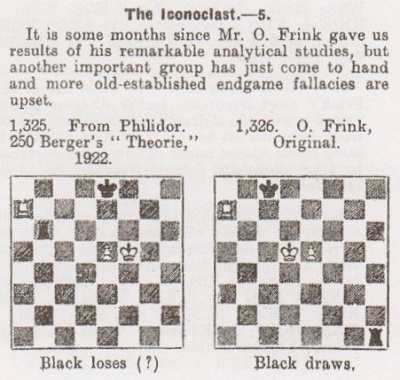

Are the analytical and theoretical observations of Orrin Frink correct, and can the full score of the Marshall v Rosenthal game be found?
(9177)

White to move
From Karsten Müller (Hamburg, Germany):
‘In general, Orrin Frink is right. The position is drawn. The move 1 Rc7+ given by Capablanca in Chess Fundamentals is indeed met by 1...Kd6 2 Rb7 Ke5 3 Rb5+ Kf6=, as Frink states. Another line runs 1 Rb7!? Rd5 2 f6 Rg5+ 3 Kf1 Rf5 4 f7 Kd6 5 Rxb4 Ke7 6 Rb7+ Kf8= despite White’s three extra pawns.
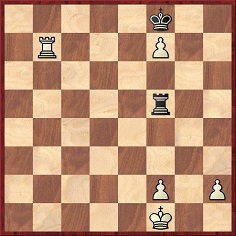
However, Frink makes a mistake in the line 1 f6 Rd6 2 Rc7+. Now, Black must play the active 2...Kd4, when he manages to draw in the resulting pawn race, or 2...Kd5. But 2...Kb6? loses owing to 3 f7 Rg6+ 4 Kf1 Rf6, and now 5 Re7 Kc5 6 Rb7 Kd5 7 h4 Rf4 8 h5 Ke6 9 h6 Rxf7 10 h7 and White wins.’
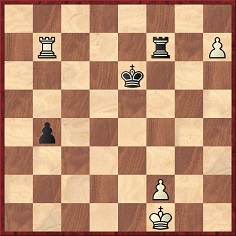
(9188)
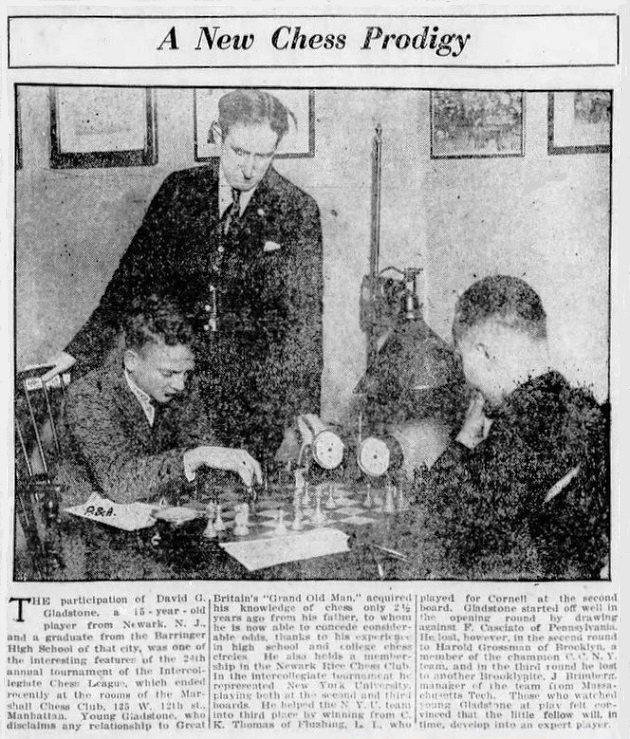
Brooklyn Daily Eagle, 8 January 1923, page 23
Game 127 in My Fifty Years of Chess by Frank J. Marshall (New York, 1942) was played against David Gladstone nearly a decade later, a team match game published on page B7 of the New York Evening Post, 14 May 1932.
(9199)
From page 72 of the April 1920 American Chess Bulletin:

Hermann Helms also related the story in the New York Evening Post, 21 February 1920, page 12. On page 11 of the 31 January 1920 edition he had announced that the display in Allentown was to take place that evening. More details are sought.
The story about ‘a dumb person’ on page 391 of Garry Kasparov on My Great Predecessors Part I (London, 2003) may be recalled dolefully.
(9208)
Page 86 of our book on Capablanca related his reaction to having his US record for simultaneous play broken by Marshall in Portland, OR on 23 February 1915 (+77 –4 =11), as discussed on pages 48-49 of the March 1915 American Chess Bulletin.
A report on Marshall’s exhibition was published on page 8 of the Oregon Daily Journal, 24 February 1915, and the large feature below comes from page 3 of the 28 February 1915 edition of the Oregan Sunday Journal:
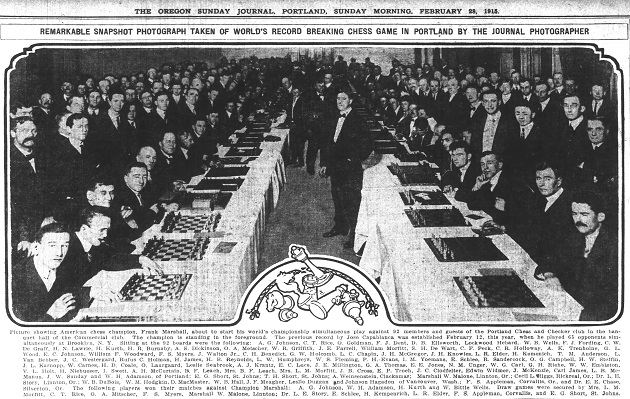
Larger version, including a report
The game given in the report, a draw against Marshall W. Malone, was also published in the above-mentioned issue of the Bulletin, together with three others also beginning with the Danish Gambit.
(9228)
Russell Miller points out with respect to the report on page 26 of the February 1931 American Chess Bulletin that F.J. Marshall’s 92-board simultaneous display was in Portland, Oregon, and not in Washington State.
For further information on the exhibition, including a photograph, see C.N. 9228. Finding game-scores remains difficult.
(11453)
A fine copy of the photograph in C.N. 6154 was published opposite page 72 of Comparative Chess by Frank J. Marshall (Philadelphia, 1932):
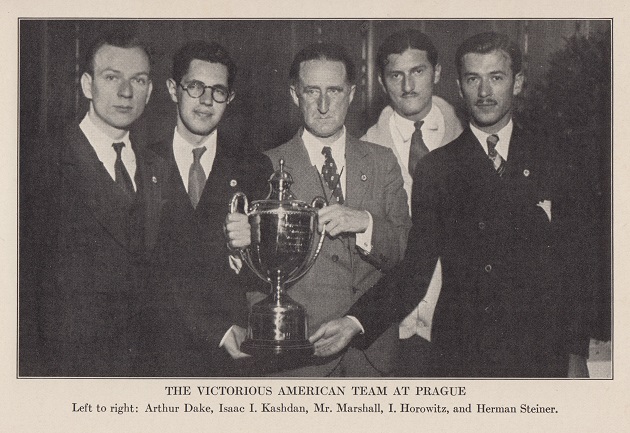
(9592)
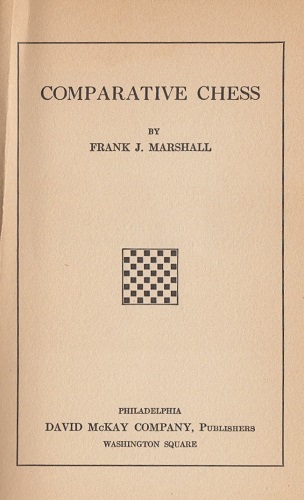
On page 27 of Comparative Chess Marshall gave some singularly unhelpful notes to the start of the game between ‘Makaarzyk’ (Makarczyk) and Steiner, Prague International Team Tournament, 1931:
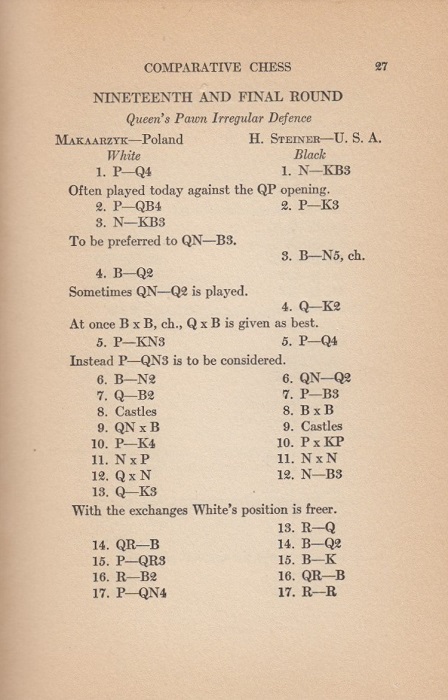
(9523)
Thomas Niessen (Aachen, Germany) writes:
‘There are discrepancies in the score of the game between Frank Marshall and Emanuel Lasker in the Paris tournament, 28 May 1900, and particularly at moves 17 and 28.
Position after 16...Be4
When the game was published on page 9 of the Times, 6 June 1900, the continuation was 17 Bc3 f6 18 f3.
Those same moves were in the 10 June 1900 editions of the New York Times (page 10) and the Brooklyn Daily Eagle (page 9), as well as two Prague newspapers, Bohemia (page 17) and Národní listy (page 13). Other British and American newspaper followed suit.
However, when Leopold Hoffer published the game in the Field on 9 June 1900 White’s 17th and 18th moves were inverted, becoming 17 f3 f6 18 Bc3.
Position after 17 f3 f6
No note was added, but, when it gave that version of the score, page 8 the Pall Mall Gazette, 12 June 1900 stated, “The simplest is always the best” and mentioned that 18 fxe4 fxe5 19 Bc3 could be played.
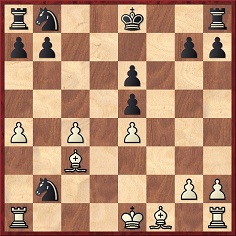
Position after 19 Bc3
The question, therefore, is whether White played 17 Bc3 (17...f6 18 f3) or 17 f3 (17...f6 18 Bc3). In the descriptive notation the difference is slight (B-B3 and P-B3), but the move-order 17 f3 f6 18 Bc3 would mean that a major oversight was committed by both Lasker (when he played 17...f6) and Marshall.
The 17 Bc3 f6 18 f3 version appeared in the Tijdschrift van den Nederlandschen Schaakbond, June 1900, pages 134-135, and the Deutsche Schachzeitung, July 1900, pages 208-209, as well as in Samuel Rosenthal’s Traité des échecs et Recueil des Parties jouées au Tournoi International de 1900 (Paris, 1901), pages 297-298.
On the other hand, the July 1900 issues of the BCM, pages 272-273, and the Wiener Schachzeitung, pages 145-146, had 17 f3 f6 18 Bc3. In the BCM the game was annotated by Richard Teichmann; he had no comments after Black’s 16th move, and the possible win (18 fxe4) went unremarked. However, the annotator in the Wiener Schachzeitung mentioned that stronger continuation.
The game was also published on pages 270-272 of La Stratégie, 15 September 1900, with a compilation of comments by Hoffer, Teichmann, the Deutsche Schachzeitung and the Wiener Schachzeitung. The move-order (17 f3 f6 18 Bc3) from three of those four sources was followed, and the observation in the Wiener Schachzeitung about the missed opportunity (18 fxe4) was quoted.
Page 169 of the August-September 1900 issue of the Wiener Schachzeitung reverted to the game with more analysis, and a correction from Lasker was added:
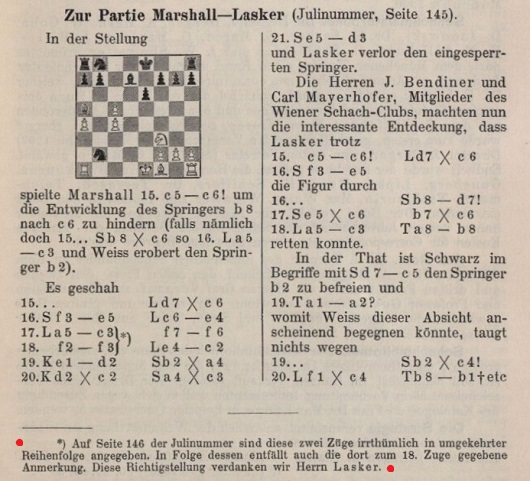
From the foregoing it can be concluded that the correct move-order is 17 Bc3 f6 18 f3.
Nevertheless, the would-be sequence 17 f3 f6 18 Bc3 has been seen in print for an astonishingly long time. Marshall included the game on pages 63-64 of Marshall’s Chess “Swindles” (New York, 1914). He gave Teichmann’s annotations, which meant that the wrong move-order from the BCM was published again. The missed opportunity was passed over in silence, although it was mentioned on pages 39-40 of Marshall’s My Fifty Years of Chess (New York, 1942):
“18 B-B3? Not the best. More exact was PxB PxKt 19 B-B3 KtxRP 20 RxKt with an easy win.”
In recent decades, the game has frequently been republished. K. Whyld gave the wrong move-order on page 93 of The Collected Games of Emanuel Lasker (Nottingham, 1998), even though Rosenthal’s tournament book was specified as the source. The right move-order was published by Egon Varnusz on page 206 of Emanuel Lasker, Volume 1, Games 1889-1907 (Budapest, 1998), but that prompted the comment “the Varnusz book doesn’t even get the move-order right” from Tim Harding in his Kibitzer column at the Chess Café, January 2000.
On pages 61-65 of Paris 1900 (Nottingham, 1986) Jimmy Adams included the correct move-order 17 Bc3 f6 18 f3 from the tournament book by Rosenthal but added notes from My Fifty Years of Chess, Teichmann in the BCM and the Deutsche Schachzeitung. John Hilbert put the wrong move-order when giving the game on pages 230-233 of Young Marshall (Olomouc, 2002), although at least two of his five sources had the correct one.
(9528)
...
Computer searches today show that a choice of en passant captures is not rare. An old specimen between leading players is the seventh match-game Marshall v Janowsky, Paris, 9 February 1905, e.g. as published on pages 70-71 of volume two of Halpern’s Chess Symposium (New York, 1905):
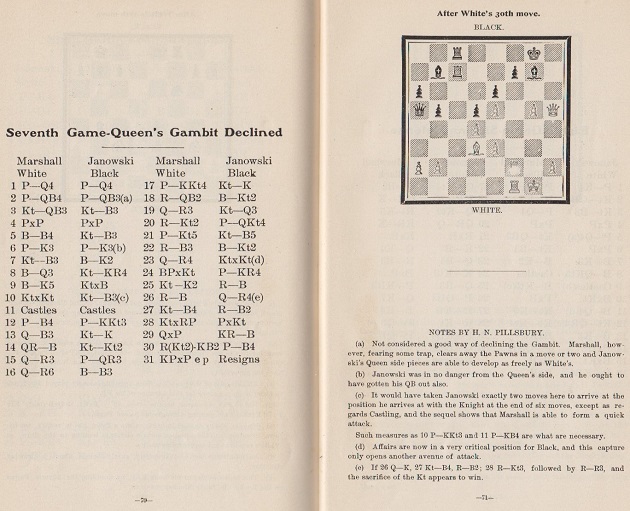
Pillsbury’s notes were originally on page 2 of the Philadelphia Inquirer, 5 March 1905:
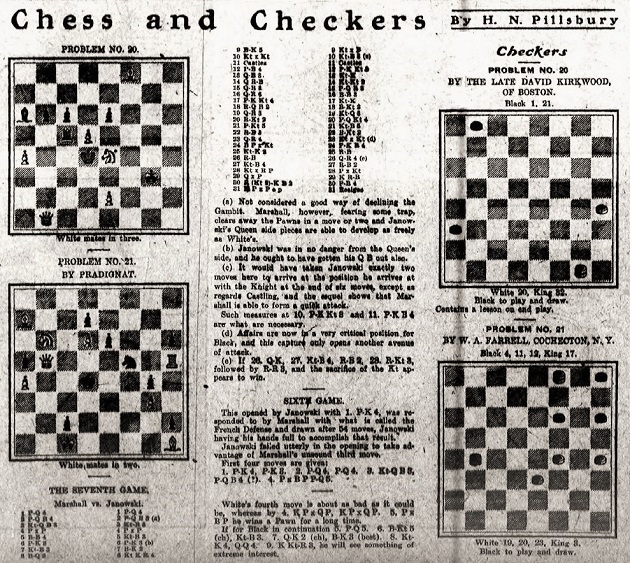
1 d4 d5 2 c4 c6 3 Nc3 Nf6 4 cxd5 cxd5 5 Bf4 Nc6 6 e3 e6 7 Nf3 Be7 8 Bd3 Nh5 9 Be5 Nxe5 10 Nxe5 Nf6 11 O-O O-O 12 f4 g6 13 Qf3 Ne8 14 Rac1 Ng7 15 Qh3 a6 16 Qh6 Bf6 17 g4 Ne8 18 Rc2 Bg7 19 Qh3 Nd6 20 Rg2 b5 21 g5 Nc4 22 Rf3 Bb7 23 Qh4 Nxe5 24 fxe5 h5 25 Ne2 Rc8 26 Rf1 Qa5 27 Nf4 Rc7 28 Nxh5 gxh5 29 Qxh5 Rfc8 30 Rgf2

30...f5 31 exf6 Resigns.
See also En passant (Chess).
The following paragraph is from page 51 of Frank Marshall, United States Chess Champion by A. Soltis:

Soltis did not specify his source or indicate whether the quoted words were his own translation. Can a reader provide the original Russian text? For now, we can give only the following on page 477 of the November 1903 BCM, with ‘rogue’ instead of ‘swindler’:
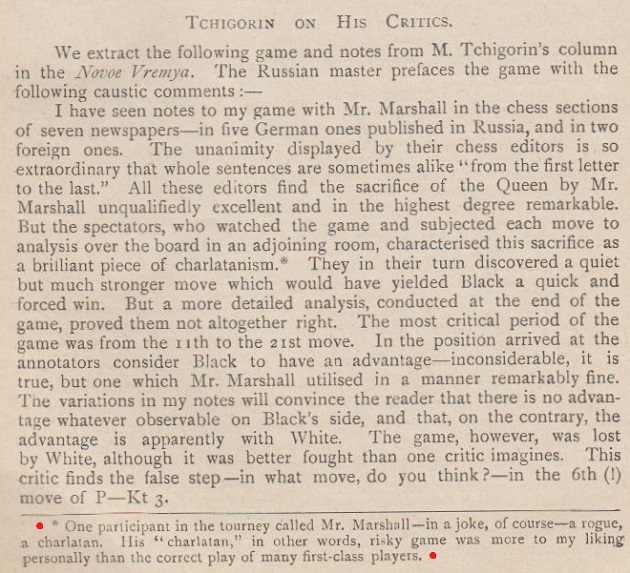
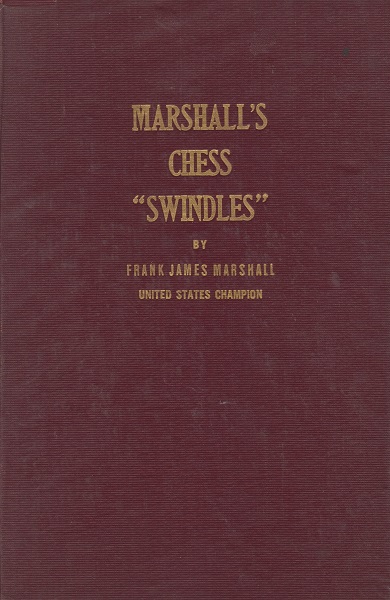
(9620)
F.J. Marshall’s time for solving this problem: two minutes:
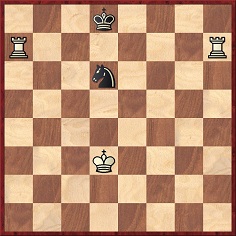
Mate in two
Our source is page 14 of the January 1944 Chess Review, which stated that ‘it took Grandmaster Frank J. Marshall just two minutes to find the key move ...’ We prefer the neutral wording at the start of the present item.
The problem dates from the thirteenth century (the Bonus Socius manuscript).
From page 30 of the April 1944 Chess Review, in the magazine’s coverage of the United States championship in New York:
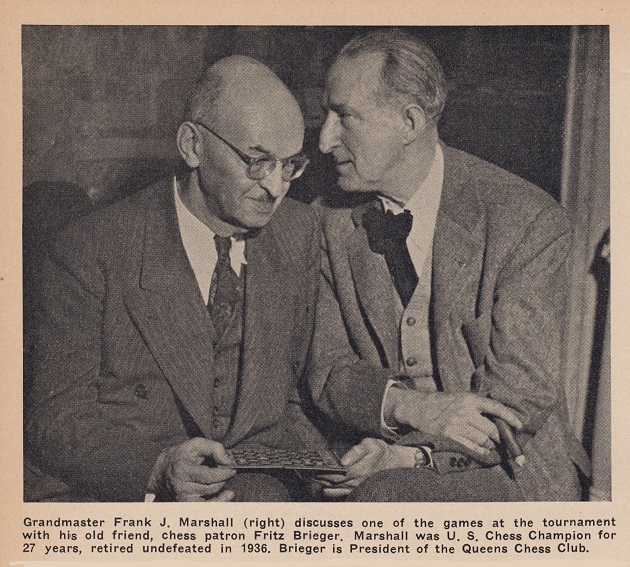
(9648)
Although W.E. Napier (1881-1952) was a highly quotable writer, he produced only one chess work, Napier’s Amenities and Background of Chess-Play (published in three ‘units’, the first two in 1934 and the third the following year). After his death they were adapted into a single volume entitled Paul Morphy and The Golden Age of Chess (New York, 1957 and 1971).
In the quotations below the figures refer to the item numbers in the Amenities work, the pages of which were unnumbered:
67. ‘Some of Marshall’s most sparkling moves look at first like typographical errors.’
180. ‘Among tournament masters, Marshall has had few superiors, and, as to style, has clearly been in a class of his own, without forerunner or disciple. He is a whole school.’
Two photographs published in the year Frank J. Marshall died:
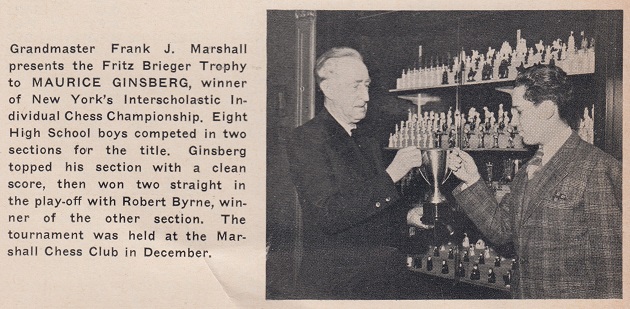
Chess Review, January 1944, page 4
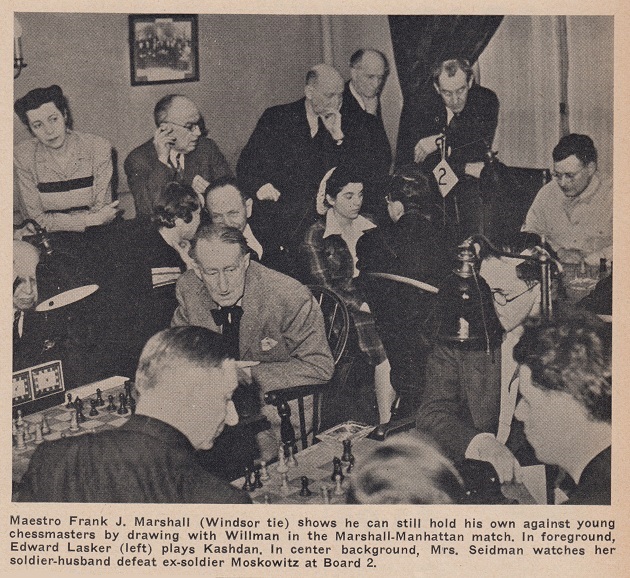
Chess Review, March 1944, page 5
(9654)
However often Janowsky may or may not have been called ‘Jan’ orally, it is difficult to find the nickname in print during his lifetime. One instance occurs in G.C. Reichhelm’s annotations to the 16th match-game between Janowsky and Marshall, Paris, 4 March 1905, as published on pages 90-91 of volume two of Halpern’s Chess Symposium (New York, 1905). The note after 43...e5 was: ‘In the vain hope that “Jan” would take at once.’
In passing, we mention a discrepancy over the game’s conclusion.
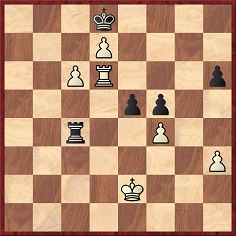
Reichhelm gave ‘48 PxP RxP (An “oversight”.) RxR wins’, whereas some sources state that Marshall resigned after White’s 48th move. Those sources include Marshall’s own brief coverage of the game on pages 36-37 of a booklet on the match (published in London in 1905 with his annotations from the Manchester Guardian). Two noteworthy publications which presented the conclusion as 48 fxe5 Rxc6 49 Rxc6 Resigns were pages 84-86 of La Stratégie, 17 March 1905 (notes by Alapin) and, as shown below, pages 106-107 of the April 1905 Deutsche Schachzeitung (notes by Tarrasch from the Berliner Lokal-Anzeiger):

Tarrasch gave similar annotations in Die Moderne Schachpartie (various editions, with different page numbers).
Moreover, according to the range of contemporary publications consulted, Black’s 47th move was ...Rc4, and not ...Rc5 as indicated by one or two unreliable databases.
Concerning ‘the two Jans’, a number of reference works (see, for instance, the entries on Janowsky in the Dictionnaire des échecs, the hardback edition of Golombek’s Encyclopedia of Chess and the 1984 edition of The Oxford Companion to Chess) affirm that this was a common term in the United States to describe a bishop pair. An extract from page 206 of the Dictionnaire des échecs by F. Le Lionnais and E. Maget (Paris, 1967):
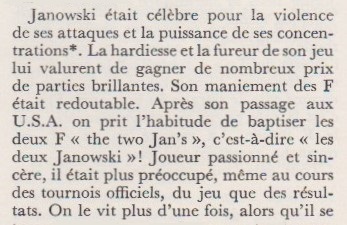
We have yet to trace the term in chess literature during Janowsky’s lifetime.
After presenting some victories by Janowsky, C.N. 351 commented:
... such games offer little support to the theory that Janowsky was obsessed with retention of the bishop pair. On the other hand, on page 330 of the October-November 1904 issue [of the Wiener Schachzeitung] Tarrasch, annotating the Cambridge Springs game Mieses v Janowsky remarks: ‘Janowski ist einer der wenigen Spieler, die das Geheimnis der Läufer begriffen haben und die latente Kraft dieser Figuren herauszuholen verstehen’.
(9656)
A consultation game in which Dawid Janowsky (White) faced Frank J. Marshall shows the former’s liking for the bishop pair:
1 e4 e5 2 d4 exd4 3 c3 dxc3 4 Bc4 cxb2 5 Bxb2 Nf6 6 Nf3 d5 7 exd5 Bb4+ 8 Nc3 Qe7+ 9 Be2 Ne4 10 Rc1 O-O 11 O-O Nxc3
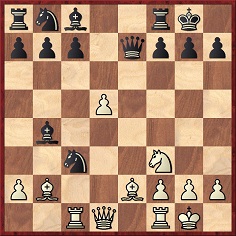
12 Rxc3 Bxc3 13 Bxc3 Nd7 14 Re1 Nf6 15 Bd3 Qd8 16 Re5 Re8 17 Rg5 h6 18 Rg3 Nh5 19 Bc2 Nxg3 20 hxg3 f5 21 g4 Re4
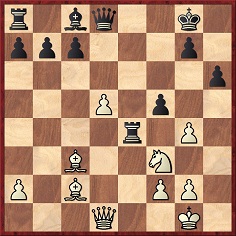
22 Ne5 Qg5 23 d6 cxd6 24 Qxd6 Qc1+ 25 Bd1 Rxe5 26 Bxe5 Kh7 27 Kh2 Be6 Drawn.
The game, played at the Automobile Club de France in Paris in October 1907, was published on pages 386-387 of La Stratégie, 20 November 1907 with Janowsky’s notes from Le Monde Illustré. Those annotations were the basis for what appeared on pages 289-290 of Voronkov and Plisetsky’s book on Janowsky (Moscow, 1987) and on pages 472-474 of Ackermann’s monograph (Ludwigshafen, 2005).
La Stratégie stated that Janowsky was partnered by Bonaparte Wyse, and Marshall by le baron de Laforie, although the annual index (page 454) gave le comte de Laforie. In the Soviet and German books the name was, respectively, Лафори and Lafore.
(9704)
Giving the game in his column on page 10 of the New York Evening Post, 7 December 1907, Emanuel Lasker put ‘Baron de la Farée’.
Michael McDowell has sent us over 30 illustrations by Frederick Orrett (1858-1939), including the following:
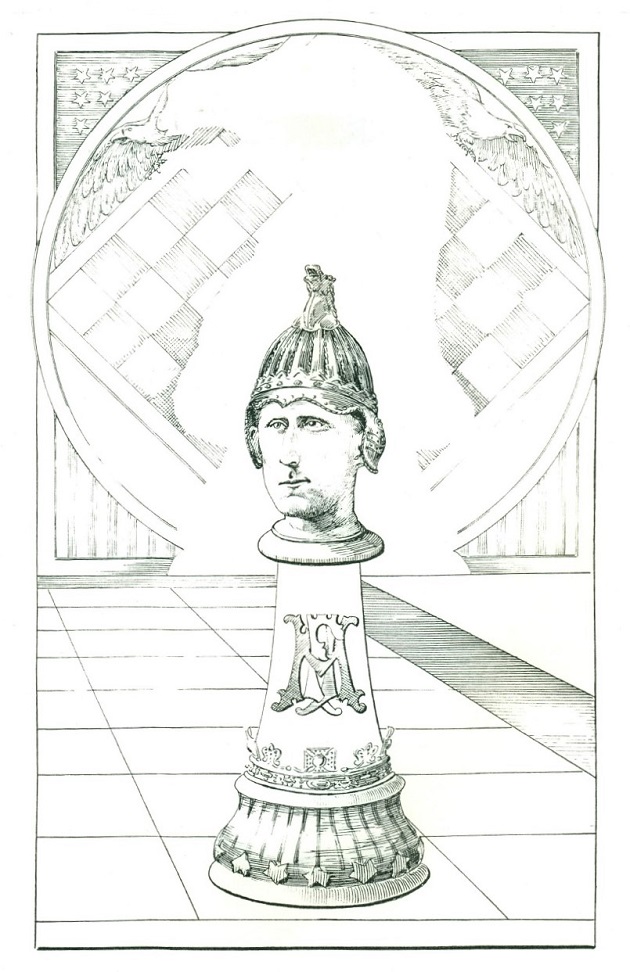
(9722)
On page 50 of Chernev’s Wonders and Curiosities of Chess (New York, 1974) the record for the number of wins in a tournament was ascribed to Chigorin (27 at New York, 1889), and pages 83-84 of The Fireside Book of Chess (New York, 1949), co-written by Chernev with Fred Reinfeld, had this:

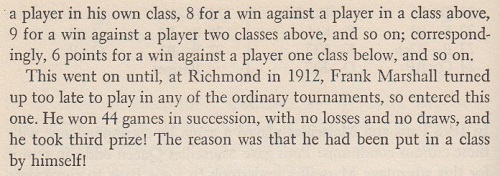
See too pages 61-62 of Wonders and Curiosities of Chess.
Marshall’s appearance at Richmond in 1912 was the subject of a report on page 219 of the October 1912 American Chess Bulletin:
‘The strange thing about this competition was that Marshall was placed third after making a clean sweep of 49 wins. This is explained by the novel system of scoring which prevailed. The players were credited with points according to the intrinsic value of the games, which were judged by the merit of scoring against the favorites. It is not at all astonishing that Marshall was unable to comprehend the sort of mathematics which, with his score, would relegate him to third place. Of course, the explanation lies in the fact that he was fearfully handicapped in not being able to play and win against himself. And yet no-one else enjoyed that privilege. Otherwise, all played on even terms. H. Bogdanor won the first prize, and L. Savage the second.’
There was a follow-up item by John Keeble on page 269 of the December 1912 issue:
‘On page 219, October Bulletin, you refer to Mr Marshall’s remarkable score of 49 wins, no losses, in the British Chess Federation handicap tourney. This tourney is the most curious I know of. A description of it might interest your readers.
The entrance fee is 60 cents. It is supposed to consist of players of eight classes, but all games are played on level terms. For a win against one in his own class a player receives 16 points, two points per class are added for wins against those classes above him, and two points deducted for wins against classes below. Thus if Class 8 should beat Class 1, the winner would get 30 points, but if Class 1 beat Class 8, only two points fall to the winner’s share. Three games against each are allowed, but a full total of 20 must be played in order to stand in for a prize. At the end of the fortnight the scores are added up and a figure of merit obtained by dividing the points obtained by the number of games played, and 0.1 is added for each game played.
This tourney always got an entry of 60 or more, but it never attracts the best players. The first-class players have as much as they can do to get through their championship games, but the lower classes finish much earlier and fill up their spare time in this handicap. Mr Marshall is, I think, the only player of any note who has entered it. Of course, he was put in the first class, the second class had only two players, and there were 60 or more in classes three to seven. Mr Marshall played both the second-class men, but two other games, with one exception (a lady), were played against class three men only, and against these, of course, he could not score more than 12 points. Mr Marshall’s figure of merit, obtained by dividing the points obtained by number of games played, worked out exactly 12. To this was added 4.9 for the games played, and it made him a close third, winning, I think, $8.45. The prizes are small, the first three being 45, 40 and 35 shillings respectively. I think there are six prizes altogether.
No doubt Mr Marshall was handicapped by not being able to play more men in the higher classes, but this tourney gave him an opportunity to favorably impress a large number of players. Nobody could have been more popular than he was at Richmond. Everybody who was there speaks well of him.’
(9791)
From the Marienbad, 1925 tournament book:
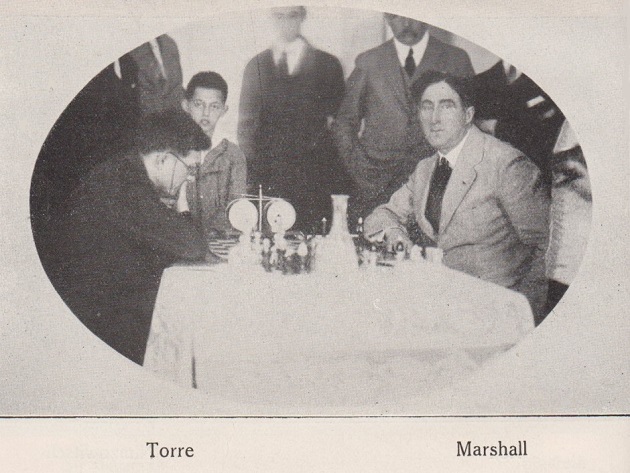
(9844)
Eduardo Bauzá Mercére draws attention to a game on page 110 of La Stratégie, 18 April 1905:
Frank James Marshall (simultaneous) – Count Jean de
Villeneuve-Esclapon
Café de la Régence, Paris, 11 March 1905
Sicilian Defence
1 e4 c5 2 d4 cxd4 3 Nf3 Nc6 4 Bc4 e6 5 Nxd4 d5 6 exd5 exd5 7 Bb5 Bd7 8 O-O Bc5 9 Re1+ Nge7 10 Nxc6 bxc6 11 Bd3 O-O 12 Qh5 Ng6 13 Nc3 f5 14 Bg5 Qb6 15 Be3 d4 16 Na4
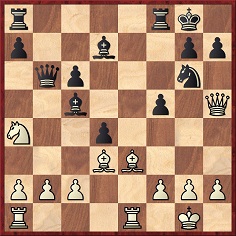
16...dxe3 17 Nxb6 exf2+ 18 Kh1 fxe1(Q)+ 19 Rxe1 axb6 20 h3 Nf4 21 Bc4+ Kh8 22 Qg5 Nd5 23 a3 h6 24 Qg6 Rf6 25 Qg3 f4 26 Qf3 Raf8 27 Bxd5 cxd5 28 Qxd5 Bc6 29 Qc4 f3 30 gxf3 Rxf3 31 Kh2 Rf2+ 32 Kg3 Rg2+ 33 Kh4 Bf2+ 34 Kh5 Rf5 mate.
We add a report on the display from page 89 of the 17 March 1905 issue of La Stratégie:
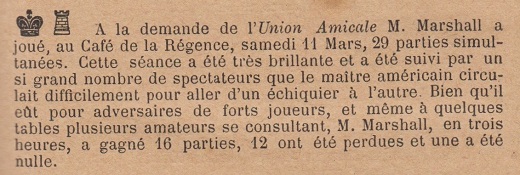
(10485)
Three photographs of Marshall by Hansel Mieth dated December 1939 can be viewed online: 116539986, 116540000, and 116540002.
(10486)
One of the many reasons why a book should give precise sources is that they enable readers to check information independently. That process is often very difficult with Gyula Breyer. The Chess Revolutionary by Jimmy Adams (Alkmaar, 2017), as some examples will show.
From pages 142-143:
‘Marshall remembered Breyer as a “tall, boyish, slim and happy-looking lad who played clever openings and knew more ‘book’ than any master” [Andrew Soltis in Frank Marshall: United States Chess Champion].’
The square brackets are from Adams’ book (as is the absence of italicization of ‘Marshall’). The passage is readily found in the Soltis book, whose index has only two references to Breyer, on page 199:

A point of detail is that the words ‘who played clever openings and’ are not attributed to Marshall, but the main point is that the reader is no further forward because, as usual, Soltis is silent as to the exact provenance and context of the alleged Marshall quote. His output cannot be regarded as reliable, and the Breyer book demeans itself by using it ...
(10563)
Black to move:
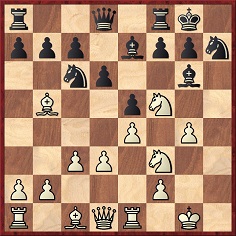
Position after 14 hxg4
Black played 14...Bg5, but would 14...Ng5 have been preferable? Evidently not, given that White then wins a piece with 15 Nxe7+.
The position arose in the sixth match-game between Capablanca and Marshall in 1909 in Morristown, NJ (and not New York, as stated in Golombek’s 1947 monograph on the Cuban). From page 36 of Capablanca’s 1920 book My Chess Career:

In the 1966 ‘unabridged and corrected republication’ of My Chess Career from Dover Publications, Inc. the text was the same, although on page 34.
A particular surprise is that Capablanca’s note was reproduced unquestioningly on page 227 of the first volume of Kasparov’s Predecessors series:

Various translations of Capablanca’s book (into Russian, Serbo-Croat, Czech and Spanish) gave the same note, but page 61 of the 2016 French edition (C.N. 10582) had a translator’s footnote:
‘Il semble que sur 14...Cg5, Capablanca ait oublié 15 Ce7+ qui gagne une pièce pour les Blancs. Peut-être veut-il dire 14...Cf6.’
Capablanca may indeed have meant 14...Nf6, and not 14...Ng5. The existence of the move ‘Kt-Kt4’ in the previous note could have led to a typesetting mistake.
A faulty game-score seems an unlikely explanation, the previous moves being well established from publications of the time. They include pages 187-188 of the 8 May 1909 Chess Weekly, which had Capablanca’s exclusive annotations (with no comment at move 14):
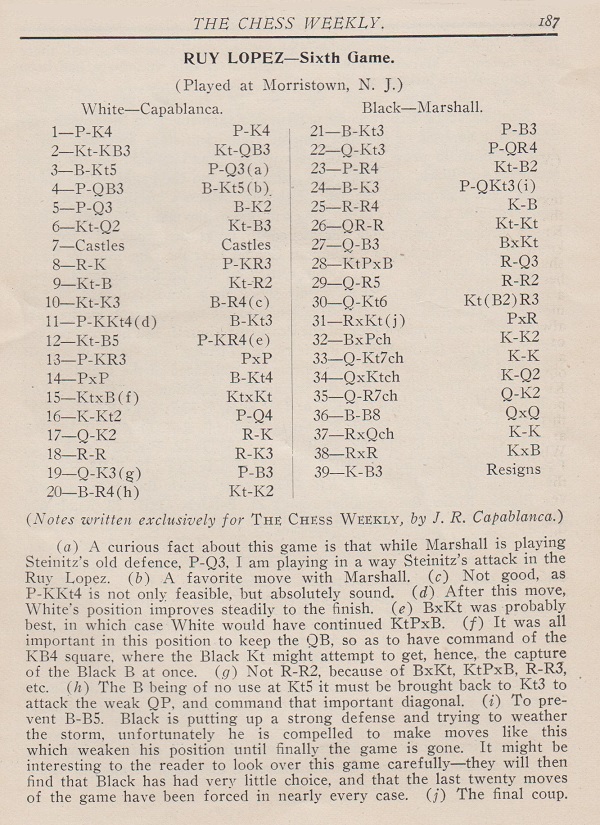

Page 49 of volume one of the 1997 ‘Chess Stars’ work on Capablanca followed 14...Bg5 with a brief note, ‘14...Ng5?? 15 Ne7 +–’, but did not mention that Black’s move had been put forward in My Chess Career. When was the ‘14...Kt-Kt4’ mistake in Capablanca’s book first pointed out?
(10591)
Vitaliy Yurchenko (Uhta, Komi, Russian Federation) notes that page 35 of volume one of José Raúl Capablanca Avtoportret genia by S. Voronkov (Moscow, 2006) stated outright, in quoting Capablanca’s remark about 14...Ng5, that he overlooked the reply 15 Nxe7+:
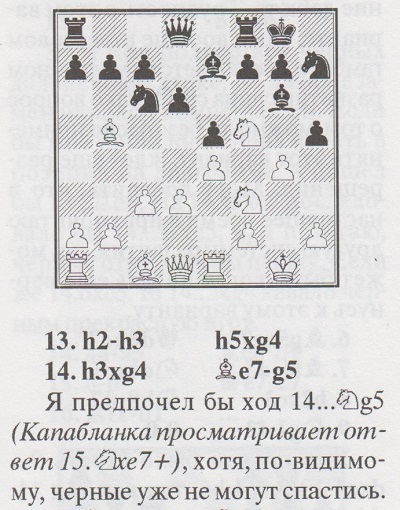
(10595)
John Hilbert sends a photograph from the New Orleans Times-Democrat, 16 March 1913, part 2, page 10:
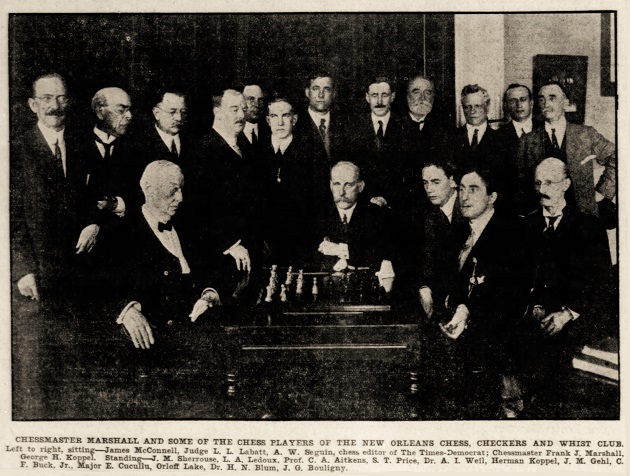
Our correspondent notes that page 102 of the May 1913 American Chess Bulletin mentioned the photograph in its account of Marshall’s visit to New Orleans.
(10655)
From the plate section of American Chess Masters from Morphy to Fischer by Arthur Bisguier and Andrew Soltis (New York, 1974):
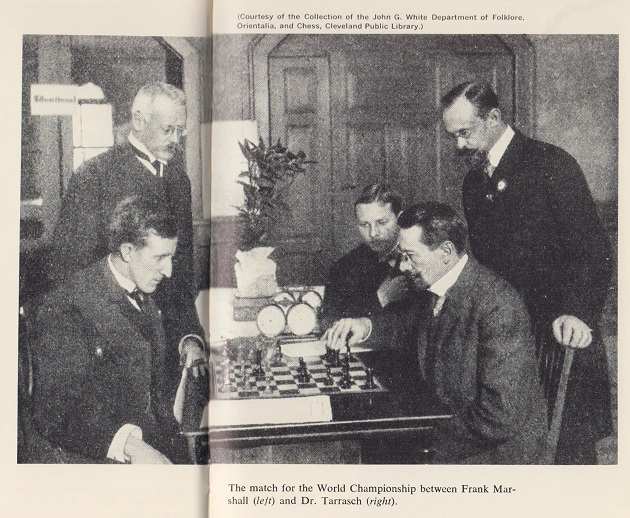
The reference to the world championship is an obvious mistake, but when was the photograph taken? Below are two more recent appearances:
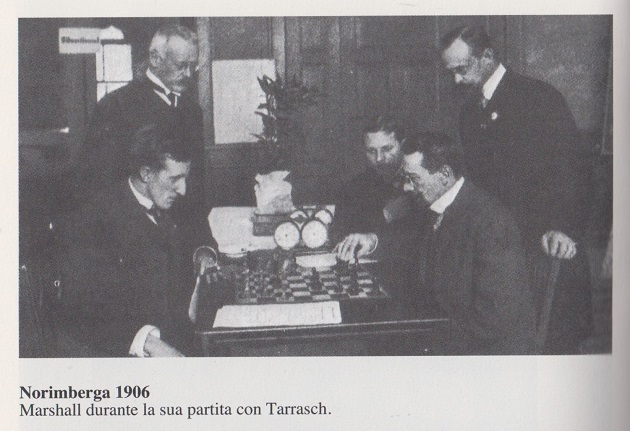
Tarrasch potere della logica by Jakov Nejstadt (Rome, 1996)
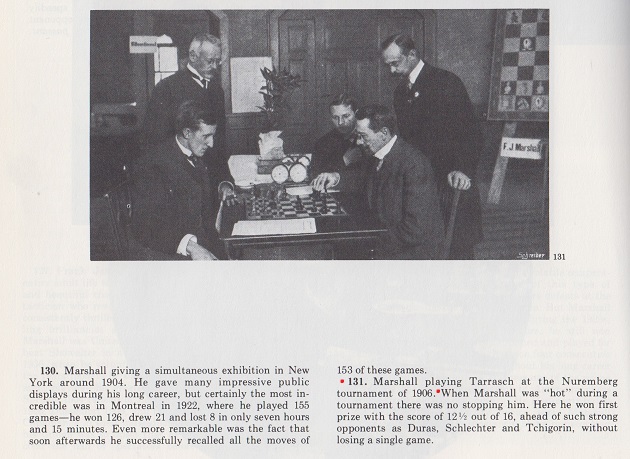
A Picture History of Chess by Fred Wilson (New York, 1981), page 74
Apparent confirmation that the occasion was the Nuremberg, 1906 tournament is on page 6 of Chess Review, December 1944, which showed a dated copy inscribed by Marshall:
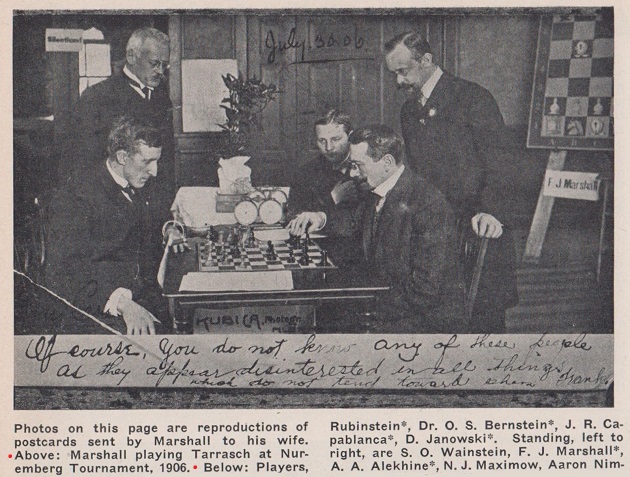
However, in the Nuremberg tournament (third round, 25 July 1906), Tarrasch had the white pieces against Marshall. (See the tournament book, pages 91-92.)
The photograph had been published the previous year, on page 318 of the October 1905 American Chess Bulletin:
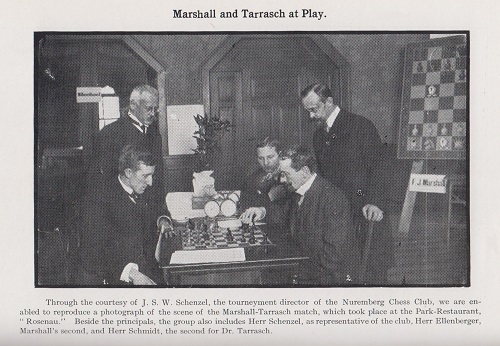
It seems to us that the position is from the 17th and final match-game, won by Tarrasch on 14 October 1905: 1 e4 e5 2 Nf3 Nc6 3 Bb5 Nd4 4 Nxd4 exd4 5 O-O c6 6 Bc4 Ne7 7 Qh5 d5 8 exd5 cxd5 9 Bb5+ Bd7 10 Bxd7+ Qxd7 11 Qe5 d3 12 cxd3 O-O-O 13 a3 Nc6 14 Qh5 g6 15 Qd1 Qf5 16 b4 Qxd3 17 Nc3 Bg7 18 Qa4 Kb8 19 Ra2 Nd4 20 Re1 Rc8 21 h3 Nf5 22 Qd7 Rhd8 23 Qxf7 Rc7 24 Qe6 Re7 25 Qxe7 Nxe7 26 Re3 Qc4 27 Rxe7 Bf8 28 Rxh7 d4 29 Rc2 dxc3 30 Rxc3 Qe2 31 g3 Bd6 32 Kg2 Rf8 33 White resigns.
(10660)
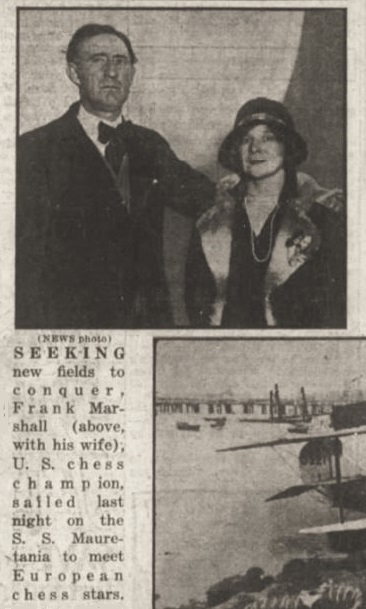
Source: Daily News (New York), 29 September 1927, page 21 (section two).
Marshall participated in the British Empire Club Masters’ Tournament in London, which began on 10 October 1927. A group photograph (the frontispiece to the November 1927 BCM) was shown in C.N. 3959. Reporting on Marshall’s departure from New York, page 151 of the September-October 1927 American Chess Bulletin commented that ‘Marshall’s last appearance in an English tournament was in 1899’.
(10908)
From page 8 of the Boston Globe, 22 November 1920:
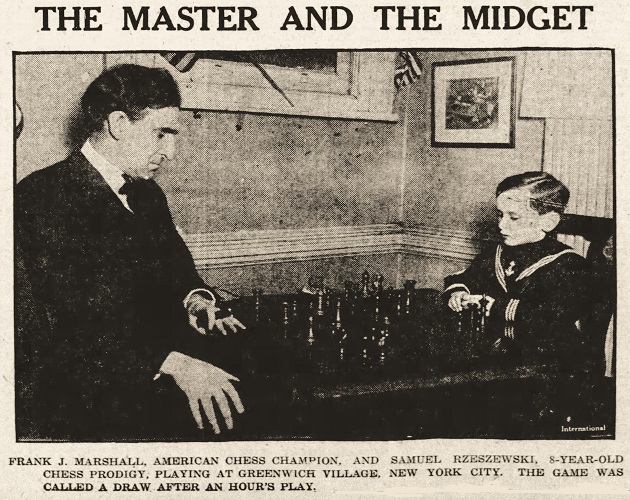
(10948)
Eduardo Bauzá Mercére has forwarded a game between Frank James Marshall and Irving Chernev (simultaneous exhibition, Brooklyn, 6 December 1919) on page 2 of section one of the Brooklyn Daily Eagle, 11 December 1919:
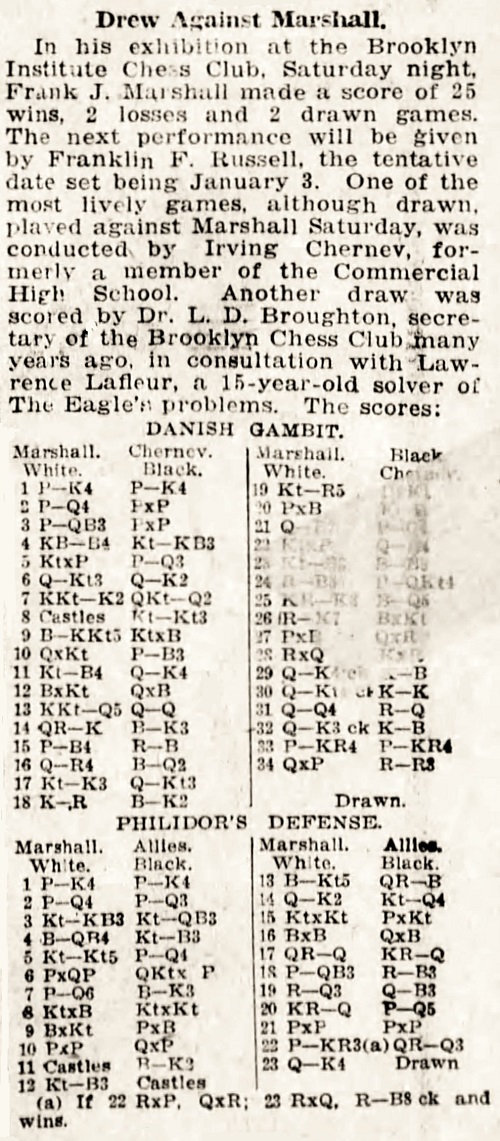
1 e4 e5 2 d4 exd4 3 c3 dxc3 4 Bc4 Nf6 5 Nxc3 d6 6 Qb3 Qe7 7 Nge2 Nbd7 8 O-O Nb6 9 Bg5 Nxc4 10 Qxc4 c6 11 Nf4 Qe5 12 Bxf6 Qxf6
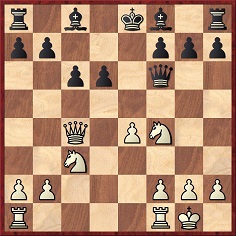
13 Nfd5 Qd8 14 Rae1 Be6 15 f4 Rc8 16 Qa4 Bd7 17 Ne3 Qb6 18 Kh1 Be7 19 Nf5 Bxf5 20 exf5 Kf8 21 Qc2 d5 22 Nxd5 Qc5 23 Nc3 Bf6 24 Rf3 b5
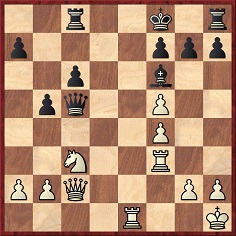
25 Rfe3 Bd4 26 Re7 Bxc3 27 bxc3 Qxe7 28 Rxe7 Kxe7 29 Qe4+ Kf8 30 Qb4+ Ke8 31 Qd4 Rd8 32 Qe3+ Kf8 33 h4 h5 34 Qxa7 Rh6 Drawn.
Marshall’s other game, against Broughton and Lafleur:
1 e4 e5 2 d4 d6 3 Nf3 Nc6 4 Bc4 Nf6 5 Ng5 d5 6 exd5 Nxd4 7 d6 Be6 8 Nxe6 Nxe6 9 Bxe6 fxe6 10 dxc7 Qxc7 11 O-O Be7 12 Nc3 O-O 13 Bg5 Rac8 14 Qe2 Nd5 15 Nxd5 exd5 16 Bxe7 Qxe7 17 Rad1 Rfd8 18 c3 Rc6 19 Rd3 Qf6 20 Rfd1 d4 21 cxd4 exd4 22 h3 Rcd6 23 Qe4 Drawn.
By chance, Olimpiu G. Urcan has sent us the chess column on page 8 of the Washington Post, 15 February 1920, which had the same two games and a similar text. He adds that a report on Marshall’s display had been published on page 2 of section one of the 8 December 1919 edition of the Brooklyn Daily Eagle:
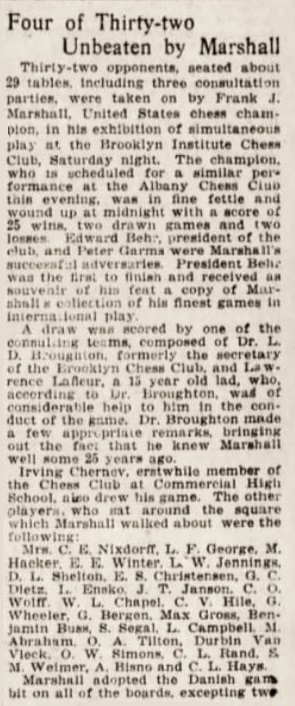
(11027)
In the item below, from page 7 of the January 1932 American Chess Bulletin, a comment by Marshall about 1 Nf3 is worth noting:
‘This is recognized as the latest and strongest in hyper-modern openings and is an extremely difficult move to answer.’
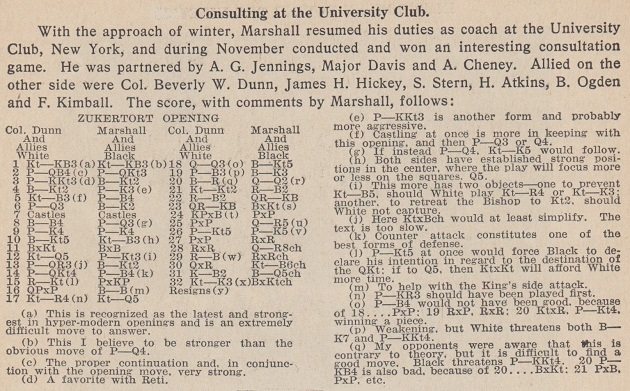
1 Nf3 Nf6 2 c4 b6 3 g3 Bb7 4 Bg2 e6 5 Nc3 c5 6 d3 Be7 7 O-O O-O 8 Bf4 d6 9 e4 e5 10 Bg5 Nc6 11 Bxf6 Bxf6 12 Nd5 g6 13 a3 Bg7 14 b4
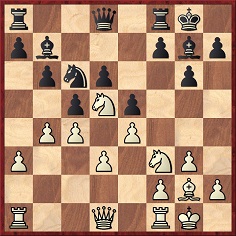
14...f5 15 Rb1 fxe4 16 dxe4 Bc8 17 Nh4 Nd4 18 Qd3 Bg4 19 f3 Be6 20 Bh1 Qd7 21 Ng2 Rf7 22 Rf2 Raf8 23 Rbf1 Bxd5 24 exd5 cxb4 25 axb4 Qa4 26 b5 e4 27 fxe4 Rxf2 28 Rxf2 Qa1+ 29 Rf1 Rxf1+ 30 Qxf1 Nf3+ 31 Kf2 Bd4+ 32 Ne3 Bxe3+ 33 White resigns.
The notes after (q) have yet to be found.
(11342)
Patsy A. D’Eramo (North East, MD, USA) has found Marshall’s complete notes on page 10 of the Allentown Morning Call, 29 November 1931:
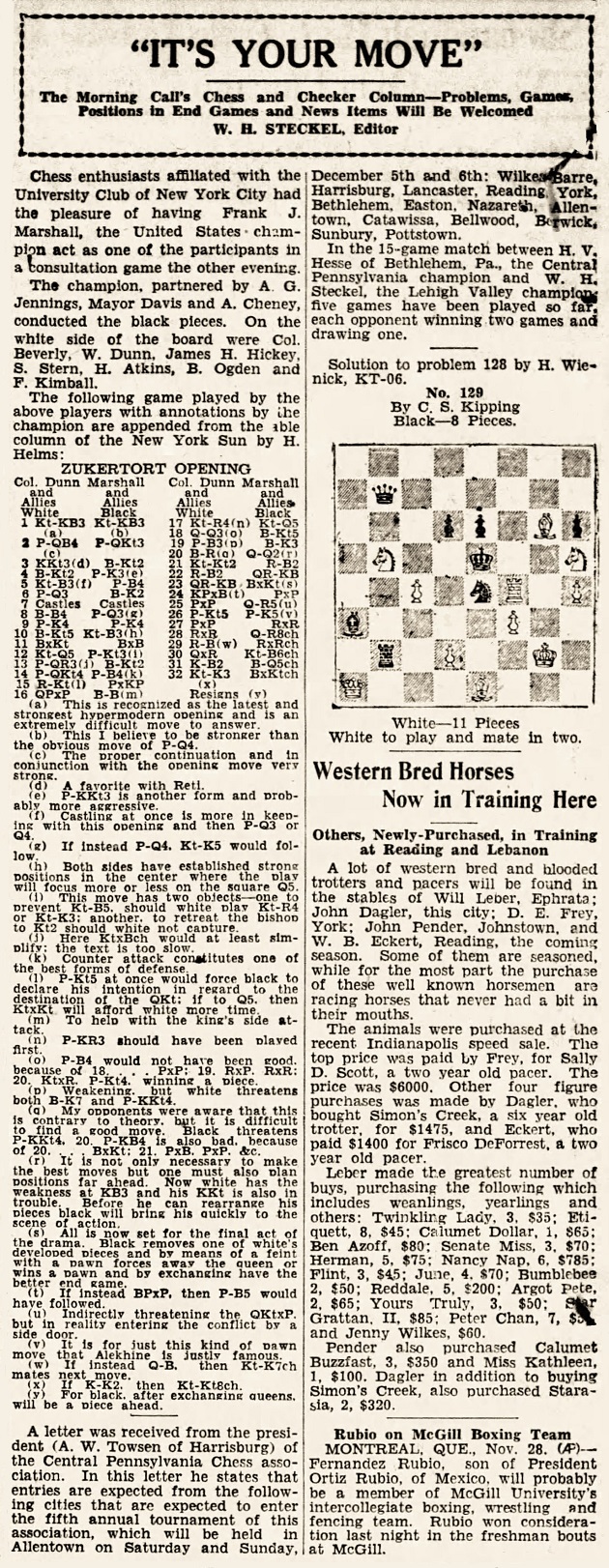
We can add that the Sun column referred to was on page 40 of the 20 November 1931 edition:

(11347)
‘The name of Marshall is associated with the unexpected in chess. No-one, not even Morphy, has won more brilliant games, many of them brought about from most unpromising looking positions.’
Source: page 58 of Modern Master-Play by F.D. Yates and W. Winter (London, 1929).
(11406)
A correspondence game played in 1919 between Zd. Formánek and A. Vavřinský:
1 e4 e5 2 Nf3 Nc6 3 Bc4 Nf6 4 d4 exd4 5 O-O Bc5 6 e5 d5 7 exf6 dxc4 8 Re1+ Be6 9 Ng5 Qd5 10 Nc3 Qf5 11 Nce4 O-O-O 12 Nxe6 fxe6 13 g4 Qe5 14 fxg7 Rhg8 15 Bh6 d3 16 c3 d2 17 Re2 Bb6 18 Kg2 Ne7 19 f3 Nd5 20 Qc2 Nf4+ 21 Bxf4 Qxf4 22 Rd1 Rd3 23 Nxd2 Rxg7 24 Re4 Rxg4+ 25 Kh1
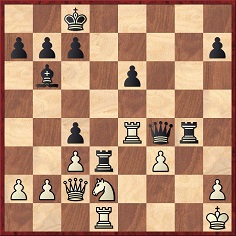
25...Qxd2 26 White resigns.
The score is taken from pages 27-28 of Časopis Československých Šachistů, February 1920:
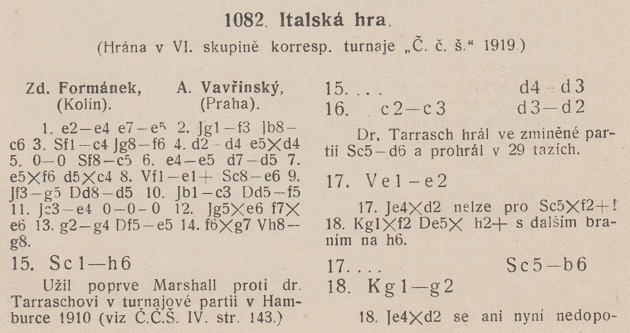
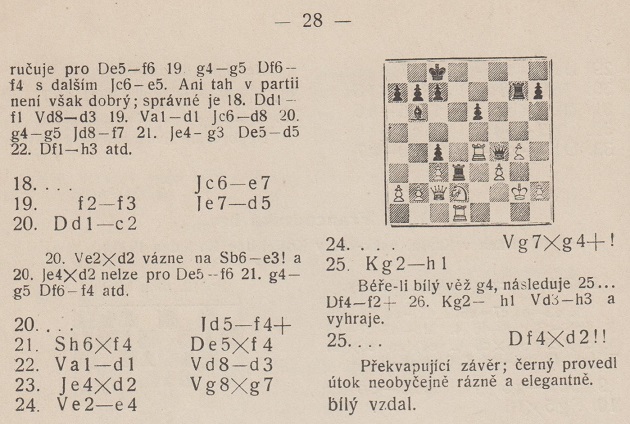
It was also published on page 352 of the September 1920 Chess Amateur:
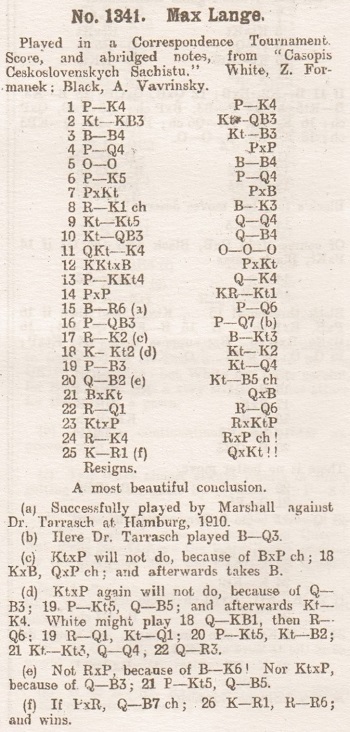
As regards the above-mentioned game Marshall v Tarrasch, Hamburg, 1910, below is the key phase, with a reference to 16...d2, on page 118 of Marshall’s book My Fifty Years of Chess (New York, 1942):
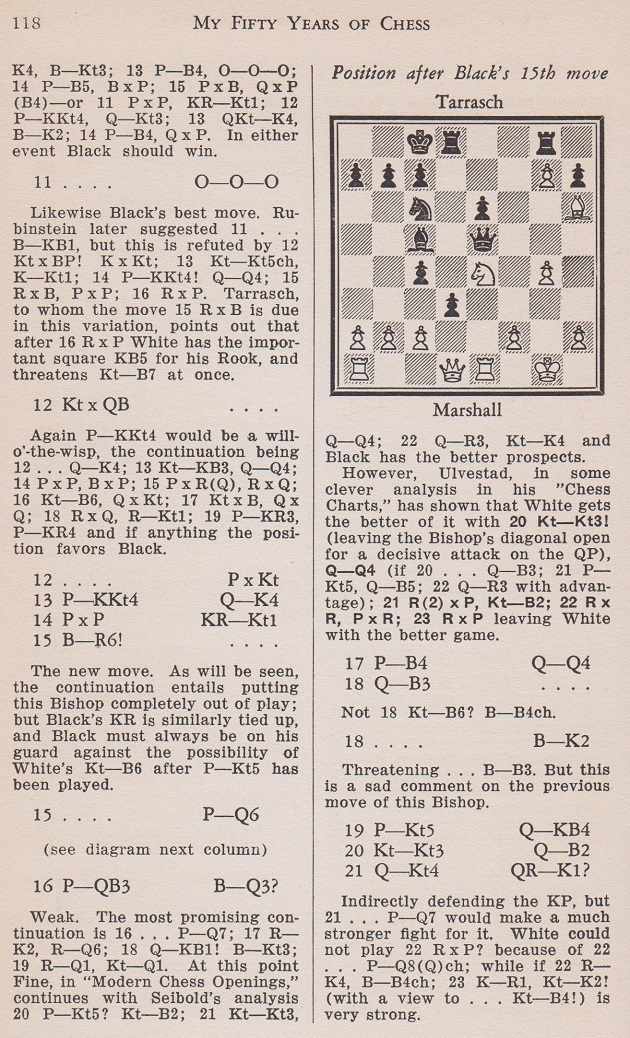
The game was also included in the American’s scarce book Modern Analysis of the Chess Openings (Amsterdam, 1912/13), where it was followed by some Marshall v Capablanca games with the same opening:
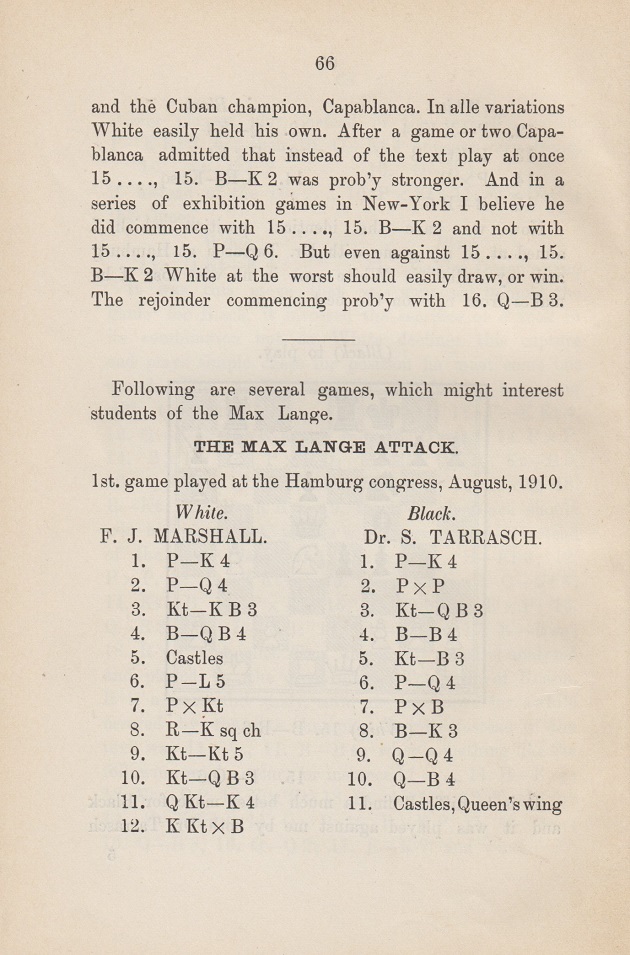
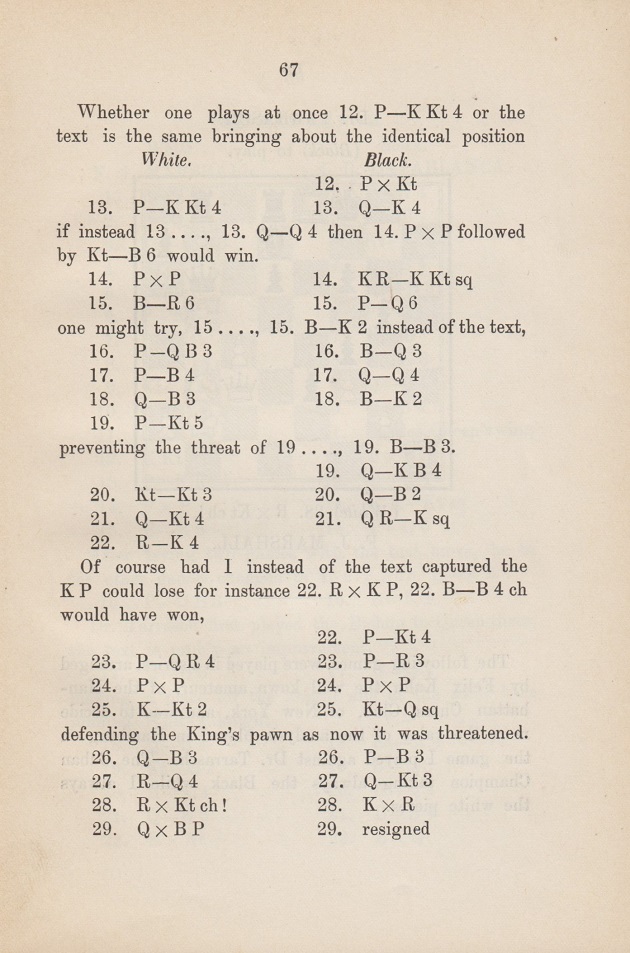
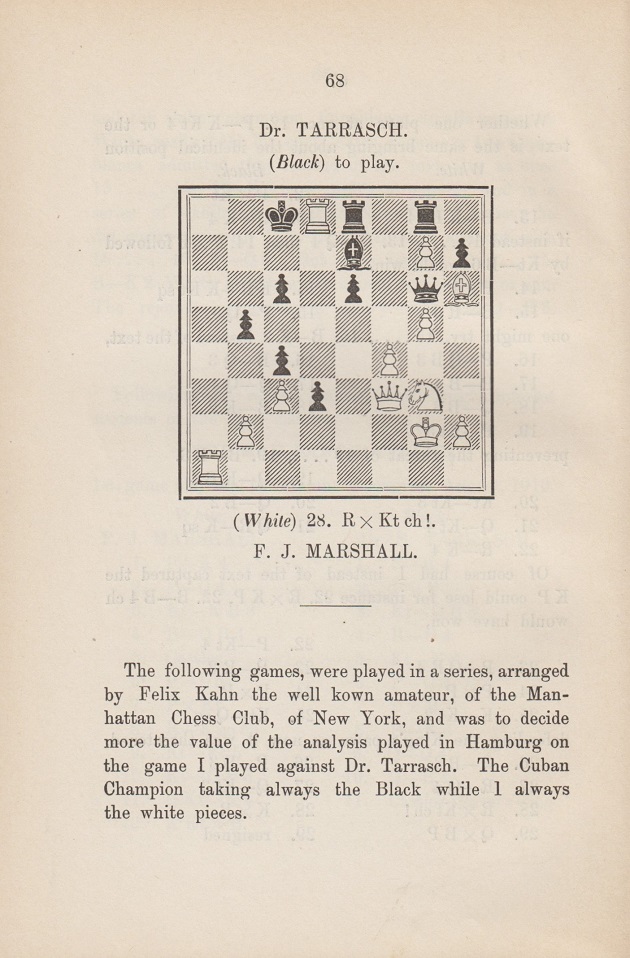
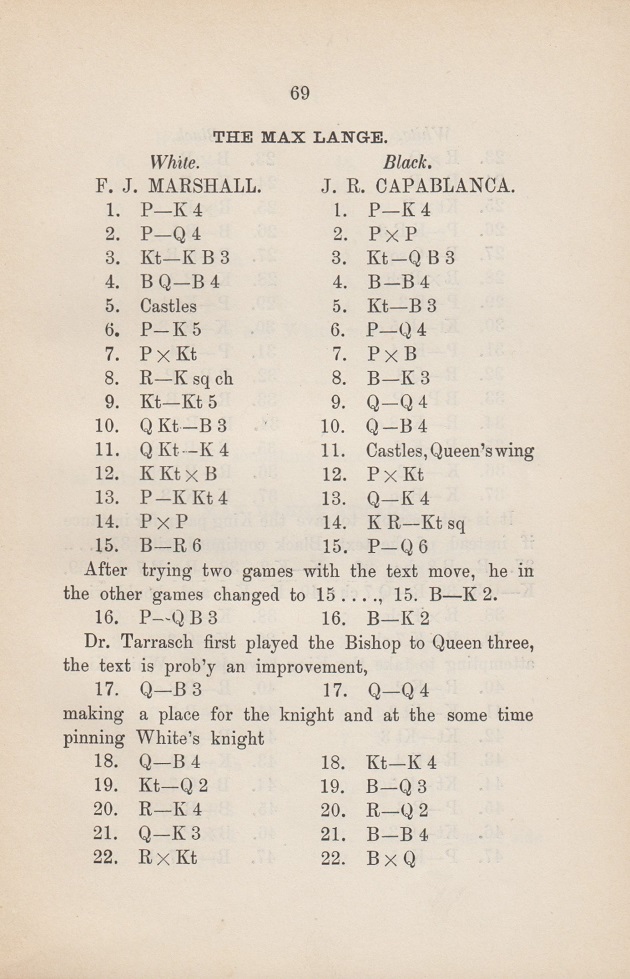
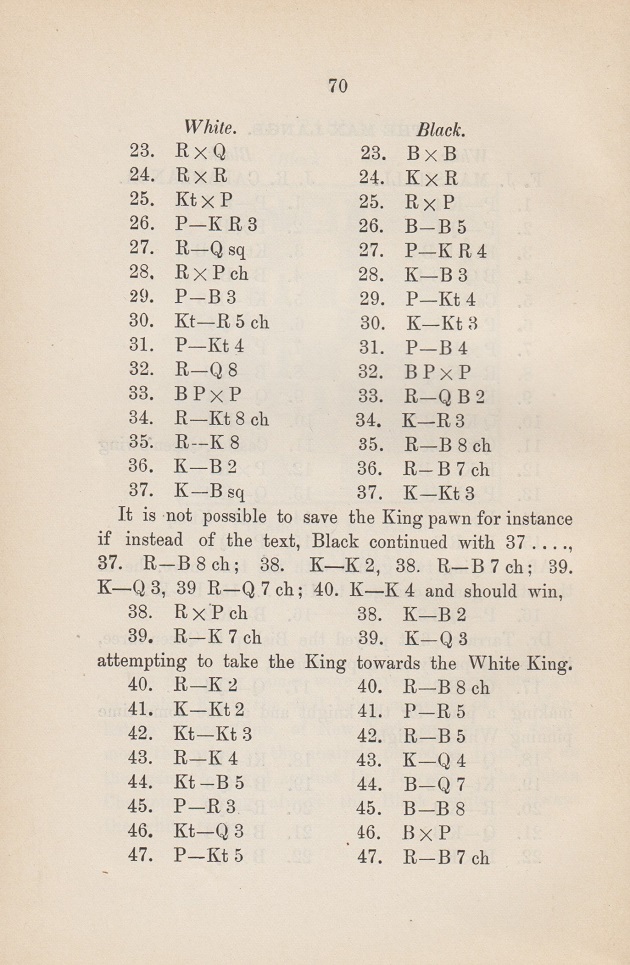
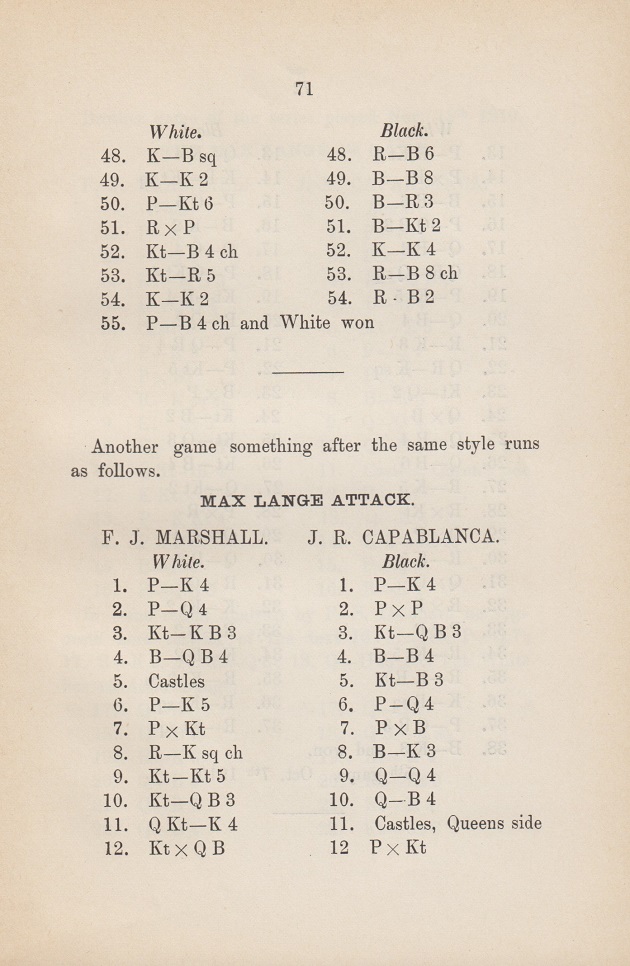
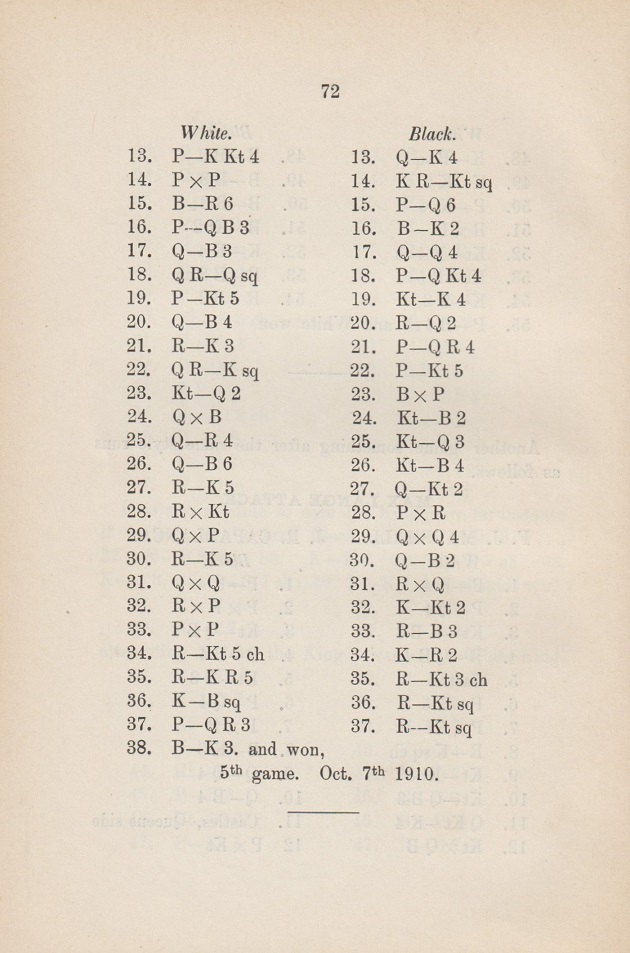
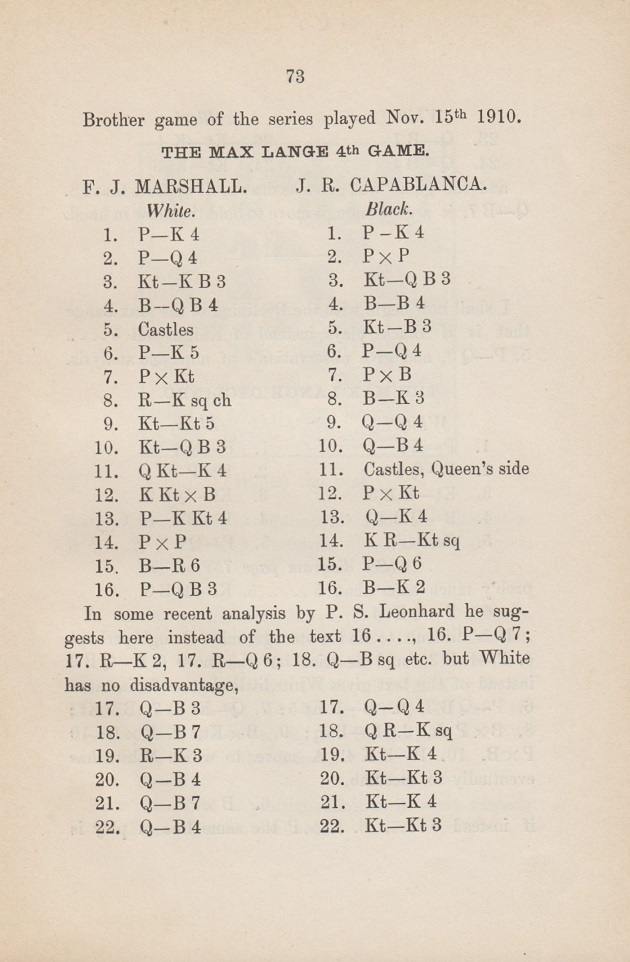
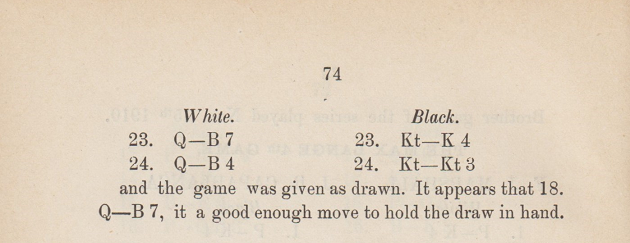
Those games are on pages 108-109 of The Unknown Capablanca by David Hooper and Dale Brandreth (London, 1975):
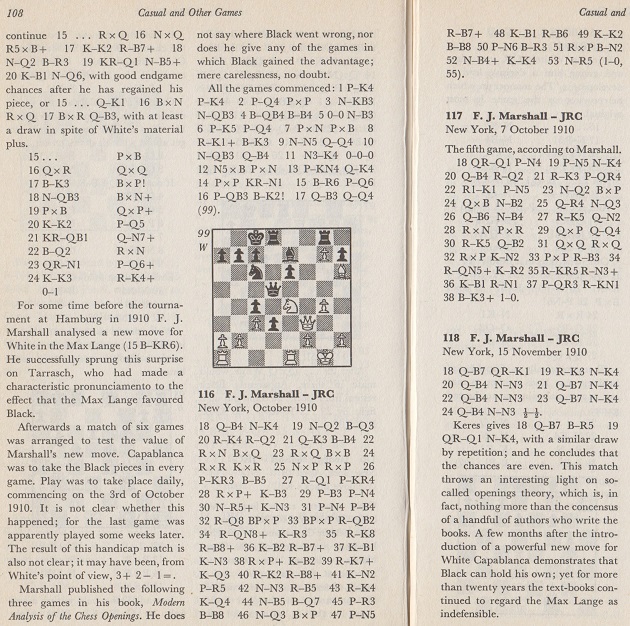
(11529)
M.E. Goldstein, writing about Frank Marshall on page 176 of Check!, 1 April 1945:
‘The last time I saw Marshall was at the 1927 London tournament won jointly by Nimzowitsch and Tartakower. Looking like a retired Shakespearean actor, more likely to burst into a Hamlet soliloquy than into a tournament game of chess, Marshall had the satisfaction of a splendid win against Nimzowitsch, for which he was awarded the best-played game prize.’
The comparison with a Shakespearean actor is not original. Page 1 of My Fifty Years of Chess by F.J. Marshall (New York, 1942):
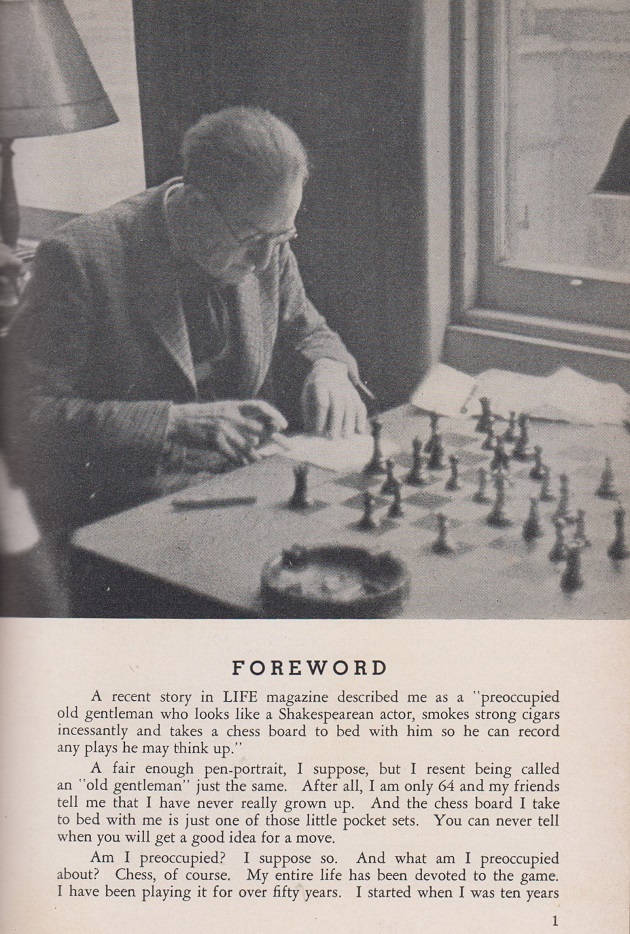
The same photograph (which brings to mind the discussion in C.N.s 5114 and 5124) was on page 180 of the October 1941 Chess Review, with a slightly different text on page 181:
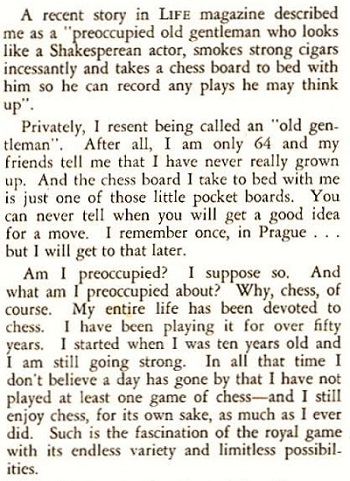
The feature on Marshall was in the 29 January 1940 edition of Life, and below is the reference to Marshall’s physical appearance (page 50), a photograph of him in play against Clarence Hewlett (page 49) and a general shot of a team match (page 54):
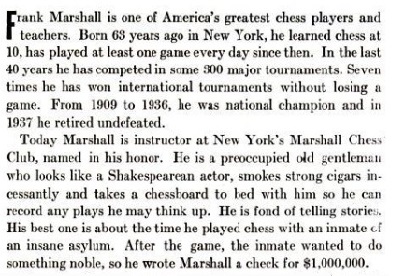
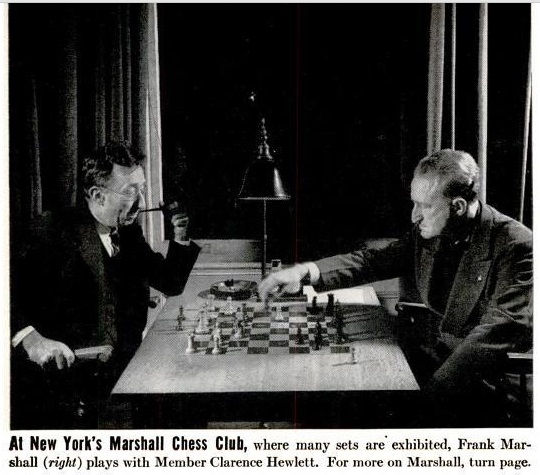
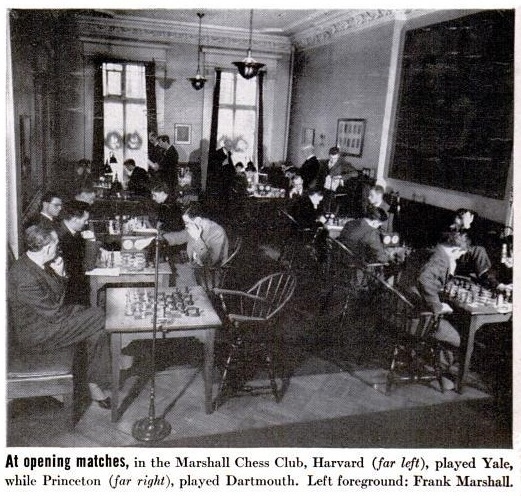
(11711)
C.N. 1981 (see page 68 of Kings, Commoners and Knaves) gave this game won by F.J. Marshall:
1 e4 e5 2 Nf3 Nc6 3 Bc4 Bc5 4 O-O d6 5 c3 Bg4 6 d3 h6 7 Be3 Bb6 8 Nbd2 Nf6 9 Qc2 Bxf3 10 Nxf3 Ng4 11 Rae1 Ne7 12 h3 Nf6 13 Qb3 O-O 14 Bxb6 axb6 15 d4 Ng6 16 Qc2 Qe7 17 g3 Qd7 18 Kg2 Qc6 19 Qe2 Qd7 20 Rd1 Nh5
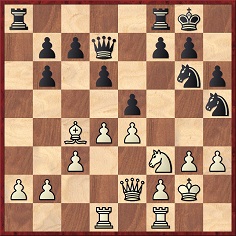
21 Nxe5 Ngf4+ 22 gxf4 Nxf4+ 23 Kf3
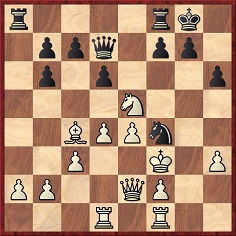
23...Qxh3+ 24 Kxf4 g5 mate.
Our source, page 82 of the Chess Amateur, December 1907, described it as ‘a remarkably pretty ending’ but gave no details of the occasion or any information about White, apart from his surname, Coldwell.
Now, Eduardo Bauzá Mercére proposes as a working hypothesis that it was an offhand or simultaneous game played in London in April 1905 against P.H. Coldwell, on the basis of these considerations:
No chessplayer named Coldwell, or any close variant, has been found in the United States or Canada during the period 1893-1907. P.H. Coldwell was a member of the Hampstead Chess Club, as mentioned, for instance, on pages 151-153 of the April 1905 BCM. A game won by P. Coldwell against Louisa Fagan in the Hampstead Chess Club tourney in 1906 was published on page 2 of the Bridlington Free Press, 7 December 1906.
Marshall went to London in 1899, 1902, 1903 and 1905. As regards the last of these visits, he departed for London from Mannheim on 11 April 1905 (Deutsche Schachzeitung, June 1905, page 156). The following day he gave a simultaneous display at the City of London Chess Club, with the result +4 –9 =7 (Daily News, 20 April 1905, page 11); in an exhibition at the Criterion (Metropolitan Chess Club) on 26 April 1905 he scored +14 –2 =4, as reported, inter alia, on page 6 of the Hampstead & Highgate Express, 6 May 1905. Page 7 of the Woolwich Gazette, 5 May 1905 stated that ‘Marshall has been a regular attendant at London chess resorts during the last week’. In early May, he departed for Hamburg (Deutsche Schachzeitung, June 1905, page 186).
(11887)
Miquel Artigas (Sabadell, Spain) reports that he owns this postcard:
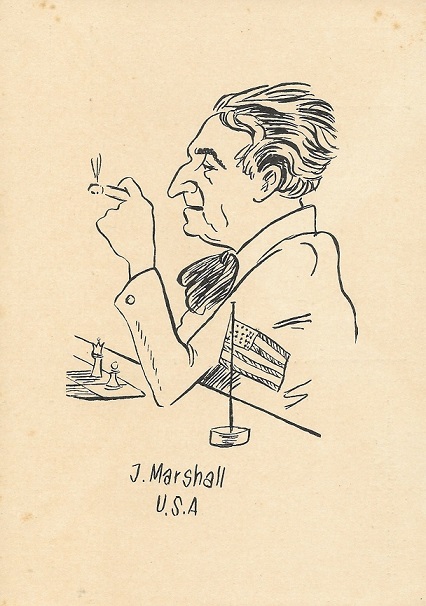
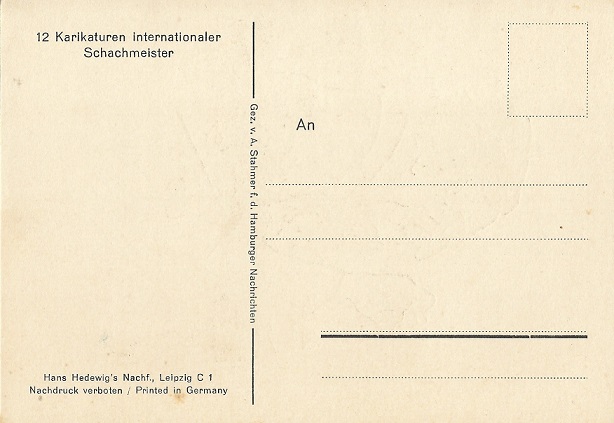
(11894)
See also Chess and Ghostwriting and The Best Chess Games.
Addition on 22 December 2022:
Douglas Griffin (Insch, Scotland) provides (courtesy of the Polish online archive) two shots of Marshall at the 1935 Olympiad in Warsaw:
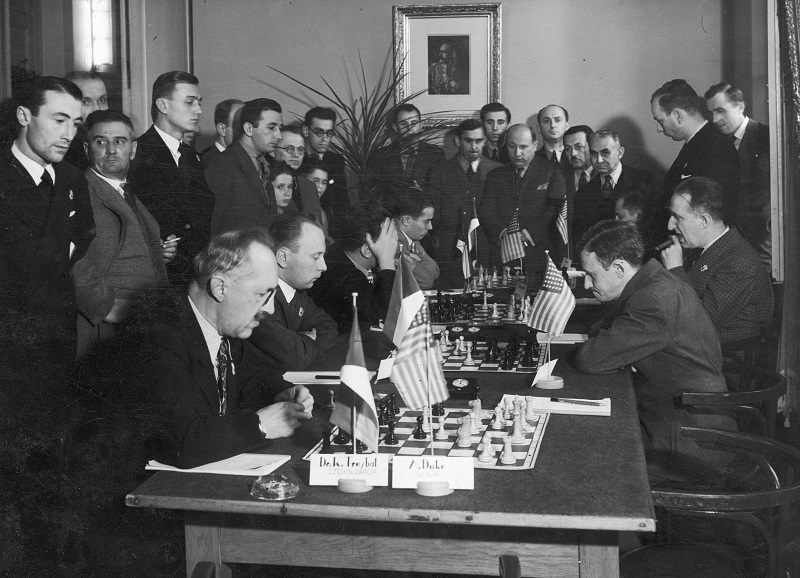
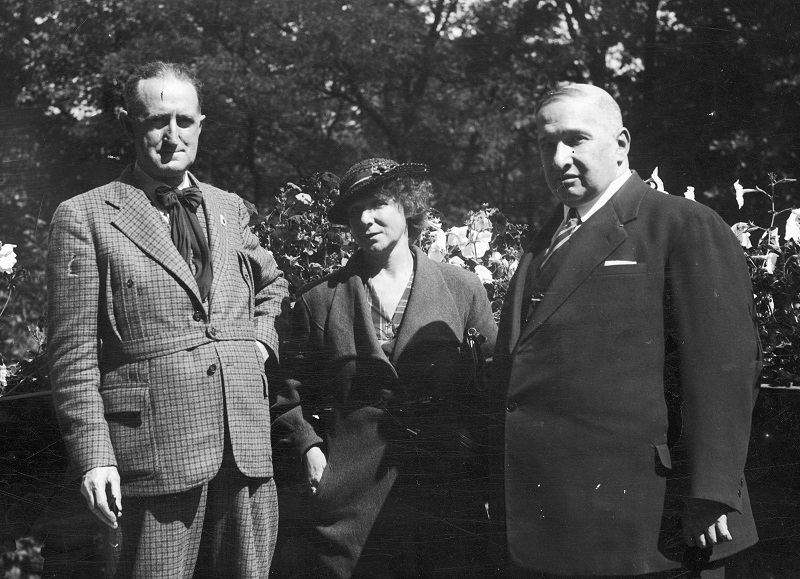
João Pedro S. Mendonça Correia (Lisbon) draws attention to this annotation on page 217 of the Caissa Editions translation (Yorklyn, 1993) of Tarrasch’s book on St Petersburg, 1914 and wonders whether any personal acrimony underlies the reference to billiards:
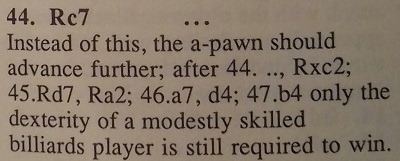
From the original German edition (page 151):
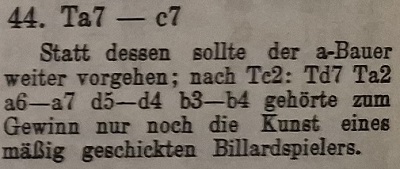
The game was Capablanca v Marshall in round four of the final section: 1 e4 e5 2 Nf3 Nf6 3 Nxe5 d6 4 Nf3 Nxe4 5 Qe2 Qe7 6 d3 Nf6 7 Bg5 Be6 8 Nc3 h6 9 Bxf6 Qxf6 10 d4 Be7 11 Qb5+ Nd7 12 Bd3 g5 13 h3 O-O 14 Qxb7 Rab8 15 Qe4 Qg7 16 b3 c5 17 O-O cxd4 18 Nd5 Bd8 19 Bc4 Nc5 20 Qxd4 Qxd4 21 Nxd4 Bxd5 22 Bxd5 Bf6 23 Rad1 Bxd4 24 Rxd4 Kg7 25 Bc4 Rb6 26 Re1 Kf6 27 f4 Ne6 28 fxg5+ hxg5 29 Rf1+ Ke7 30 Rg4 Rg8 31 Rf5 Rc6 32 h4 Rgc8 33 hxg5 Rc5 34 Bxe6 fxe6 35 Rxc5 Rxc5 36 g6 Kf8 37 Rc4 Ra5 38 a4 Kg7 39 Rc6 Rd5 40 Rc7+ Kxg6 41 Rxa7 Rd1+ 42 Kh2 d5 43 a5 Rc1 44 Rc7 Ra1 45 b4 Ra4 46 c3 d4 47 Rc6 dxc3 48 Rxc3 Rxb4 49 Ra3 Rb7 50 a6 Ra7 51 Ra5 Kf6 52 g4 Ke7 53 Kg3 Kd6 54 Kf4 Kc7 55 Ke5 Kd7 56 g5 Ke7 57 g6 Kf8 58 Kxe6 Ke8 59 g7 Rxg7 60 a7 Rg6+ 61 Kf5 Resigns.
Tarrasch also criticized 46 c3, appending a question mark.
Below is the position after White’s penultimate move, 60 a7:
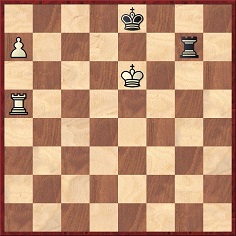
Tarrasch called Marshall’s 60...Rg6+ a Racheschach. It is not a ‘spite check’ strictu sensu, given that two of the three possible king moves by White lose.
(11997)
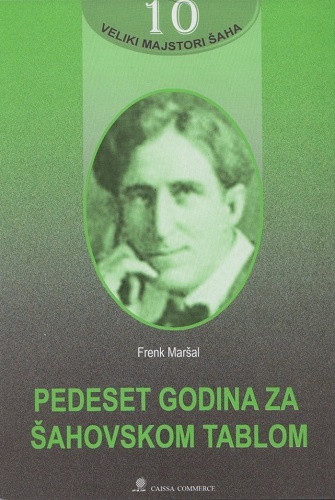
Addition on 1 January 2025:
From Emanuel Lasker’s column on page 9 of the New York Evening Post, 20 July 1907:
‘The exceptional affinity between Marshall, the American chess expert, and the great players of 50 and 100 years ago has been noticed long ago. His style of play is really very modern, but owing to an extraordinarily aggressive tendency, coupled to unsurpassed courage, he scents the earliest possible opportunity for piercing his opponent’s armor. One player may be successful by accumulating small advantages, just as a man might amass a considerable fortune by hard work and frugal living. The games of such a player may be sound and correct, but they will always indicate aims and ambitions which are puny and small. Another player goes to the opposite extreme. He does not deliberately discard small advantages which might accrue, but he searches for something big. His success also bears evidence of grand, lofty and ambitious schemes. The commercial or financial success might be the same whether a man manufactures chewing gum or builds railways. But while the world may look upon the latter as a great man, it never concedes greatness to those who are engaged in small things.
Marshall’s record as a chessplayer is not as good as that of Dr Tarrasch, or of Maróczy, or of Schlechter, but the quality of greatness has been conceded to him. His name has been more associated with Labourdonnais, MacDonnell [sic], Morphy and Andersen [sic] than that of any other living player.’
The ‘Strange as it seems’ feature by John Hix on page 15 of the Omaha World-Herald, 21 April 1931:
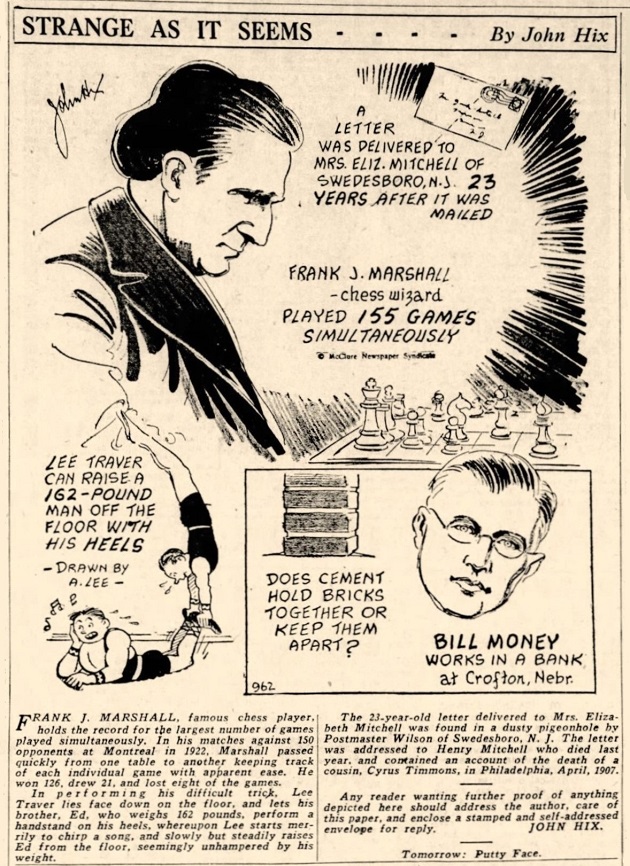
(12120)
To the Chess Notes main page.
To the Archives for other feature articles.
Copyright: Edward Winter. All rights reserved.